SparkLAN Communications WRTR168G Wireless-G AP/Router User Manual
SparkLAN Communications, Inc. Wireless-G AP/Router
User Manual

User’s Manual 1
WRTR-168G
SpeedPlus Wireless-G AP/Router
User’s Manual
Version 1.0

User’s Manual 2
Copyright Statement
No part of this publication may be reproduced, stored in a retrieval system, or
transmitted in any form or by any means, whether electronic, mechanical,
photocopying, recording, or otherwise without the prior writing of the publisher.
JULY 2008

User’s Manual 3
Contents
1. Introduction ................................................................................................4
2. Safety Notification......................................................................................5
3. Hardware Installation .................................................................................6
4. How to Configuring the AP/ Router ........................................................10
4.1 Quick Setup ............................................................................................12
4.2 General Setup.........................................................................................20
4.3 Setup Internet Connection (WAN Setup)..............................................24
4.4 Wired LAN Configuration.......................................................................34
4.5 Wireless LAN Configuration..................................................................38
4.6 Quality of Service (QoS) ........................................................................56
4.7 Network Address Translation (NAT) .....................................................60
4.8 Firewall....................................................................................................68
4.9 System Status.........................................................................................80
4.10 Tools Settings.......................................................................................84
5. Troubleshooting – Q & A .........................................................................87

User’s Manual 4
1. Introduction
Thank you for purchasing your SpeedPlus Wireless-G AP/Router.
This user guide will assist you with the installation procedure.
Package Contents
Please make sure you have the following in the box:
♦ SpeedPlus Wireless-G AP/Router
♦ Quick Installation Guide
♦ User Manual CD-ROM
♦ Universal AC/DC Power Adapter
♦ RJ-45 Network Cable
Note: if anything is missing, please contact your vendor

User’s Manual 5
2. Safety Notification
Your Wireless Router should be placed in a safe and secure location. To ensure proper
operation, please keep the unit away from water and other damaging elements. Please read
the user manual thoroughly before you install the device.
The device should only be repaired by authorized and qualified engineer.
※ Please do not try to open or repair the device yourself.
※ Do not place the device in a damp or humid location, i.e. a bathroom.
※ The device should be placed in a sheltered and non-slip location within a temperature
range of +5 to +40 Celsius degree.
※ Please do not expose the device to direct sunlight or other heat sources. The housing
and electronic components may be damaged by direct sunlight or heat sources.

User’s Manual 6
3. Hardware Installation
Front Panel
The front panel provides LED’s for device status. Refer to the following table for the
meaning of each feature.
LED Name Light Status Description
PWR On Router is switched on and correctly powered.
On Wireless WPS function is enabled.
Off Wireless network is switched off.
WLAN Flashing Wireless LAN activity (transferring or receiving
data).
On WAN port (Internet) is running at 100Mbps.
Off WAN port (Internet) is running at 10Mbps.
WAN
10/100M Flashing WAN activity (transferring or receiving data).
On WAN port is connected.
Off WAN port is not connected.
WAN
LNK/ACT Flashing WAN activity (transferring or receiving data).
On LAN port is running at 100Mbps. LAN
10/100M Off LAN port is running at 10Mbps.
On LAN port is connected.
Off LAN port is not connected.
LAN
LNK/ACT Flashing LAN activity (transferring or receiving data).

User’s Manual 7
Rear Panel
The rear panel features 4 LAN ports, 1 WAN port and Reset/WPS button. Refer to the
following table for the meaning of each feature.
Power The POWER port is where you will connect the power adapter.
WAN The WAN port is where you will connect your broadband Internet connection.
LAN
1,2,3,4
These ports (1, 2, 3, 4) connect the Router to your networked PCs and other
Ethernet network devices.
RESET/WPS
Reset the router to factory default settings (clear all settings) or start WPS
function. Press this button and hold for 10 seconds to restore all settings to
factory defaults, and press this button for less than 5 seconds to start WPS
function.

User’s Manual 8
AP Router Default Settings
User admin
Password 1234
IP Address 192.168.2.1
Subnet Mask 255.255.255.0
RF ESSID default
Channel 11
Radio Band Wide (Full speed to 300Mbps)
Mode BGN Mixed
Encryption Disabled
WPS Function Enabled
DHCP Server Enabled

User’s Manual 9
Hardware Installation for Connection to Your Broadband Modem
1. Power off your network devices.
2. Locate an optimum location for the Router. The best place for the Router is usually at
the center of your wireless network, with line of sight to all of your wireless devices.
3. Adjust the antennas. Normally, higher location of your Router will get better
performance.
4. Using a standard Ethernet network cable, connect the Router’s Internet port to your
broadband modem.
5. Connect your network PCs or Ethernet devices to the Router’s LAN ports using
standard Ethernet network cable.
6. Connect the AC power adapter to the Router's Power port. Then connect the other end
to an electrical outlet. Only use the power adapter supplied with the Router. Use of a
different adapter may cause product damage.
7. The Hardware installation is complete; please refer to the following content for Router
configuration.
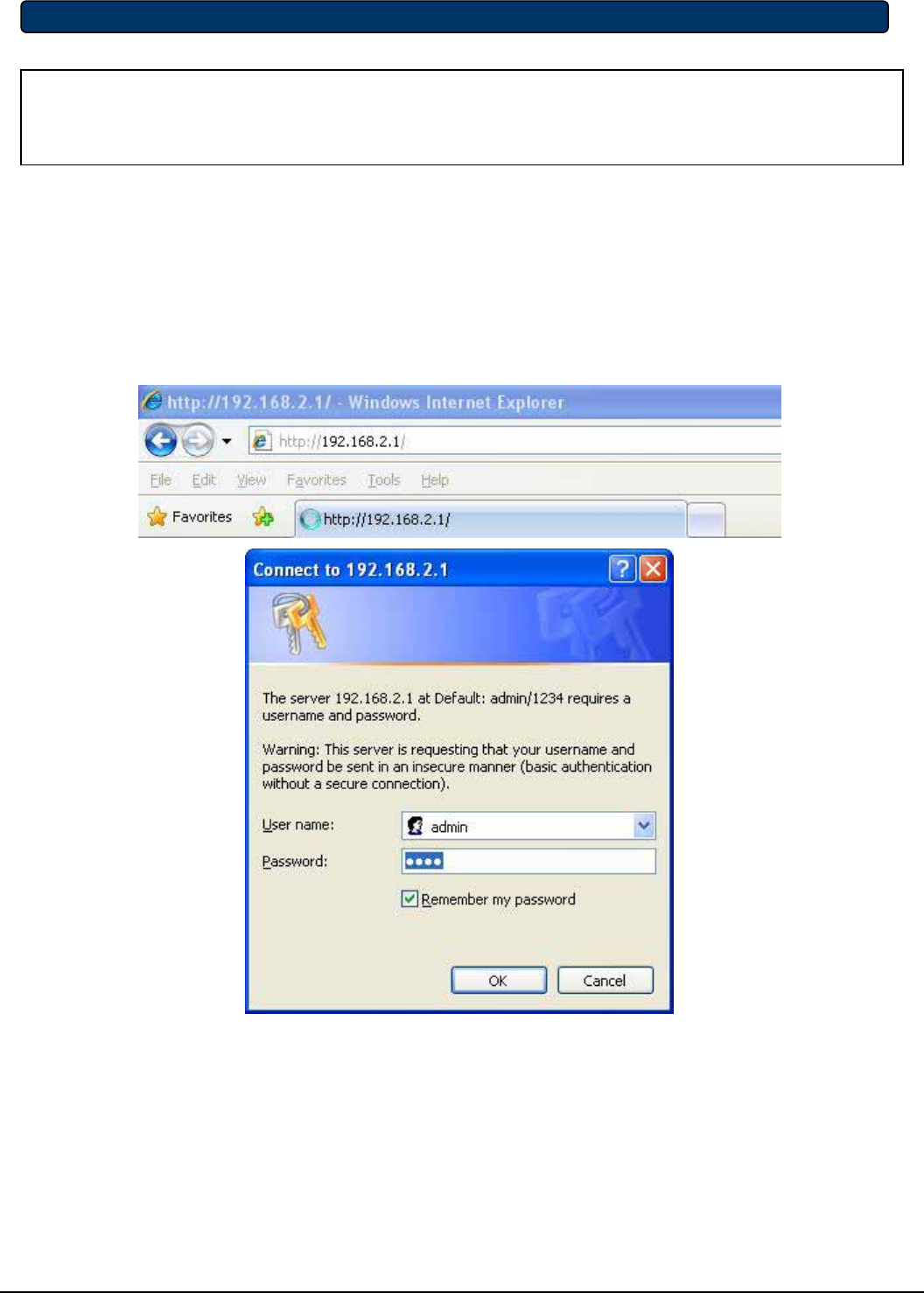
User’s Manual 10
4. How to Configuring the AP/ Router
START UP & LOGIN
In order to configure the SpeedPlus Wireless-G AP/Router, you must use web browser and
manually input http://192.168.2.1 into the Address box and press Enter. The Main Page will
appear.
In order to configure the SpeedPlus Wireless-G AP/Router, you must input the password
into the Password box and leave blank on the User Name box. The default User name is
“admin” and password is “1234”.
TURN ON POWER SUPPLY
Quick power cycle would cause system corruption. When power on, be careful not to shut
down in about 5 seconds, because data is writing to the flash.

User’s Manual 11
Once you have logged-in as administrator, it is a good idea to change the administrator
password to ensure a secure protection to the SpeedPlus Wireless-G AP/Router. The
Security Settings section described later in this manual describes how to change the
password.
Once you have input the correct password and logged-in, the screen will change to the
setup page screen.
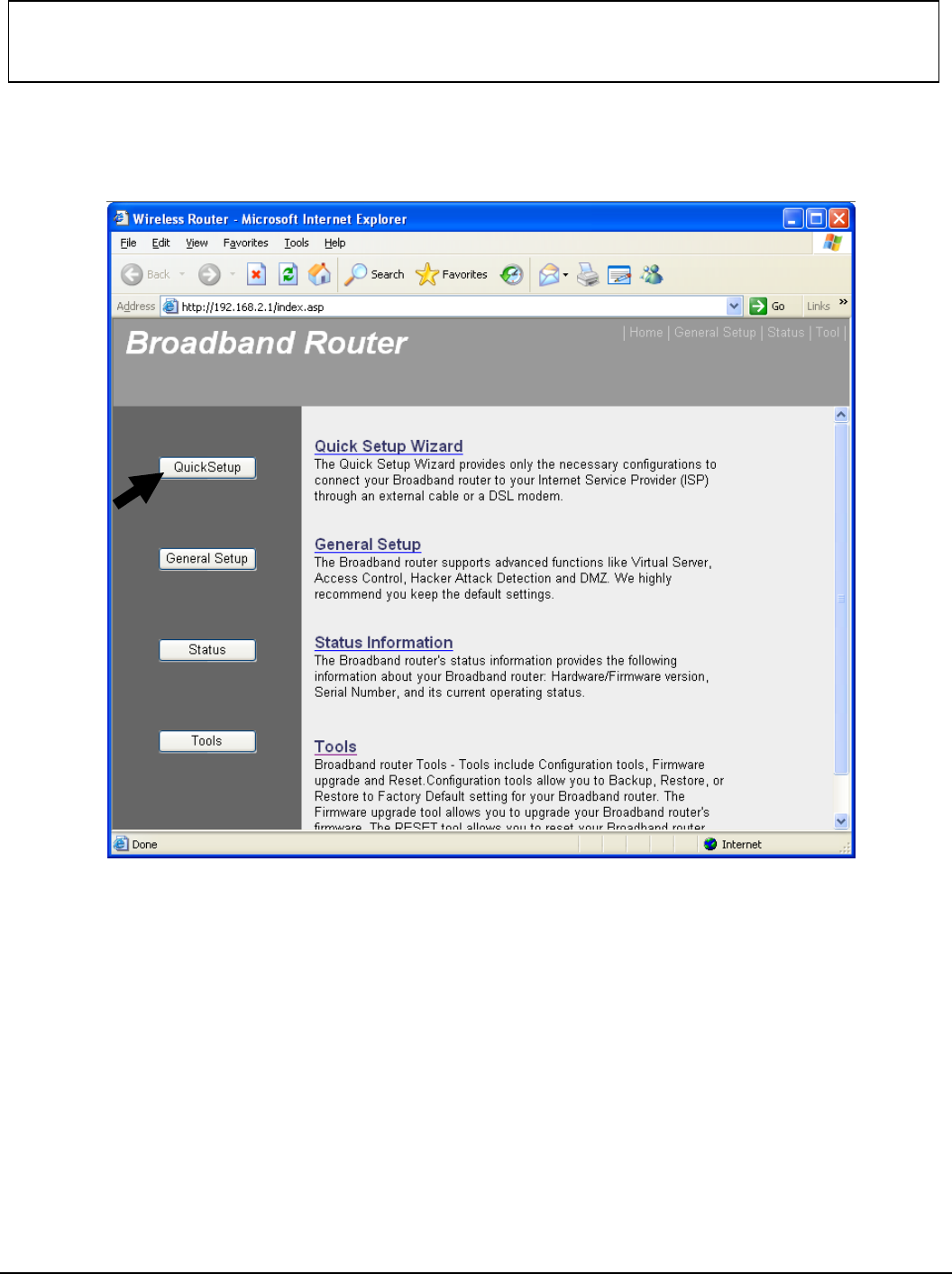
User’s Manual 12
4.1 Quick Setup
Please go to Quick Setup menu by clicking ‘Quick Setup’ button.
Most users will be able to configure the AP Router and get it working properly using the
settings on this screen. Some Internet Service Providers (ISPs) will require that you enter
broadband specific information into this device, such as User Name, Password, IP Address,
Default Gateway Address, or DNS IP Address for Internet access. This information can be
obtained from your ISP, if required.
And the following message will be displayed:
MAKE CORRECT NETWORK SETTINGS OF YOUR COMPUTER
To change the configuration, use Internet Explorer (IE) or Netscape Communicator to connect
the WEB mana
g
ement 192.168.2.1.
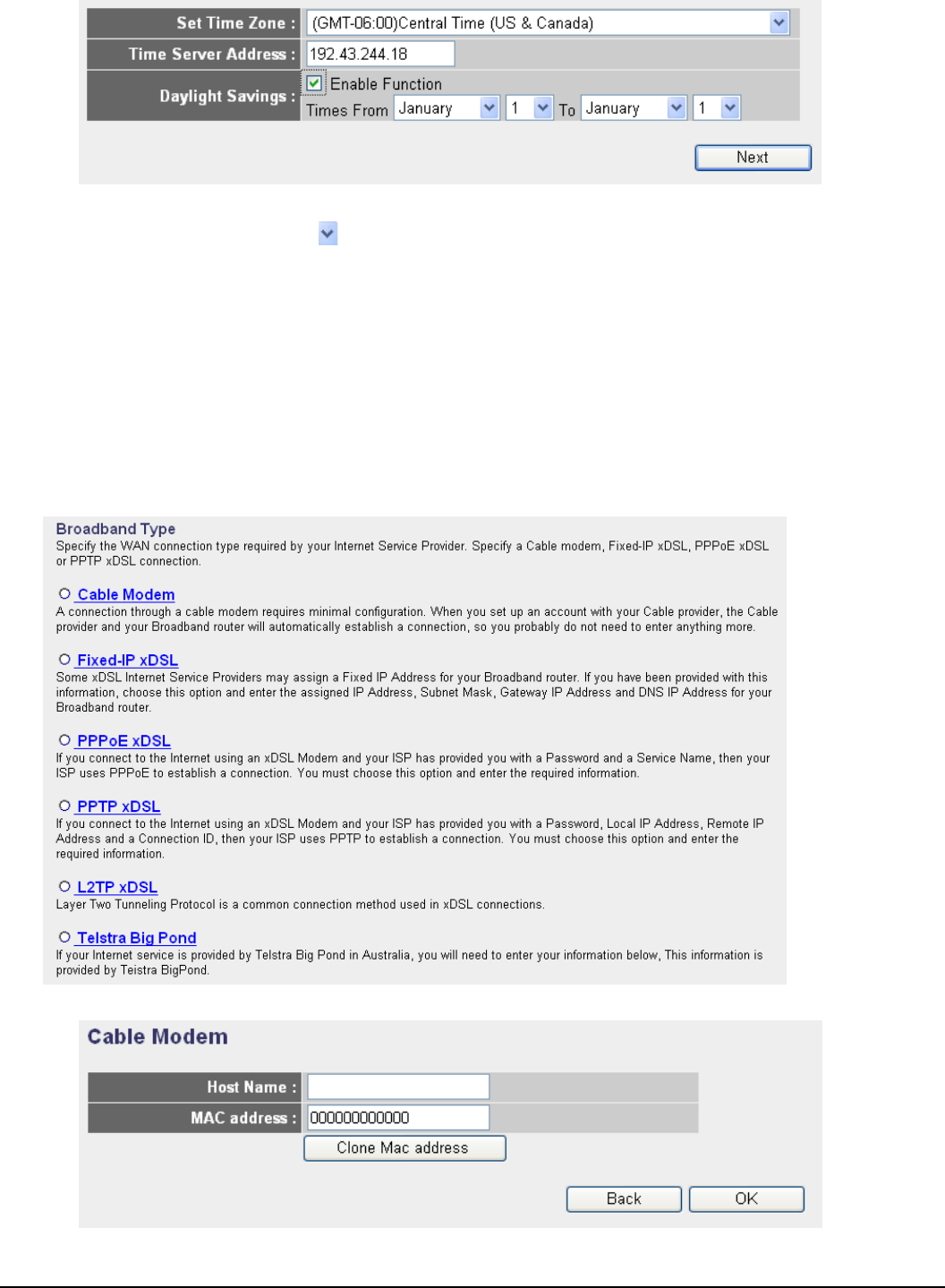
User’s Manual 13
Set Time Zone
Here are descriptions of every setup items:
Set Time Zone: Please press button, a drop-down list will be shown, and you can choose
a time zone of the location you live.
Time Server Address: Input the IP address / host name of time server here
Daylight Savings: If the country you live uses daylight saves, please check ‘Enable
Function’ box, and choose the duration of day light saving.
After you finish with all settings, please click ‘Next’ button.
Broadband Type
Setup procedure for ‘Cable Modem’:
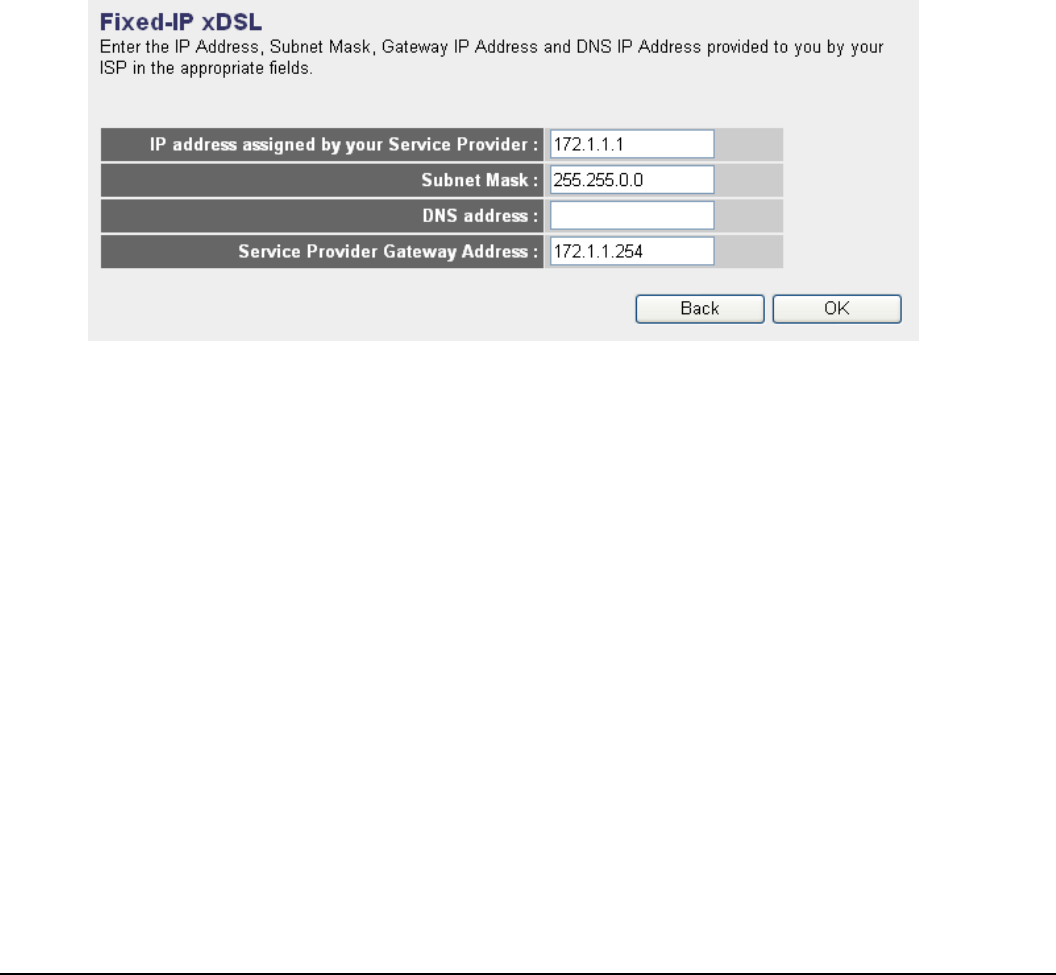
User’s Manual 14
Host Name:
Please input the host name of your computer, this is optional, and only required if your
service provider asks you to do so.
MAC address:
Please input MAC address of your computer here, if your service provider only permits
computer with certain MAC address to access internet. If you’re using the computer which
used to connect to Internet via cable modem, you can simply press ‘Clone Mac address’
button to fill the MAC address field with the MAC address of your computer.
After you finish with all settings, please click ‘OK’ button; if you want to go back to
previous menu, click ‘Back’.
Setup procedure for ‘Fixed-IP xDSL’:
IP address assigned by your Service Provider:
Please input IP address assigned by your service provider.
Subnet Mask:
Please input subnet mask assigned by your service provider.
DNS address:
Please input the IP address of DNS server provided by your service provider.
Service Provider Gateway Address:
Please input the IP address of DNS server provided by your service provider.
After you finish with all settings, please click ‘OK’ button; if you want to go back to
previous menu, click ‘Back’
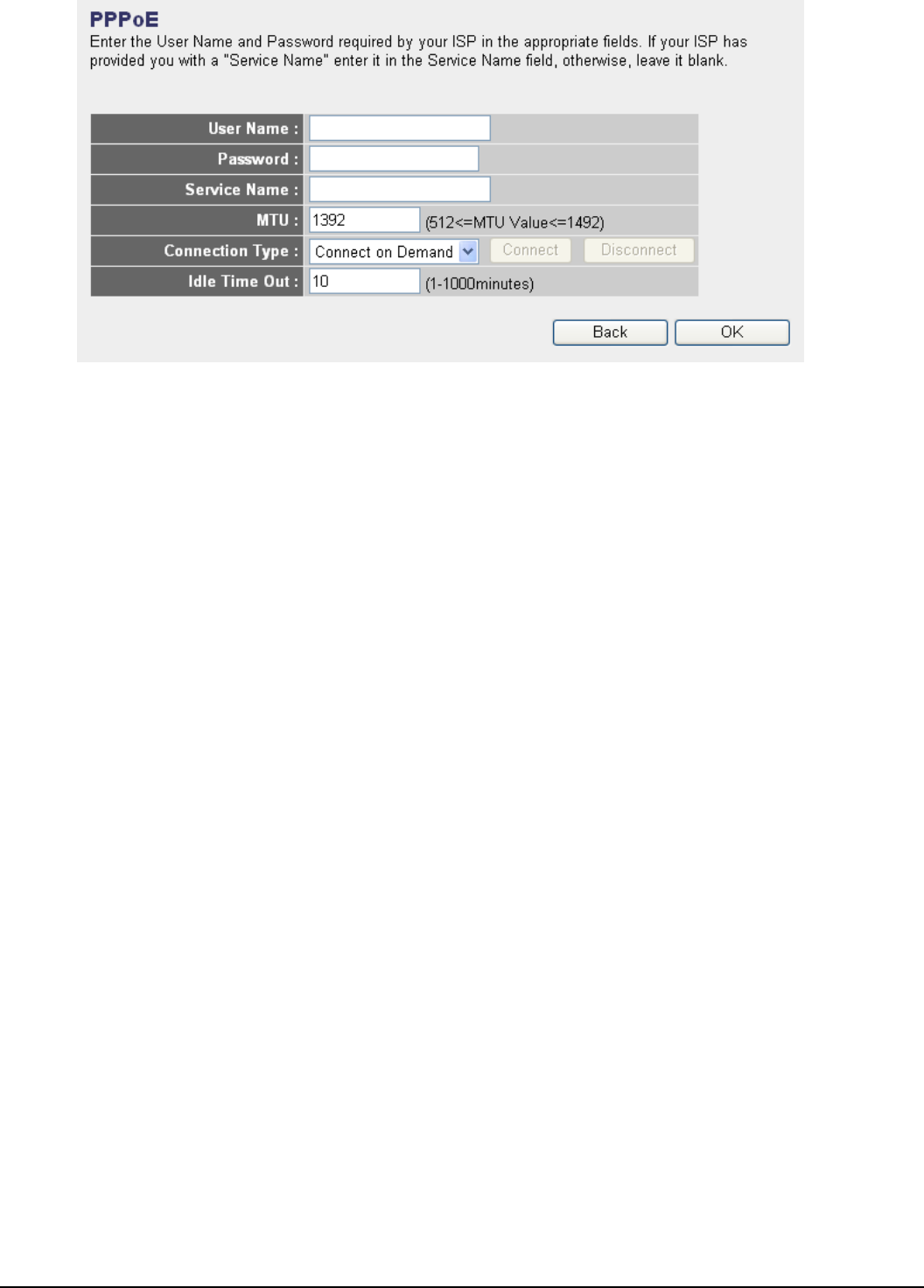
User’s Manual 15
Setup procedure for ‘PPPoE xDSL’:
User Name:
Please input user name assigned by your Internet service provider here.
Password:
Please input the password assigned by your Internet service provider here.
Service Name:
Please give a name to this Internet service, this is optional.
MTU:
Please input the MTU value of your network connection here. If you don’t know, you can use
default value.
Connection Type:
Please select the connection type of Internet connection you wish to use (detailed
explanation listed below).
Idle Time Out:
Please input idle time out, (detailed explanation listed below).
After you finish with all settings, please click ‘OK’ button; if you want to go back to
previous menu, click ‘Back’
Setup procedure for ‘PPTP xDSL’:
PPTP xDSL requires two kinds of setting: WAN interface setting (setup IP address) and
PPTP setting (PPTP user name and password). Here we start from WAN interface setting:
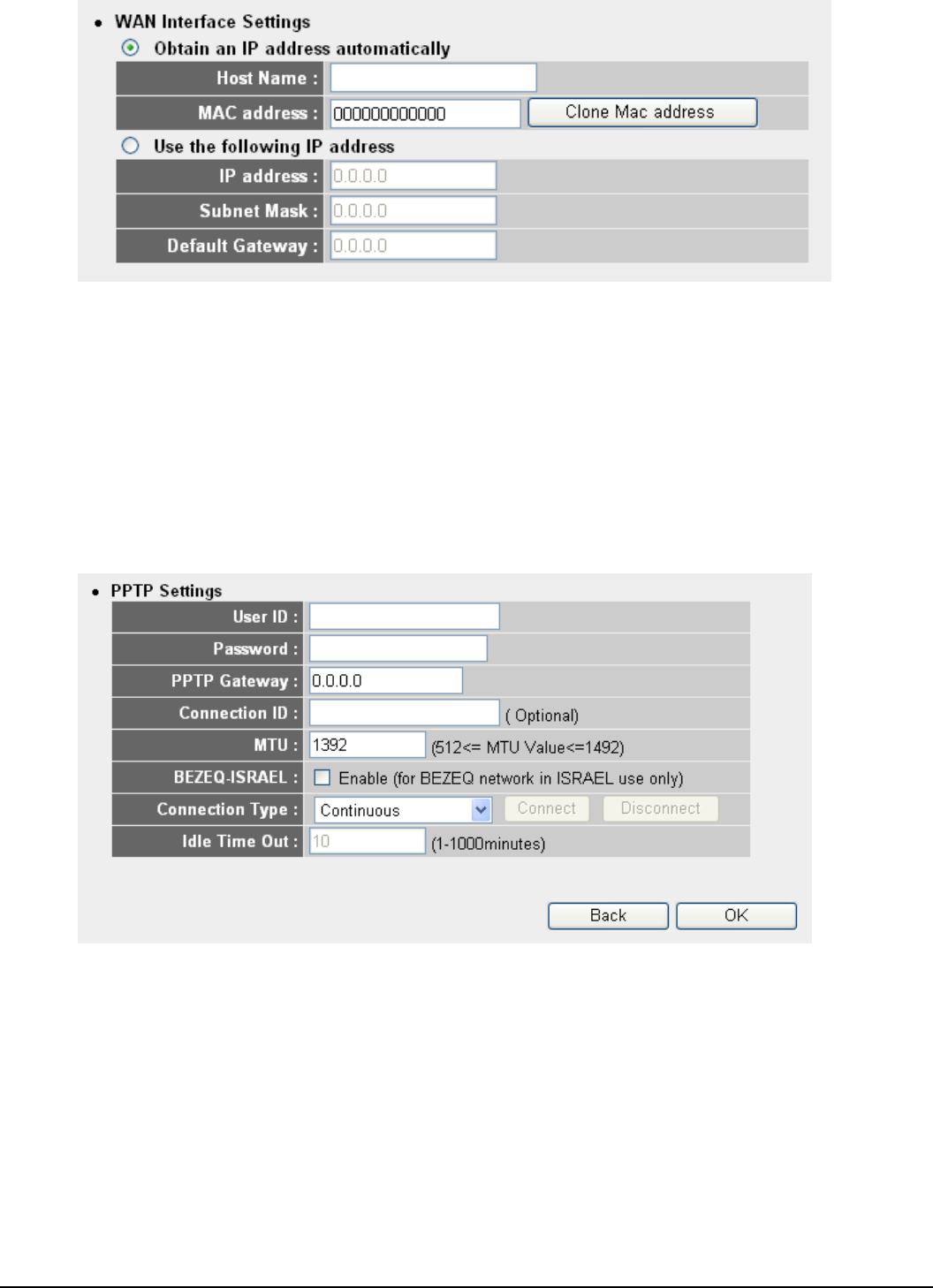
User’s Manual 16
Select the type of how you obtain IP address from your service provider here. You can
choose ‘Obtain an IP address automatically’ (equal to DHCP, please refer to ‘Cable Modem’
section above), or ‘Use the following IP address’ (i.e. static IP address).
WAN interface settings must be correctly set, or the Internet connection will fail even those
settings of PPTP settings are correct. Please contact your Internet service provider if you
don’t know what you should fill in these fields.
Now please go to PPTP settings section:
User ID:
Please input user ID (user name) assigned by your Internet service provider here.
Password:
Please input the password assigned by your Internet service provider here.
PPTP Gateway:
Please input the IP address of PPTP gateway assigned by your Internet service provider
here.
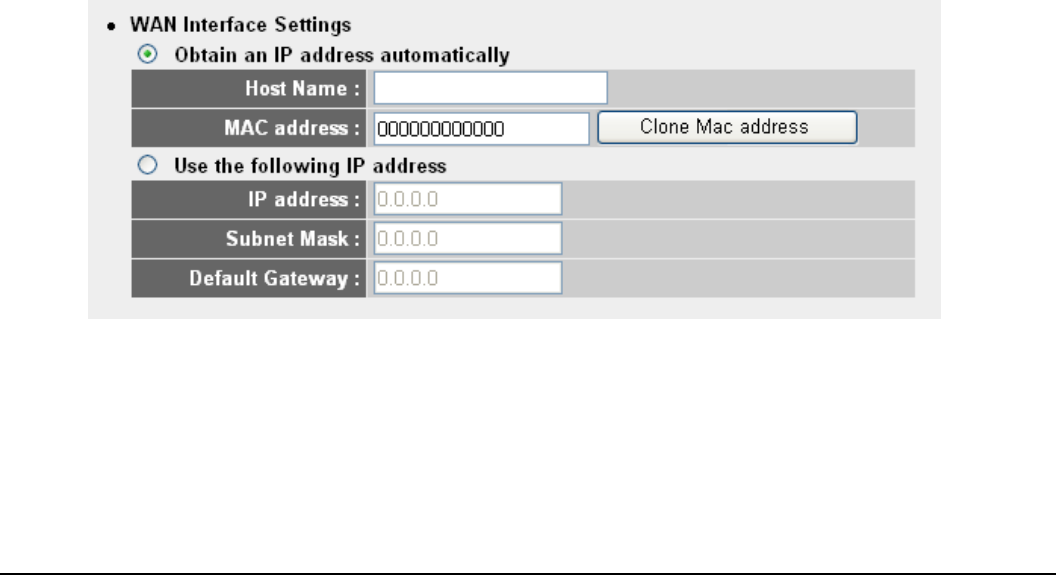
User’s Manual 17
Connection ID:
Please input the connection ID here, this is optional and you can leave it blank.
MTU:
Please input the MTU value of your network connection here. If you don’t know, you can use
default value.
BEZEQ-ISRAEL:
Setting item ‘BEZEQ-ISRAEL’ is only required to check if you’re using the service provided
by BEZEQ network in Israel.
Connection type:
Please select the connection type of Internet connection you wish to use, please refer to last
section for detailed descriptions.
Idle Time Out:
Please input the idle time out of Internet connection you wish to use, and refer to last section
for detailed descriptions.
After you finish with all settings, please click ‘OK’ button; if you want to go back to
previous menu, click ‘Back’
Setup procedure for ‘L2TP xDSL’:
L2TP is another popular connection method for xDSL and other Internet connection types,
and all required setting items are the same with PPTP connection.
Like PPTP, there are two kinds of required setting, we’ll start from ‘WAN Interface Settings’:
Please select the type of how you obtain IP address from your service provider here. You
can choose ‘Obtain an IP address automatically’ (equal to DHCP, please refer to ‘Cable
Modem’ section above), or ‘Use the following IP address’ (equal to static IP address, please
refer to ‘PPPoE xDSL’ section above).
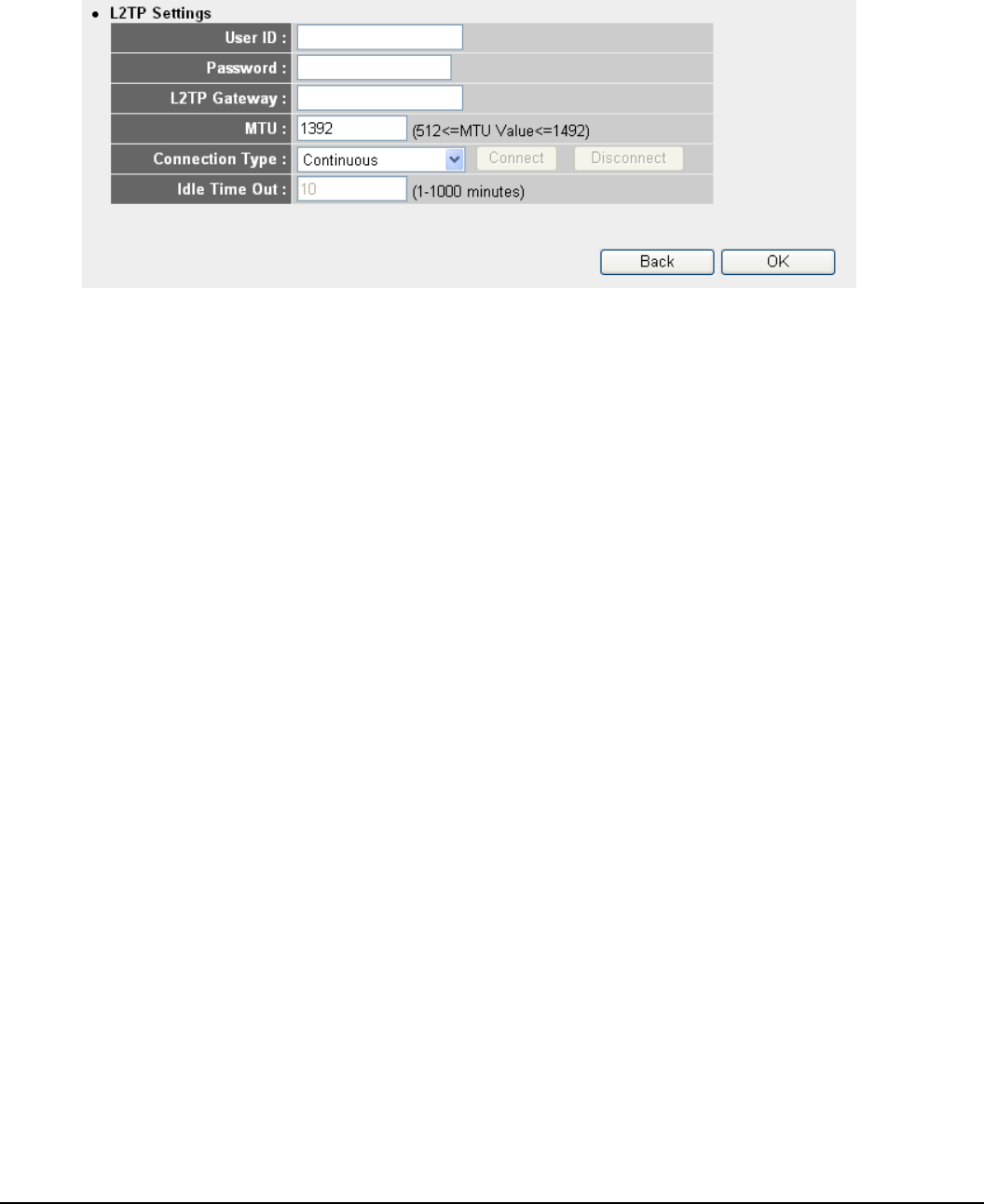
User’s Manual 18
WAN interface settings must be correctly set, or the Internet connection will fail even those
settings of PPTP settings are correct. Please contact your Internet service provider if you
don’t know what you should fill in these fields.
Now please go to L2TP settings section:
User ID:
Please input user ID (user name) assigned by your Internet service provider here.
Password:
Please input the password assigned by your Internet service provider here.
L2TP Gateway:
Please input the IP address of PPTP gateway assigned by your Internet service provider
here.
MTU:
Please input the MTU value of your network connection here. If you don’t know, you can use
default value.
Connection type:
Please select the connection type of Internet connection you wish to use, please refer to last
section for detailed descriptions.
Idle Time Out:
Please input the idle time out of Internet connection you wish to use, and refer to last
section for detailed descriptions.
After you finish with all settings, please click ‘OK’ button; if you want to go back to
previous menu, click ‘Back’
Setup procedure for ‘Telstra Big Pond’:
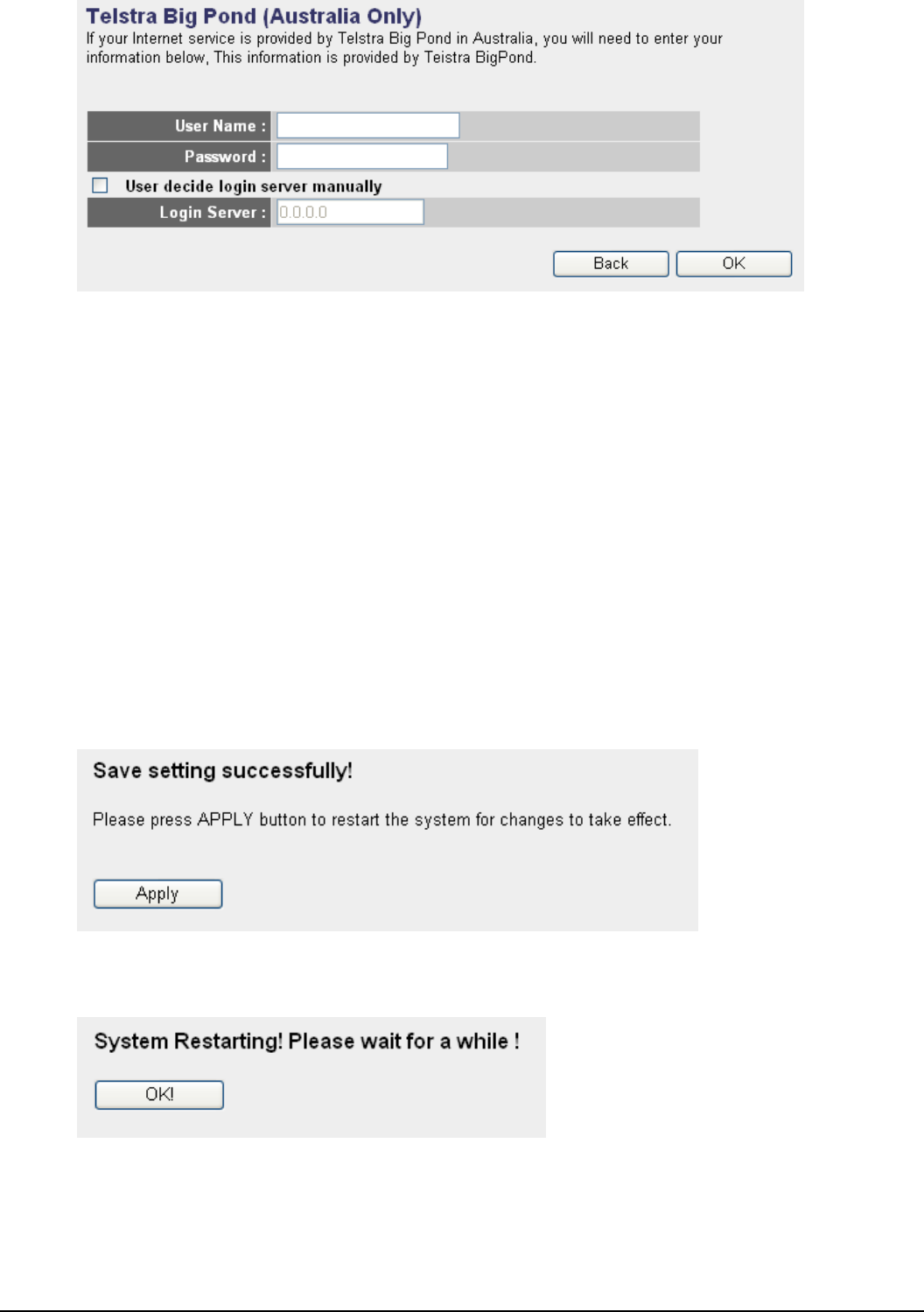
User’s Manual 19
User Name:
Please input the user name assigned by Telstra.
Password:
Please input the password assigned by Telstra.
User device login server manually:
Check this box to choose login server by yourself.
Login Server:
Please input the IP address of login server here.
After you finish with all settings, please click ‘OK’ button; if you want to go back to
previous menu, click ‘Back’
When all settings are finished, you’ll see the following message displayed on your
web browser:
Please click ‘Apply’ button to prepare to restart the router, and you’ll see this
message:
Please wait for about 30 seconds, then click ‘OK!’ button. You’ll be back to router
management interface again, and the router is ready with new settings.
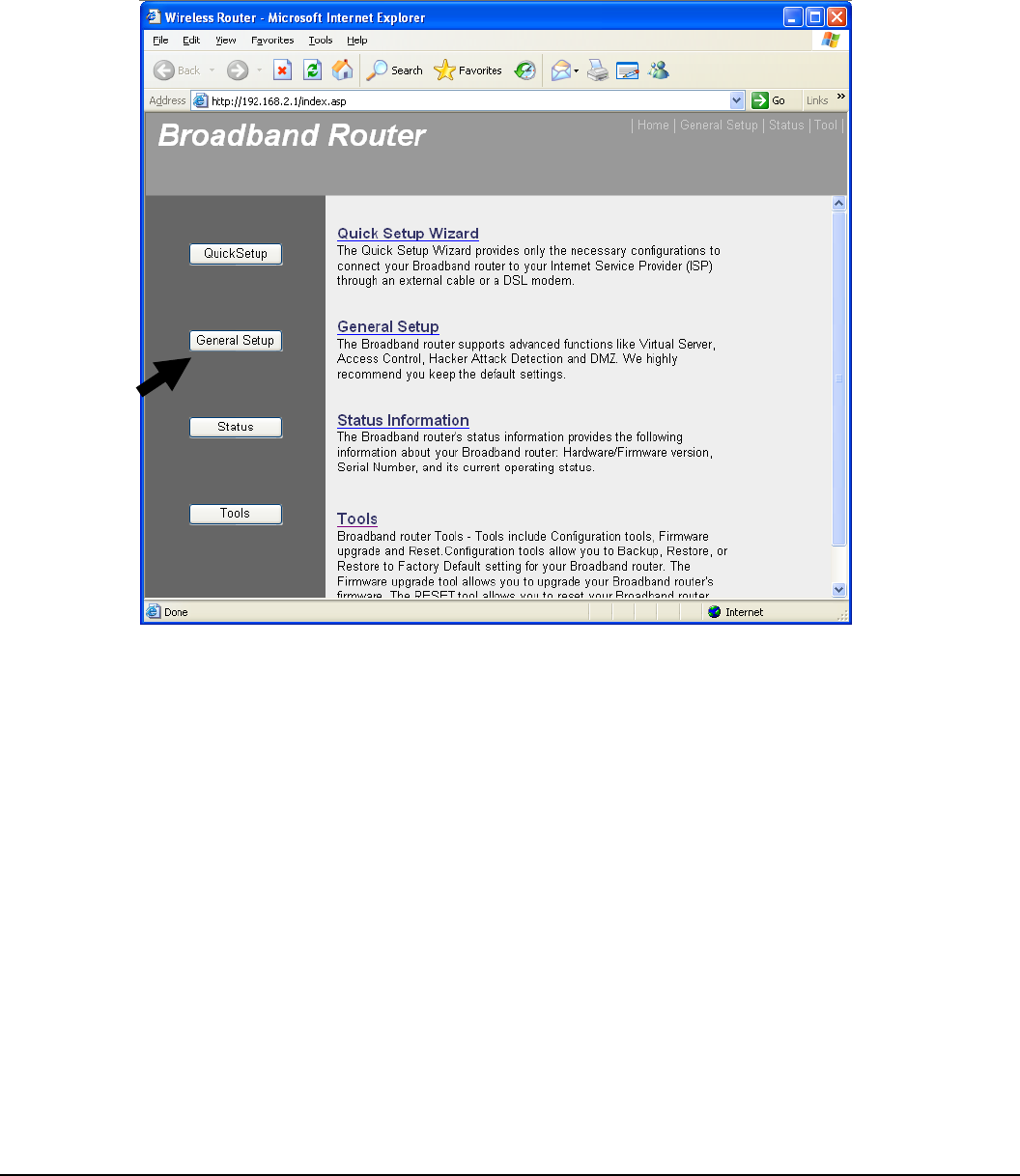
User’s Manual 20
4.2 General Setup
In this chapter, you’ll know how to change the time zone, password, and remote
management settings. Please start your web browser and log onto router web management
interface, then click ‘General Setup’ button on the left, or click ‘General Setup’ link at the
upper-right corner of web management interface.
Time zone and time auto-synchronization:
Please follow the following instructions to set time zone and time auto-synchronization
parameters:
Please click ‘System’ menu on the left of web management interface, then click ‘Time Zone’,
and the following message will be displayed on your web browser: Please select time zone
at ‘Set time zone’ drop-down list, and input the IP address or host name of time server. If you
want to enable daylight savings setting, please check ‘Enable Function’ box, and set the
duration of daylight setting. When you finish, click ‘Apply’. You’ll see the following message
displayed on web browser:
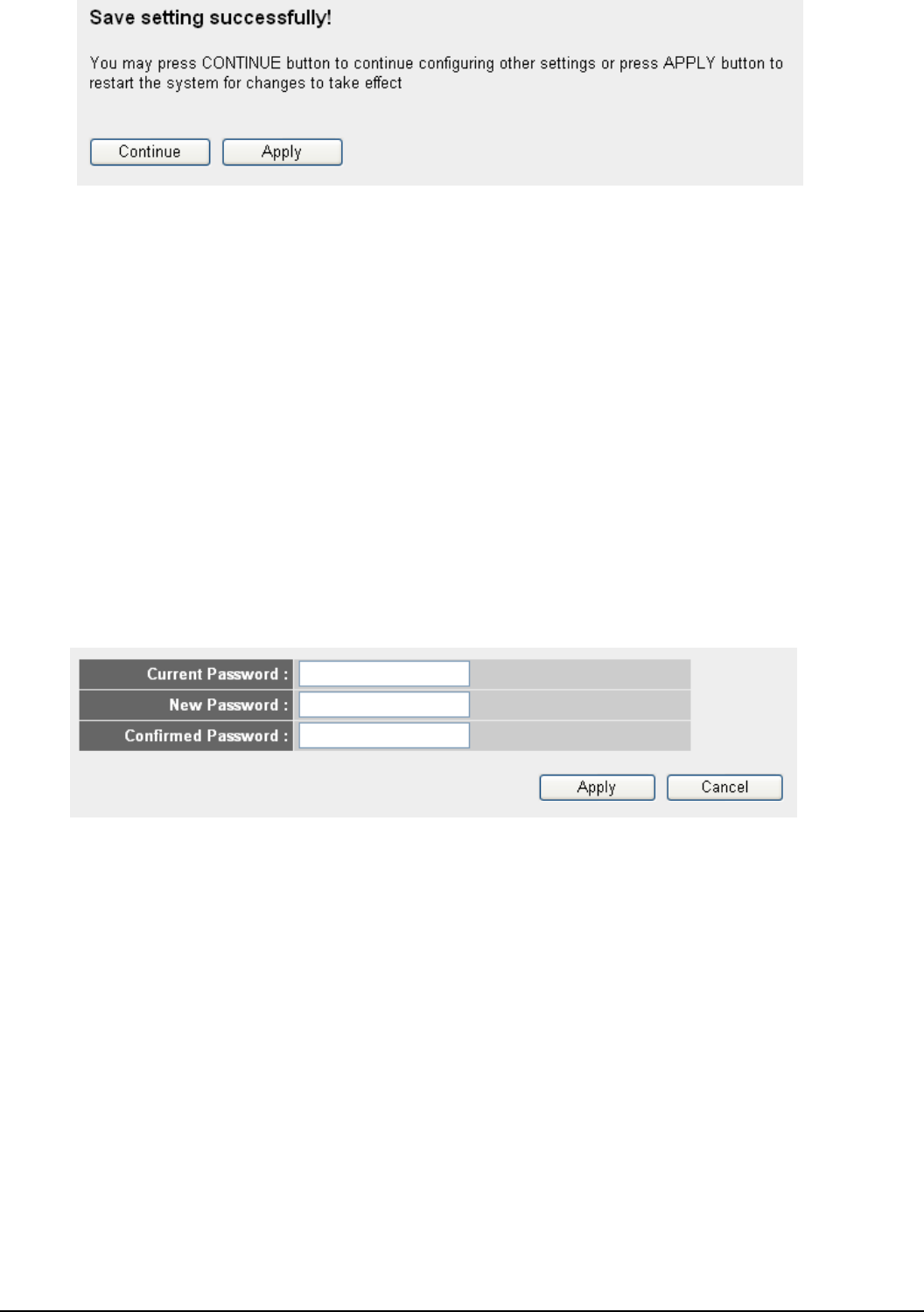
User’s Manual 21
Press ‘Continue’ to save the settings made and back to web management interface; press
‘Apply’ to save the settings made and restart the router so the settings will take effect after it
reboots.
Change management password:
Default password of this router is 1234, and it’s displayed on the login prompt when
accessed from web browser. There’s a security risk if you don’t change the default password,
since everyone can see it. This is very important when you have wireless function enabled.
To change password, please follow the following instructions:
Please click ‘System’ menu on the left of web management interface, then click ‘Password
Settings’, and the following message will be displayed on your web browser:
Here are descriptions of every setup items:
Current Password:
Please input current password here.
New Password:
Please input new password here.
Confirmed Password:
Please input new password here again.
When you finish, click ‘Apply’. If you want to keep original password unchanged, click
‘Cancel’.
If the password you typed in ‘New Password’ (2) and ‘Confirmed Password’ (3) field are not
the same, you’ll see the following message:
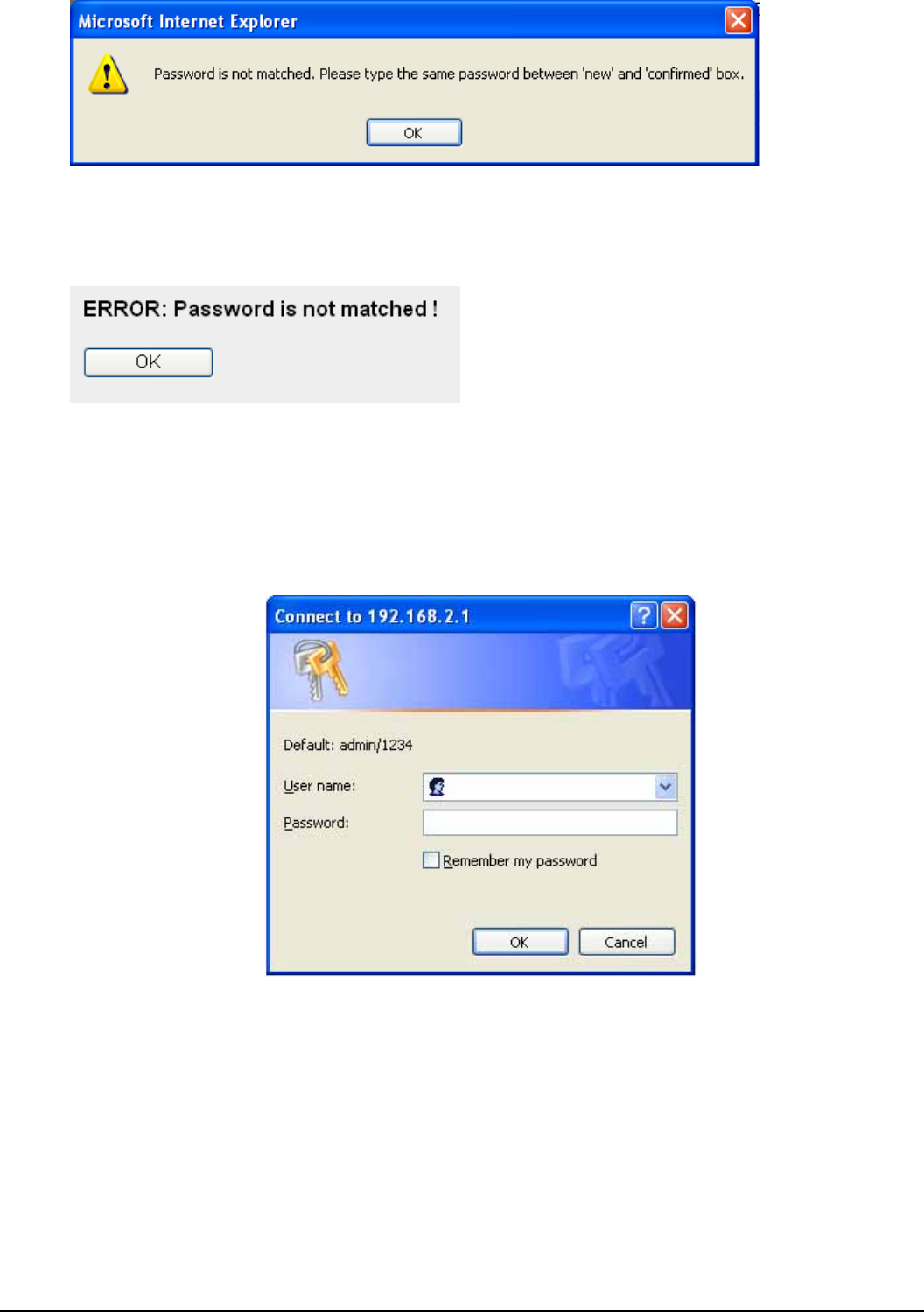
User’s Manual 22
Please retype the new password again when you see above message.
If you see the following message:
It means the content in ‘Current Password’ field is wrong, please click ‘OK’ to go back to
previous menu, and try to input current password again.
If the current and new passwords are correctly entered, after you click ‘Apply’, you’ll be
prompted to input your new password:
Please use new password to enter web management interface again, and you should
be able to login with new password.
Remote Management
This router does not allow management access from Internet, to prevent possible security
risks (especially when you defined a weak password, or didn’t change default password).
However, you can still management this router from a specific IP address by enabling the
‘Remote Management’ Function.
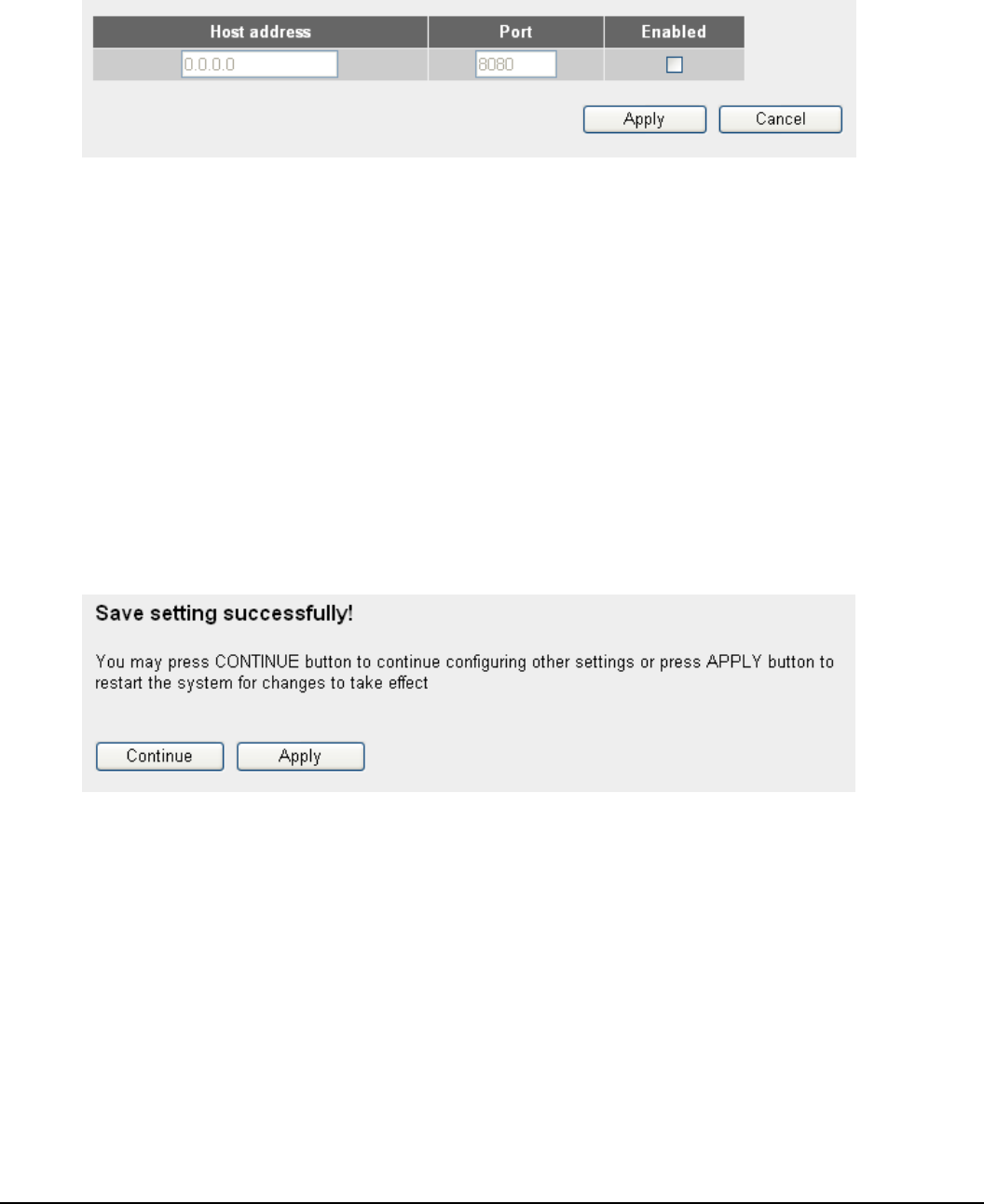
User’s Manual 23
To do so, please follow the following instructions:
Please click ‘System’ menu on the left of web management interface, then click ‘Remote
Management’, and the following message will be displayed on your web browser:
Host Address:
Input the IP address of the remote host you wish to initiate a management access.
Port:
You can define the port number this router should expect an incoming request. If you’re
providing a web service (default port number is 80), you should try to use other port number.
You can use the default port setting ‘8080’, or something like ‘32245’ or ‘1429’. (Any integer
between 1 and 65534)
Enabled:
Select the field to start the configuration.
When you finish, click ‘Apply’. If you want to keep original password unchanged, click
‘Cancel’.
Press ‘Continue’ to save the settings made and back to web management interface; press
‘Apply’ to save the settings made and restart the router so the settings will take effect after it
reboots.
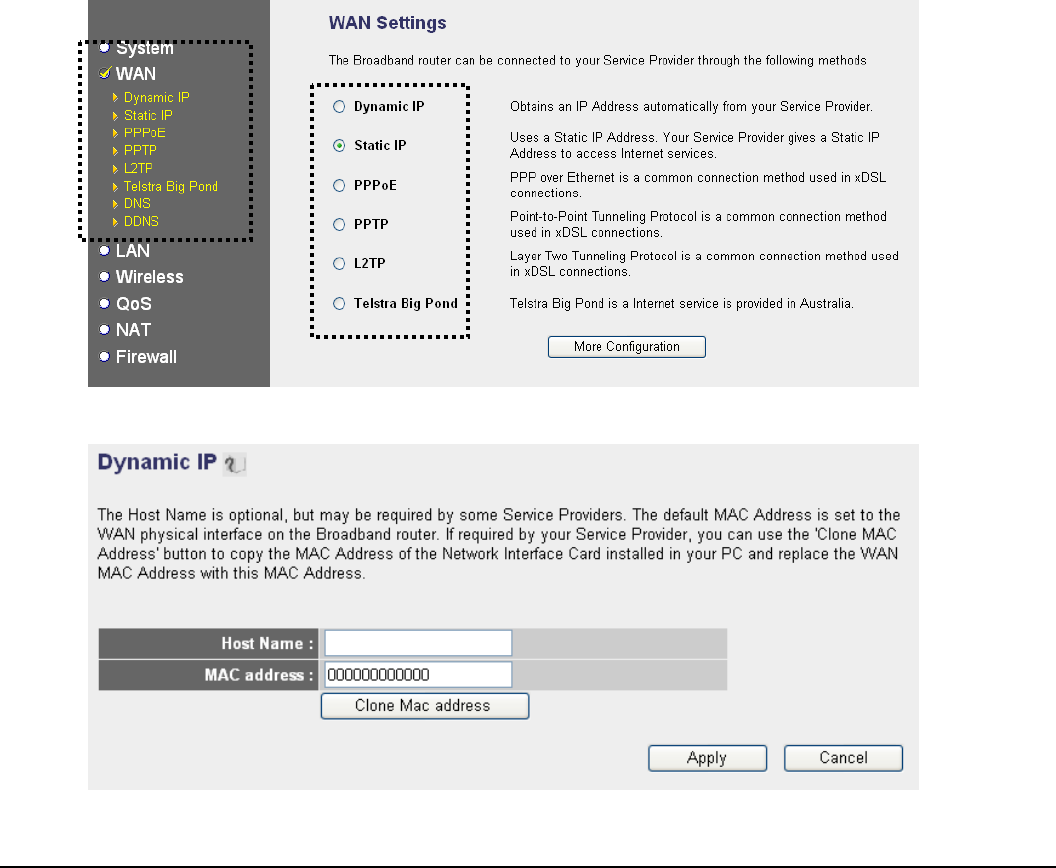
User’s Manual 24
4.3 Setup Internet Connection (WAN Setup)
Internet connections setup can be done by using ‘Quick Setup’ menu described in chapter 4-
1. However, you can setup WAN connections up by using WAN configuration menu. You can
also set advanced functions like DDNS (Dynamic DNS) here.
To start configuration, please follow the following instructions:
Please click ‘WAN’ menu on the left of web management interface, and the following
message will be displayed on your web browser:
Please select an Internet connection method depend on the type of connection you’re using.
You can either click the connection method on the left (1) or right (2). If you select the
connection method on the right, please click ‘More Configuration’ button after a method is
selected.
Setup procedure for ‘Dynamic IP’:
2
1
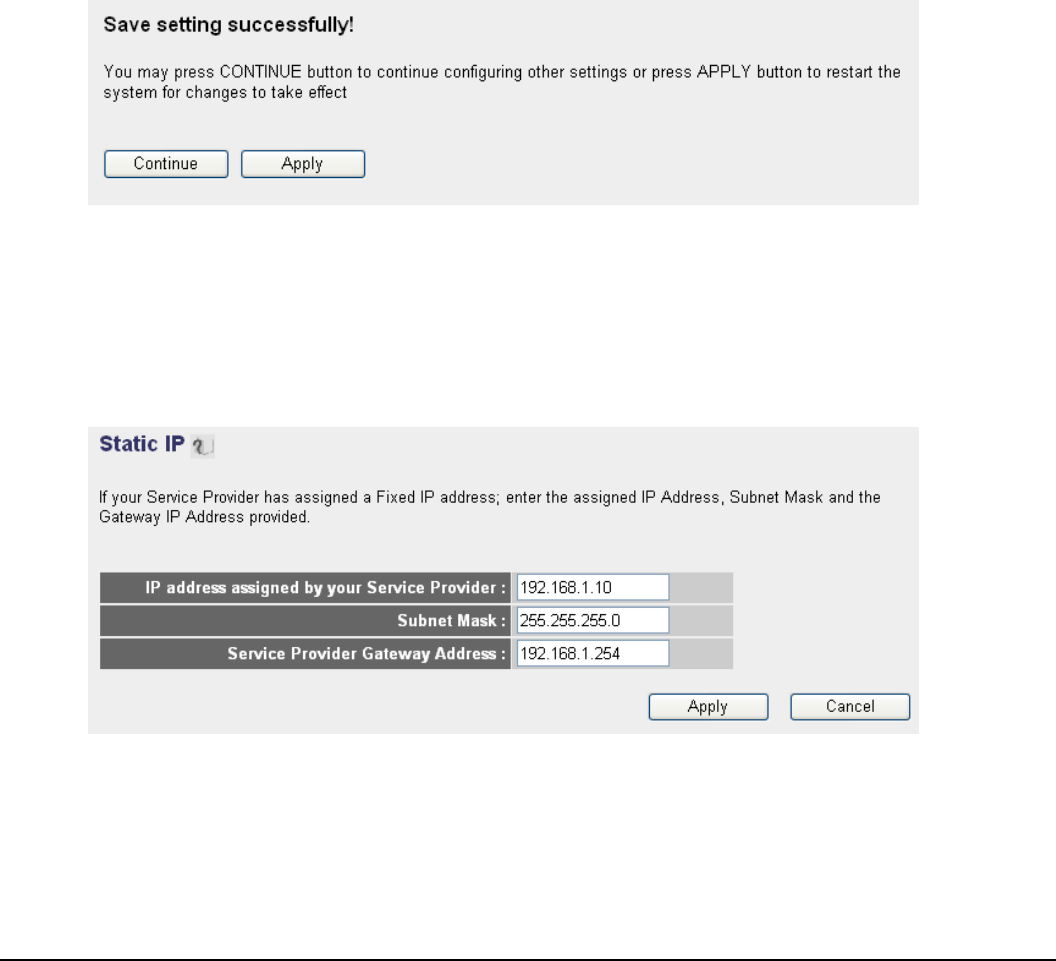
User’s Manual 25
Host Name:
Please input the host name of your computer, this is optional, and only required if your
service provider asks you to do so.
MAC address:
Please input MAC address of your computer here, if your service provider only permits
computer with certain MAC address to access internet. If you’re using the computer which
used to connect to Internet via cable modem, you can simply press ‘Clone Mac address’
button to fill the MAC address field with the MAC address of your computer.
After you finish with all settings, please click ‘Apply’; if you want to remove and value
you entered, please click ‘Cancel’.
After you click ‘Apply’, the following message will be displayed on your web browser:
Please click ‘Continue’ to back to previous setup menu; to continue on router setup, or click
‘Apply’ to reboot the router so the settings will take effect (Please wait for about 30 seconds
while router is rebooting).
Setup procedure for ‘Static IP’:
IP address assigned by your Service Provider:
Please input IP address assigned by your service provider.
Subnet Mask:
Please input subnet mask assigned by your service provider.
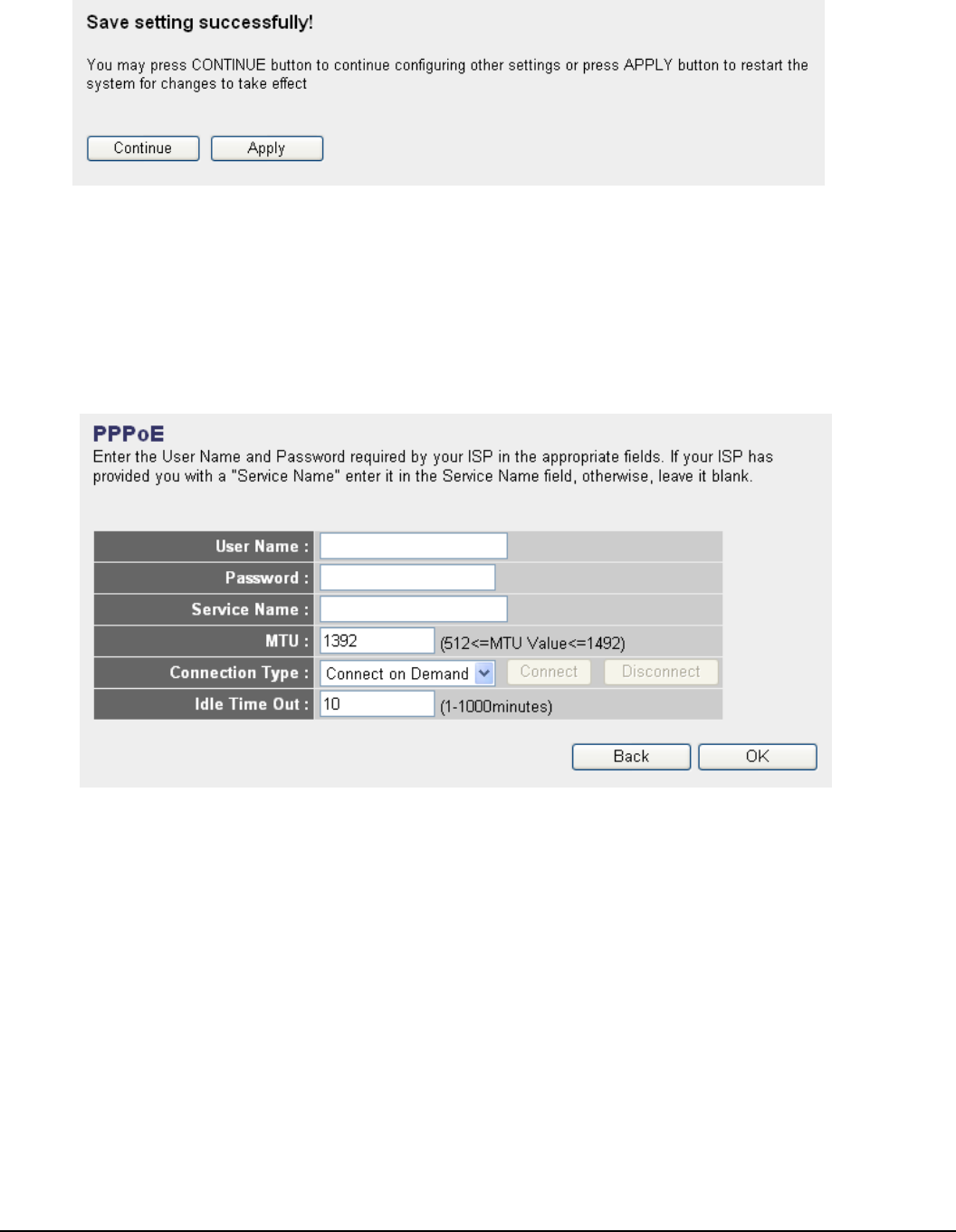
User’s Manual 26
Service Provider Gateway Address:
Please input the IP address of DNS server provided by your service provider.
After you finish with all settings, please click ‘Apply’ button and the following
message will be displayed on your web browser:
Please click ‘Continue’ to back to previous setup menu; to continue on other setup
procedures, or click ‘Apply’ to reboot the router so the settings will take effect (Please wait
for about 30 seconds while router is rebooting).
If you want to reset all settings in this page back to previously-saved value, please click
‘Cancel’ button.
Setup procedure for ‘PPPoE xDSL’:
User Name:
Please input user name assigned by your Internet service provider here.
Password:
Please input the password assigned by your Internet service provider here.
Service Name:
Please give a name to this Internet service, this is optional.
MTU:
Please input the MTU value of your network connection here. If you don’t know, you can use
default value.
Connection Type:
Please select the connection type of Internet connection you wish to use.
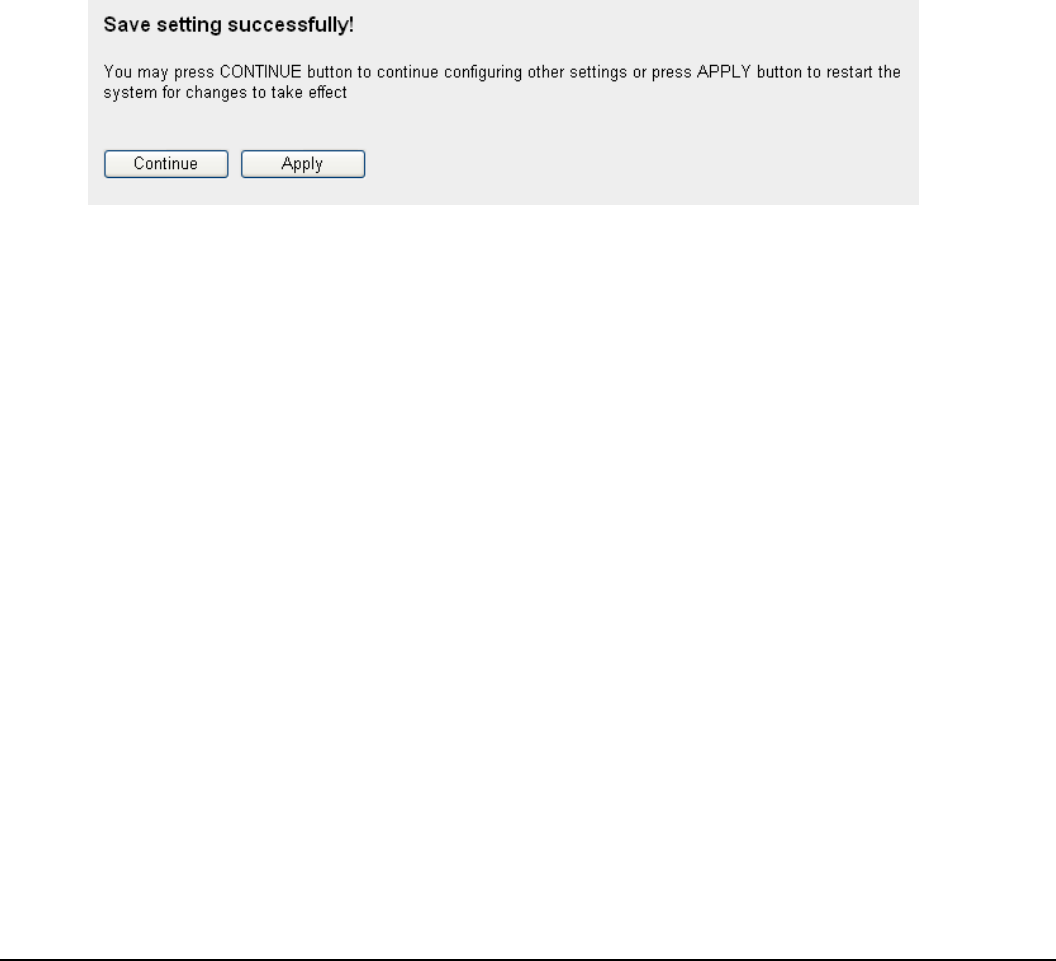
User’s Manual 27
Continuous – The connection will be kept always on. If the connection is interrupted,
the router will re-connect automatically.
Connect On-Demand – Only connect when you want to surf the Internet. “Idle Time
Out” is set to stop the connection when the network traffic is not sending or receiving
after an idle time.
Manual – After you have selected this option, you will see the “Connect” button and
“Disconnect” button, click “’Connect” and the router will connect to the ISP. If you want
to stop the connection, please click “Disconnect” button.
Idle Time Out:
If you have selected the connection type to “Connect-On-Demand”, please input the idle time
out.
After you finish with all settings, please click ‘Apply’ button and the following
message will be displayed on your web browser:
Please click ‘Continue’ to back to previous setup menu; to continue on other setup
procedures, or click ‘Apply’ to reboot the router so the settings will take effect (Please wait
for about 30 seconds while router is rebooting).
If you want to reset all settings in this page back to previously-saved value, please click
‘Cancel’ button.
Setup procedure for ‘PPTP xDSL’:
PPTP xDSL requires two kinds of setting: WAN interface setting (setup IP address) and
PPTP setting (PPTP user name and password). Here we start from WAN interface setting:
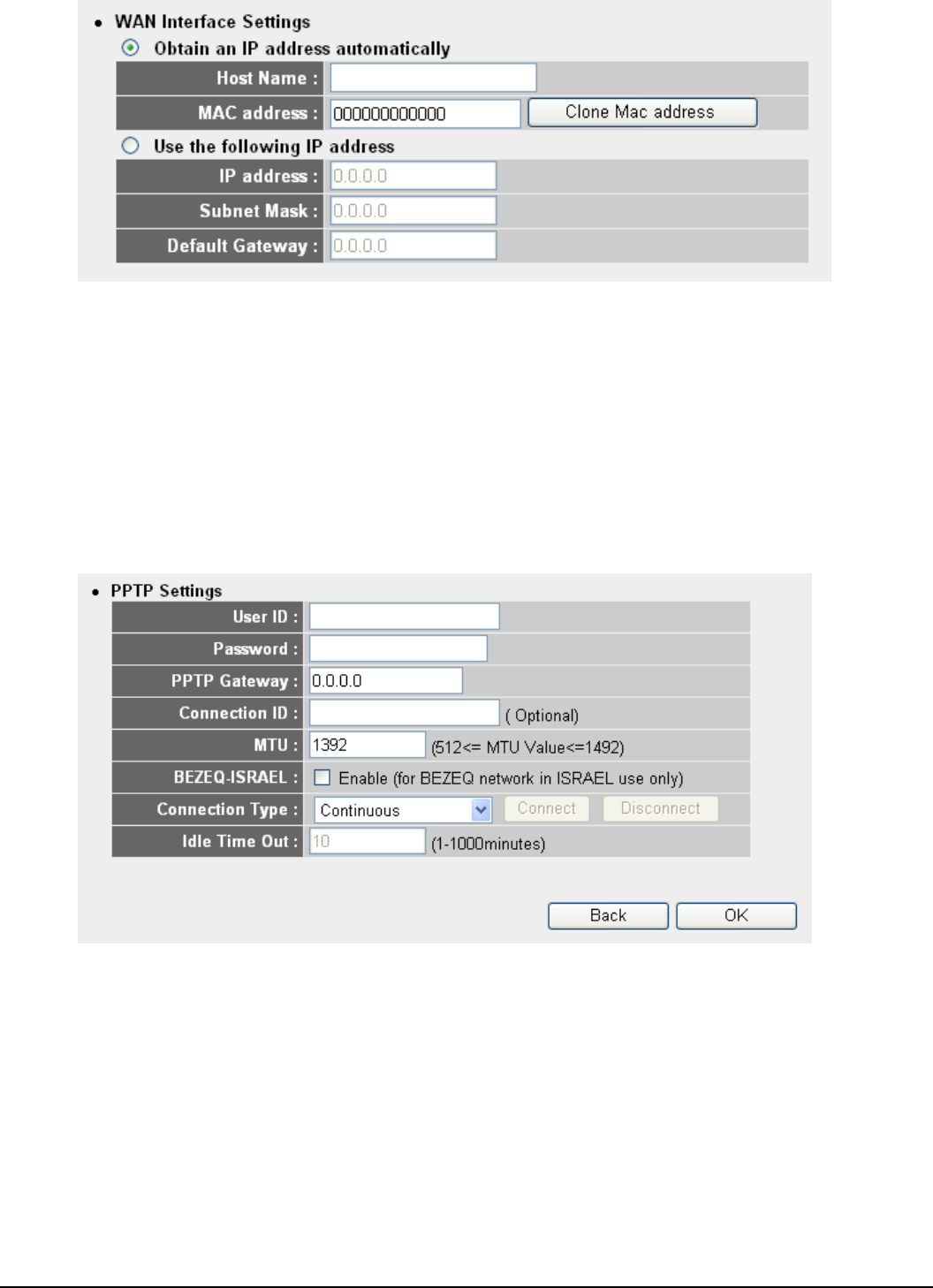
User’s Manual 28
Select the type of how you obtain IP address from your service provider here. You can
choose ‘Obtain an IP address automatically’ (equal to DHCP, please refer to ‘Cable Modem’
section above), or ‘Use the following IP address’ (i.e. static IP address).
WAN interface settings must be correctly set, or the Internet connection will fail even those
settings of PPTP settings are correct. Please contact your Internet service provider if you
don’t know what you should fill in these fields.
Now please go to PPTP settings section:
User ID:
Please input user ID (user name) assigned by your Internet service provider here.
Password:
Please input the password assigned by your Internet service provider here.
PPTP Gateway:
Please input the IP address of PPTP gateway assigned by your Internet service provider
here.
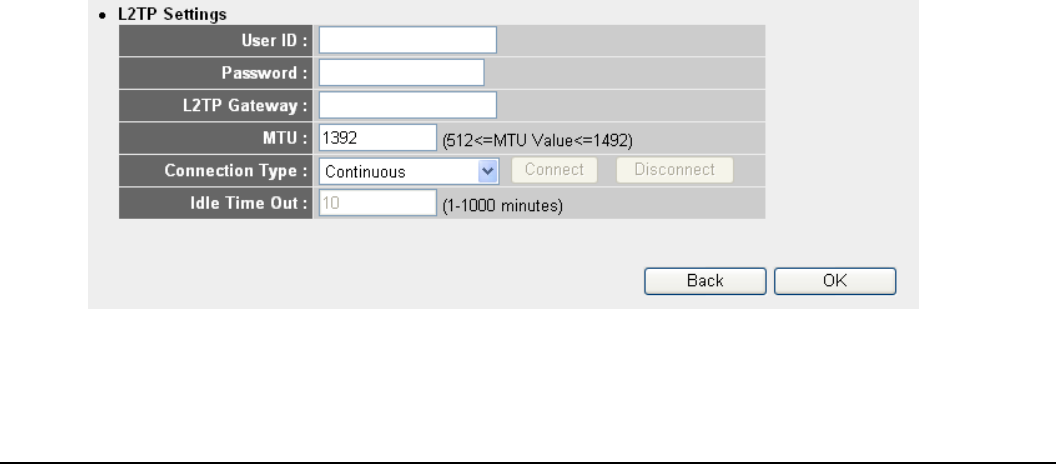
User’s Manual 29
Connection ID:
Please input the connection ID here, this is optional and you can leave it blank.
MTU:
Please input the MTU value of your network connection here. If you don’t know, you can use
default value.
BEZEQ-ISRAEL:
Setting item ‘BEZEQ-ISRAEL’ is only required to check if you’re using the service provided
by BEZEQ network in Israel.
Connection Type:
Please select the connection type of Internet connection you wish to use.
Continuous – The connection will be kept always on. If the connection is interrupted,
the router will re-connect automatically.
Connect On-Demand – Only connect when you want to surf the Internet. “Idle Time
Out” is set to stop the connection when the network traffic is not sending or receiving
after an idle time.
Manual – After you have selected this option, you will see the “Connect” button and
“Disconnect” button, click “’Connect” and the router will connect to the ISP. If you want
to stop the connection, please click “Disconnect” button.
Idle Time Out:
If you have selected the connection type to “Connect-On-Demand”, please input the idle time
out.
When you finish with all settings, please click ‘OK; if you want to go back to previous
menu, click ‘Back’.
Setup procedure for ‘L2TP xDSL’:
User ID:
Please input user ID (user name) assigned by your Internet service provider here.
Password:
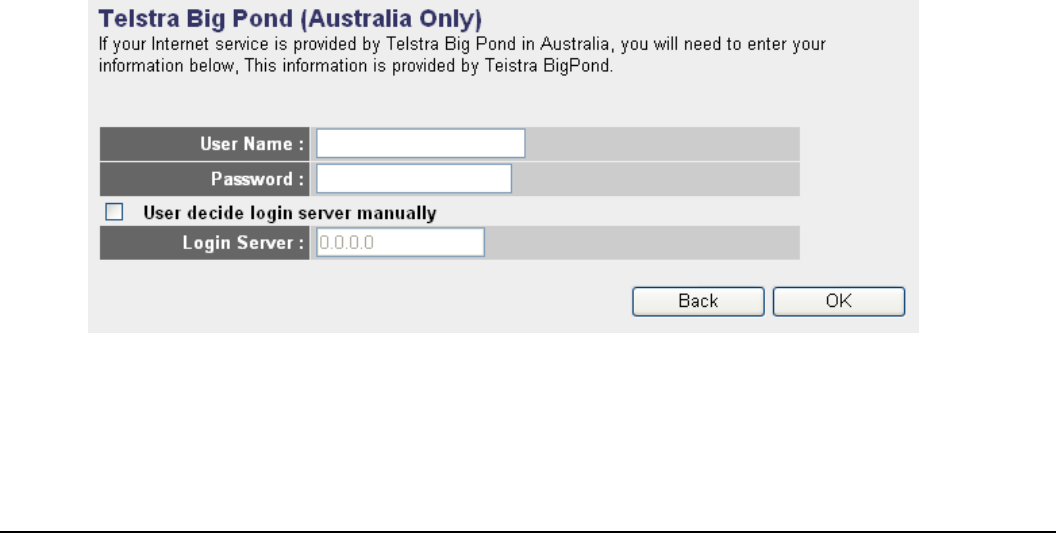
User’s Manual 30
Please input the password assigned by your Internet service provider here.
L2TP Gateway:
Please input the IP address of PPTP gateway assigned by your Internet service provider
here.
MTU:
Please input the MTU value of your network connection here. If you don’t know, you can use
default value.
Connection Type:
Please select the connection type of Internet connection you wish to use.
Continuous – The connection will be kept always on. If the connection is interrupted,
the router will re-connect automatically.
Connect On-Demand – Only connect when you want to surf the Internet. “Idle Time
Out” is set to stop the connection when the network traffic is not sending or receiving
after an idle time.
Manual – After you have selected this option, you will see the “Connect” button and
“Disconnect” button, click “’Connect” and the router will connect to the ISP. If you want
to stop the connection, please click “Disconnect” button.
Idle Time Out:
If you have selected the connection type to “Connect-On-Demand”, please input the idle time
out.
When you finish with all settings, please click ‘OK; if you want to go back to previous
menu, click ‘Back’.
Setup procedure for ‘Telstra Big Pond’:
User Name:
Please input the user name assigned by Telstra.
Password:
Please input the password assigned by Telstra.
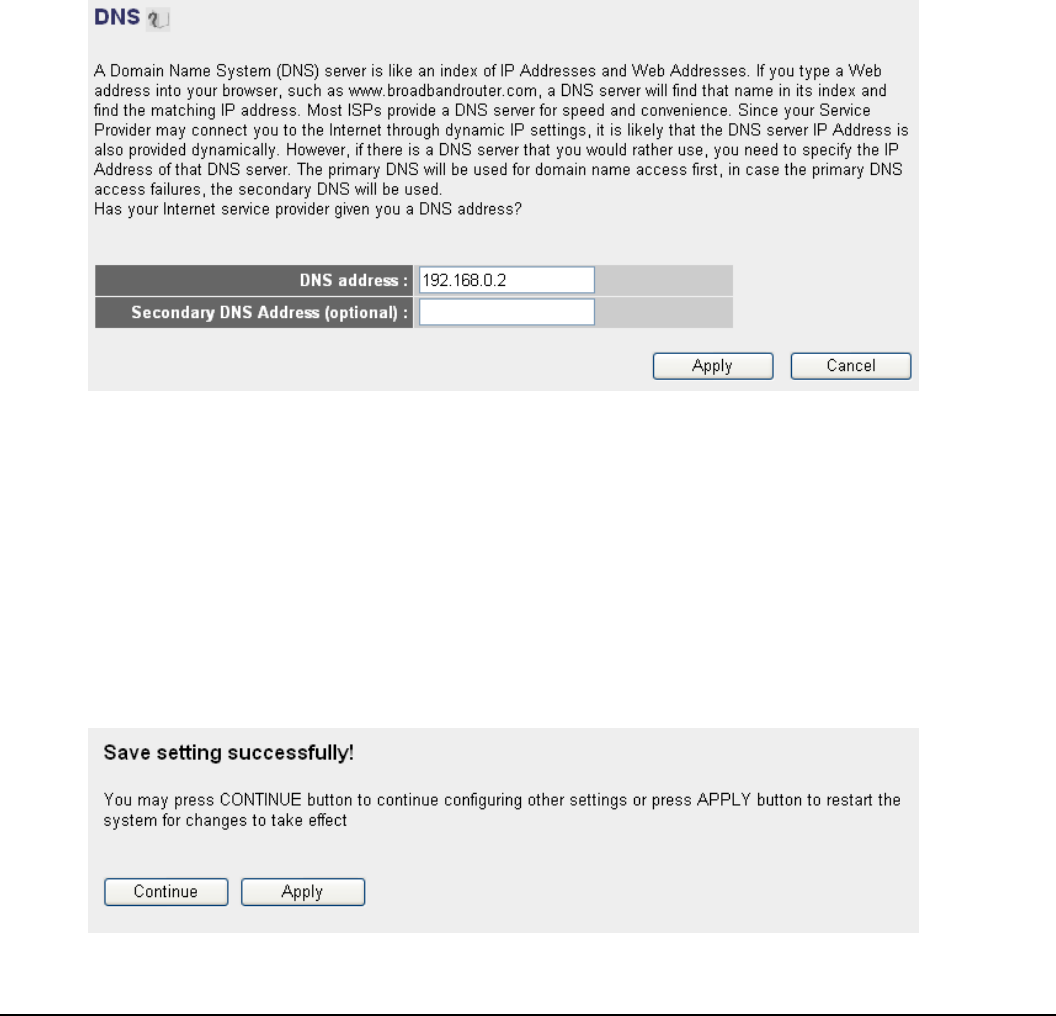
User’s Manual 31
User device login server manually:
Check this box to choose login server by yourself.
Login Server:
Please input the IP address of login server here.
After you finish with all settings, please click ‘OK’ button; if you want to go back to
previous menu, click ‘Back’
Setup procedure for ‘DNS’:
If you select ‘Dynamic IP’ or ‘PPPoE’ as Internet connection method, at least one DNS
server’s IP address should be assigned automatically. However, if you have preferred DNS
server, or your service provider didn’t assign the IP address of DNS server because of any
reason, you can input the IP address of DNS server here.
DNS Address:
Please input the IP address of DNS server provided by your service provider.
Secondary DNS Address:
Please input the IP address of another DNS server provided by your service provider, this is
optional.
After you finish with all settings, please click ‘Apply’ (3) button and the following
message will be displayed on your web browser:
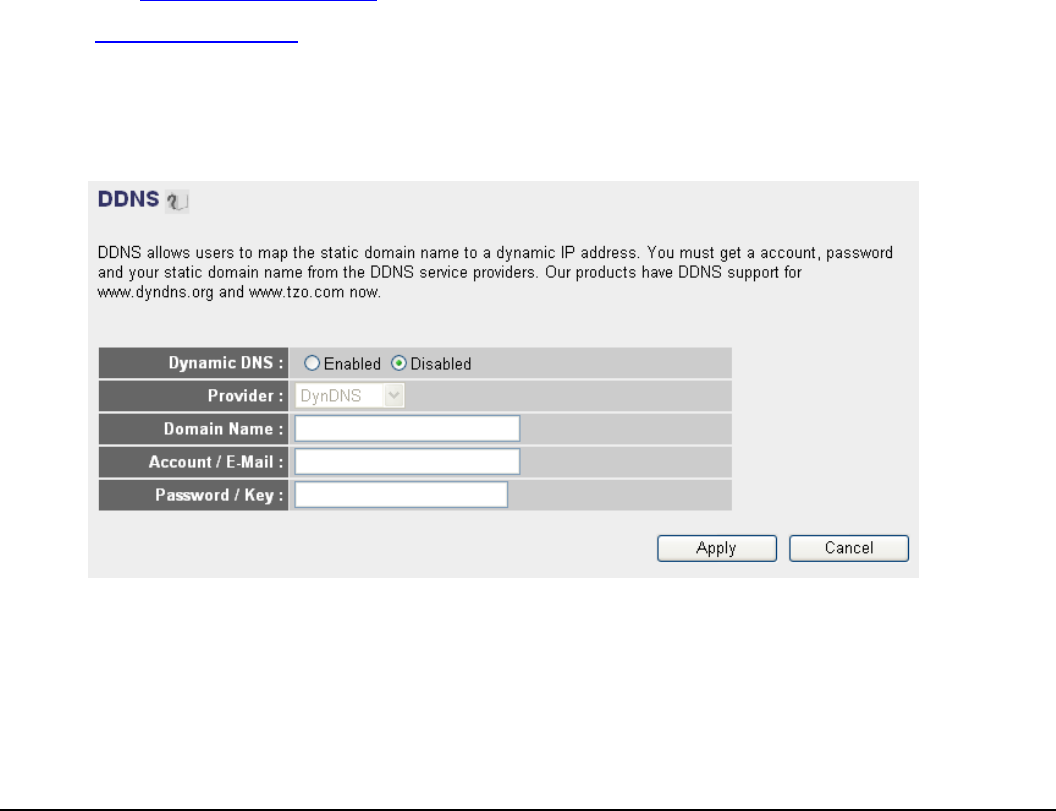
User’s Manual 32
Please click ‘Continue’ to back to previous setup menu; to continue on other setup
procedures, or click ‘Apply’ to reboot the router so the settings will take effect (Please wait
for about 30 seconds while router is rebooting).
If you want to reset all settings in this page back to previously-saved value, please click
‘Cancel’ button.
Setup procedure for ‘DDNS’:
DDNS (Dynamic DNS) is an IP-to-Hostname mapping service for those Internet users who
don’t have a static (fixed) IP address. It will be a problem when such user wants to provide
services to other users on Internet, because their IP address will vary every time when
connected to Internet, and other user will not be able to know the IP address they’re using at
a certain time.
This router supports DDNS service of several service providers, for example:
DynDNS (http://www.dyndns.org)
TZO (http://www.tzo.com)
Please go to one of DDNS service provider’s webpage listed above, and get a free DDNS
account by the instructions given on their webpage.
Dynamic DNS:
If you want to enable DDNS function, please select ‘Enabled’; otherwise please select
‘Disabled’.
Provider:
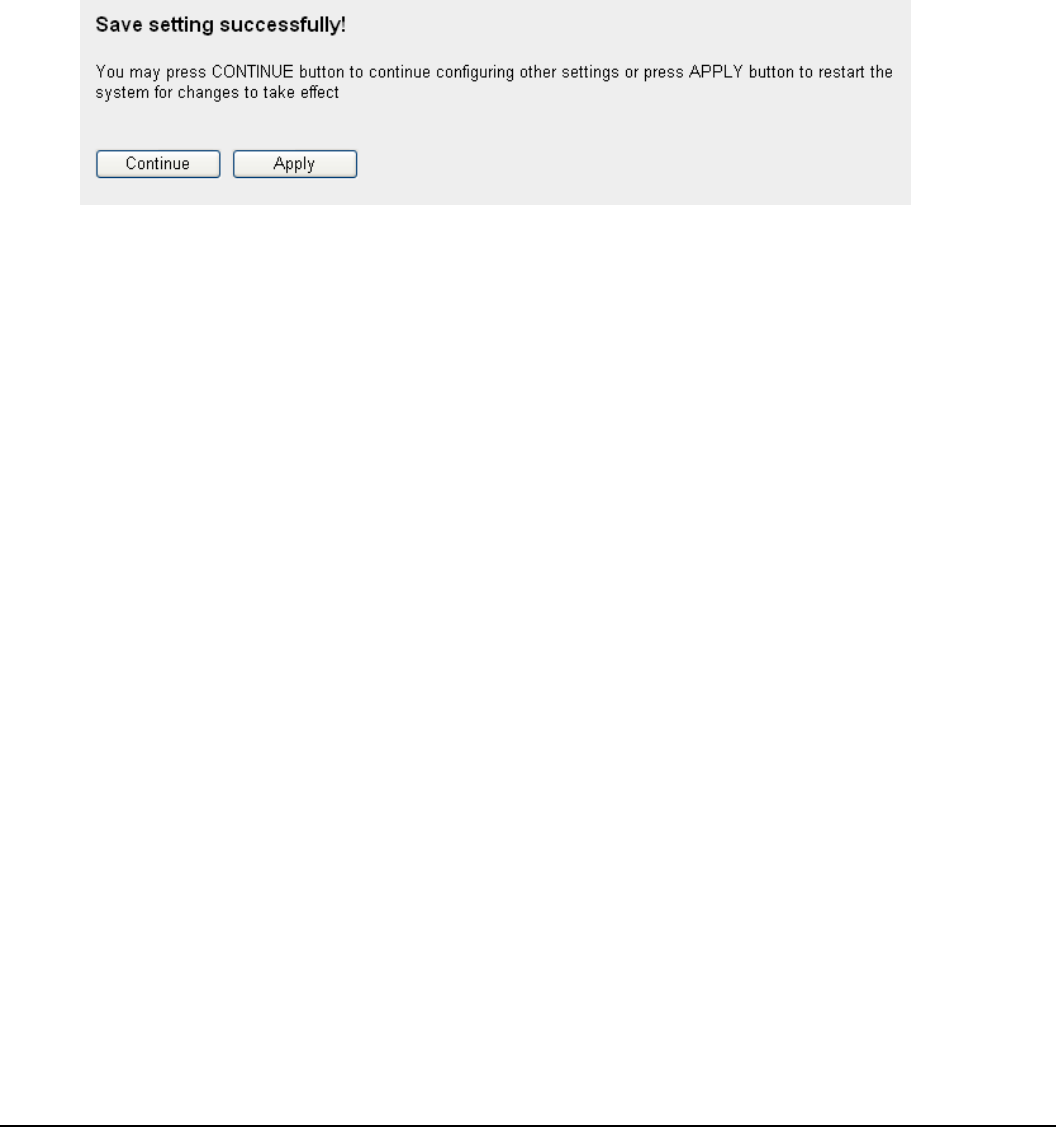
User’s Manual 33
Select your DDNS service provider here.
Domain Name:
Input the domain name you’ve obtained from DDNS service provider.
Account / E-Mail:
Input account or email of DDNS registration.
Password / Key:
Input DDNS service password or key.
After you finish with all settings, please click ‘Apply’ button and the following
message will be displayed on your web browser:
Please click ‘Continue’ to back to previous setup menu; to continue on other setup
procedures, or click ‘Apply’ to reboot the router so the settings will take effect (Please wait
for about 30 seconds while router is rebooting).
If you want to reset all settings in this page back to previously-saved value, please click
‘Cancel’ button.

User’s Manual 34
4.4 Wired LAN Configuration
Before all computers using wired Ethernet connection (i.e. those computers connect to this
router’s LAN port 1 to 4 by Ethernet cable) can communicate with each other and access
internet, they must have a valid IP address.
There are two ways to assign IP addresses to computers: static IP address (set the IP
address for every computer manually), and dynamic IP address (IP address of computers
will be assigned by router automatically. It’s recommended for most of computers to use
dynamic IP address, it will save a lot of time on setting IP addresses for every computer,
especially when there are a lot of computers in your network; for servers and network
devices which will provide services to other computer and users that come from Internet,
static IP address should be used, so other computes can locate the server.
Suggestions on IP address numbering plan:
If you have no idea on how to define an IP address plan for your network, here are
some suggestions.
1. A valid IP address has 4 fields: a.b.c.d, for most of home and company users,
it’s suggested to use 192.168.c.d, where c is an integer between 0 and 254, and
d is an integer between 1 and 254. This router is capable to work with up to 253
clients, so you can set ‘d’ field of IP address of router as 1 or 254 (or any
number between 1 and 254), and pick a number between 0 and 254 for field ‘c’.
2. In most cases, you should use ‘255.255.255.0’ as subnet mask, which allows
up to 253 clients (this also meets router’s capability of working with up to 253
clients).
3. For all servers and network devices which will provide services to other
people (like Internet service, print service, and file service), they should use
static IP address. Give each of them a unique number between 1 and 253, and
maintain a list, so everyone can locate those servers easily.
4. For computers which are not dedicated to provide specific service to others,
they should use dynamic IP address.
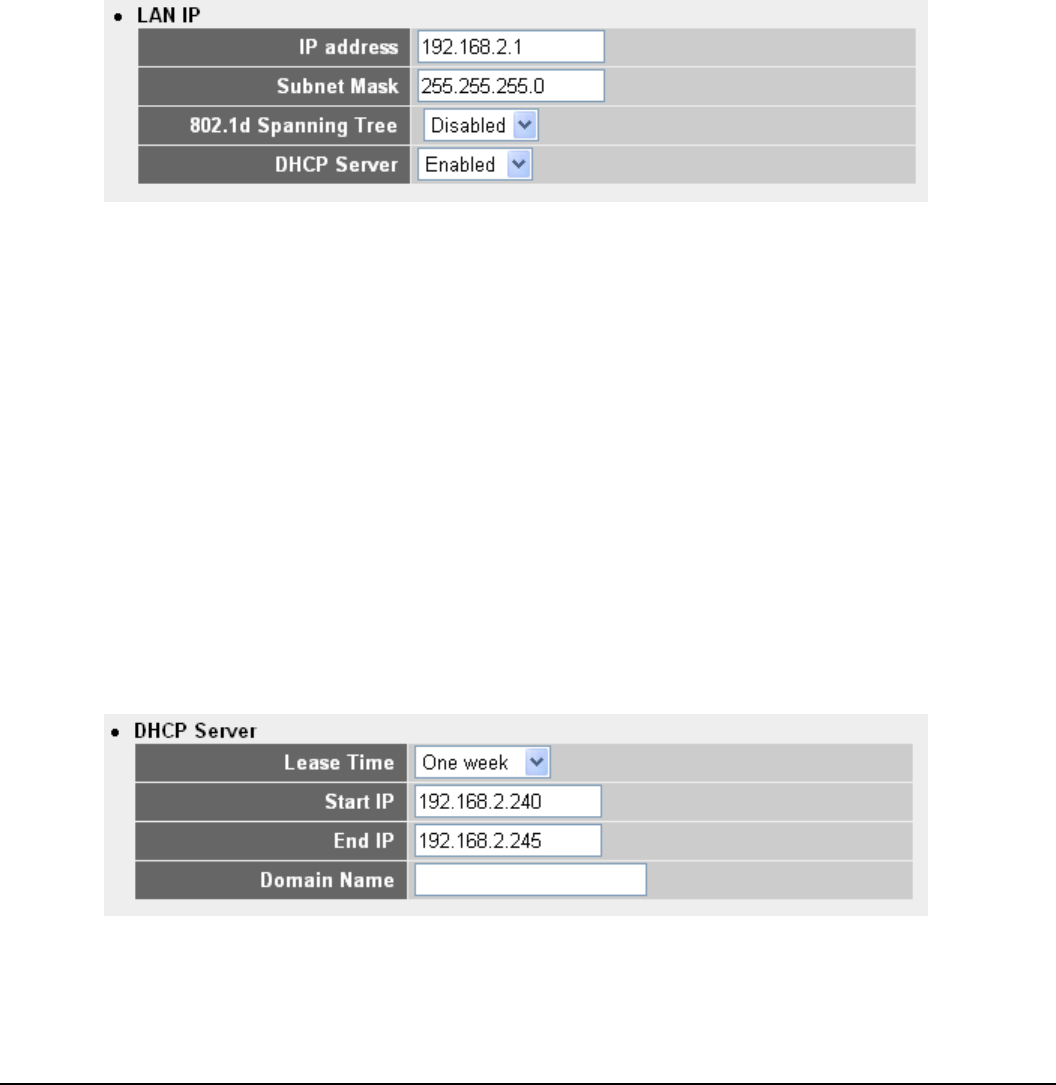
User’s Manual 35
If you don’t really understand the descriptions listed above, don’t worry! We will
provide recommended setup values below.
Please follow the following instructions to set wired LAN parameters:
Please click ‘LAN’ menu on the left of web management interface, there are three setup
groups here: ‘LAN IP’, ‘DHCP Server’, and ‘Static DHCP Leases Table’. Here are setup
instructions for each of them:
LAN IP section:
IP address:
Please input the IP address of this router.
Subnet Mask:
Please input subnet mask for this network.
802.1d Spanning Tree:
If you wish to activate 802.1d spanning tree function, select ‘Enabled’ for setup item
‘802.1d Spanning Tree’, or set it to ‘Disabled’
DHCP Server:
If you want to activate DHCP server function of this router, select ‘Enabled’, or set it to
‘Disabled’.
DHCP Server:
Lease Time:
Please choose a lease time (the duration that every computer can keep a specific IP
address) of every IP address assigned by this router from dropdown menu.
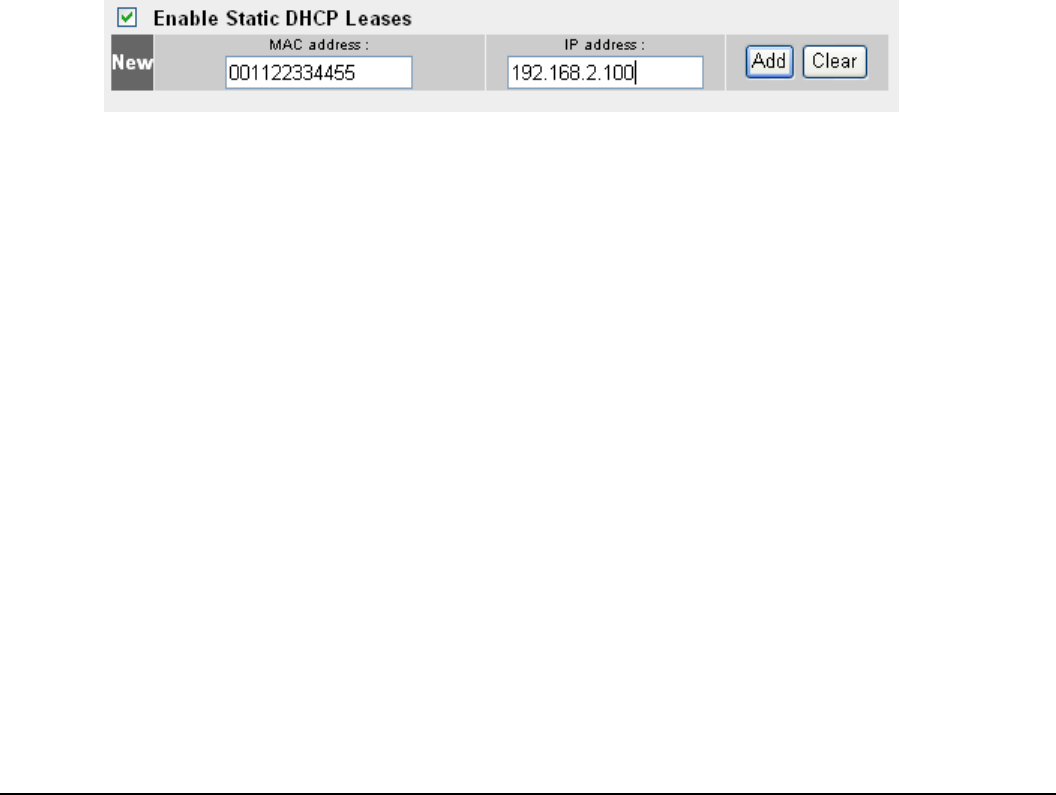
User’s Manual 36
Start IP:
Please input the start IP address of the IP range.
End IP:
Please input the end IP address of the IP range.
Domain Name:
If you wish, you can also optionally input the domain name for your network. This is
optional.
Static DHCP Leases Table:
This function allows you to assign a static IP address to a specific computer forever, so
you don’t have to set the IP address for a computer, and still enjoy the benefit of using
DHCP server. Maximum 16 static IP addresses can be assigned here.
(If you set ‘Lease Time’ to ‘forever’ in ‘DHCP Server’ section, you can also assign an IP
address to a specific computer permanently, however, you will not be able to assign a
certain IP address to a specific computer, since IP addresses will be assigned in random
order by this way).
Enable Static DHCP Leases:
Check this box to enable this function, otherwise uncheck it to disable this function.
MAC Address:
Input the MAC address of the computer or network device (total 12 characters, with
character from 0 to 9, and from a to f, like ‘001122aabbcc’)
IP address:
Input the IP address you want to assign to this computer or network device
‘Add’:
After you inputted MAC address and IP address pair, click this button to add the pair to
static DHCP leases table.
After you clicked ‘Add’, the MAC address and IP address mapping will be added to
‘Static DHCP Leases Table’ section.
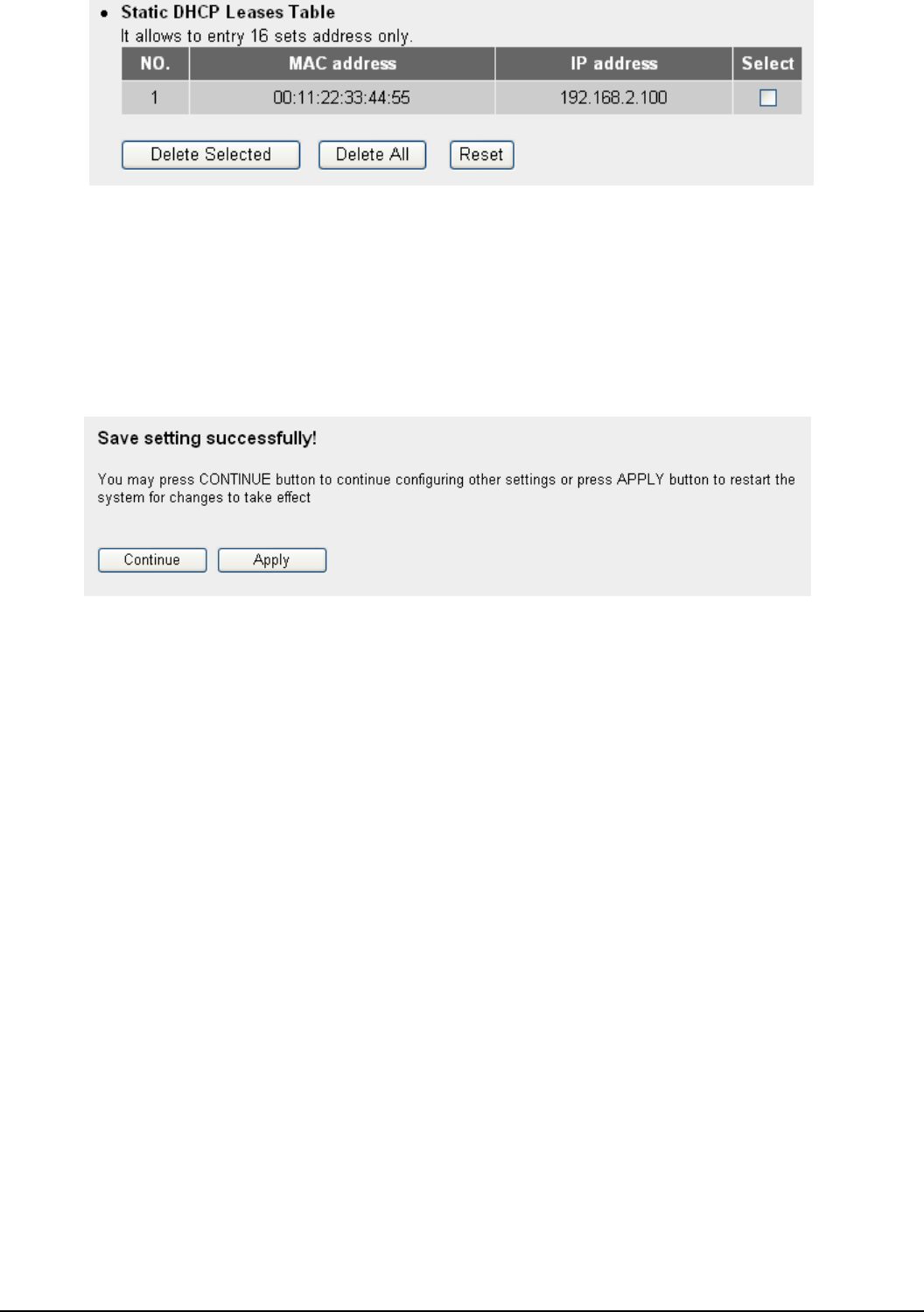
User’s Manual 37
If you want to delete a specific item, please check the ‘Select’ box of a MAC address and
IP address mapping (1), then click ‘Delete Selected’ button (2); if you want to delete all
mappings, click ‘Delete All’ (3). If you want to deselect all mappings, click ‘Reset (4).
After you finish all LAN settings, please click ‘Apply’ button on the bottom of this page. After
you click ‘Apply’, the following message will be displayed on your web browser:
Please click ‘Continue’ to back to previous setup menu; to continue on router setup, or click
‘Apply’ to reboot the router so the settings will take effect (Please wait for about 30 seconds
while router is rebooting).
1
2 4 3
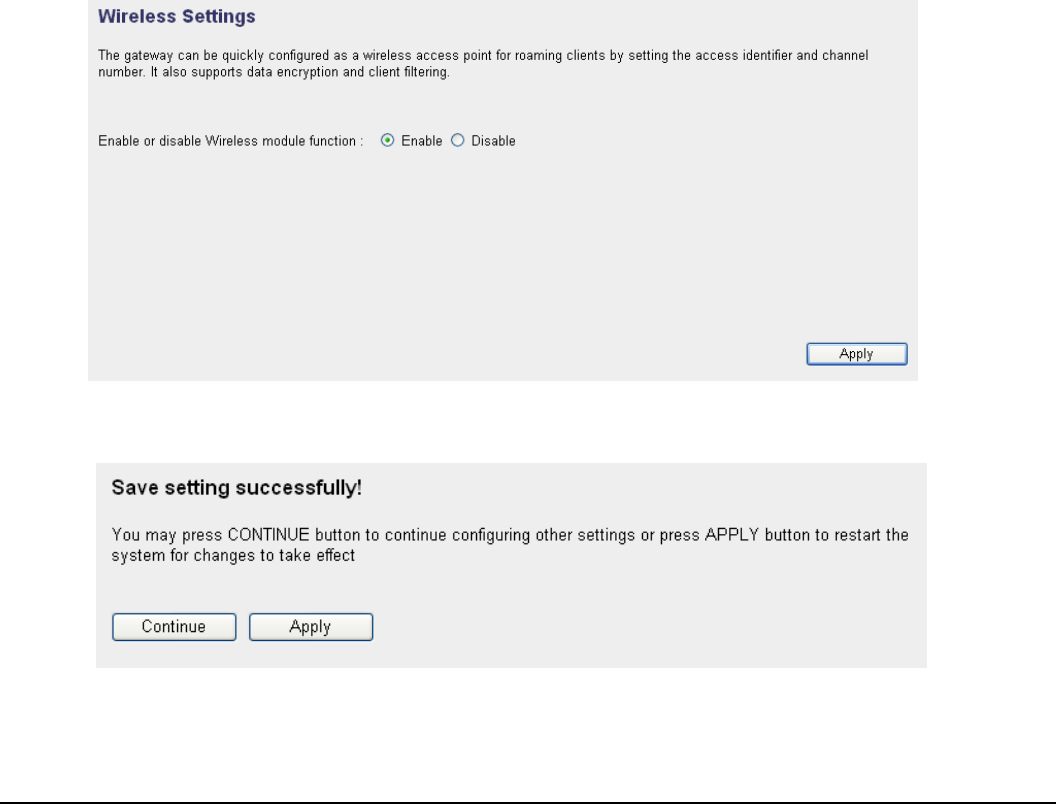
User’s Manual 38
4.5 Wireless LAN Configuration
If your computer, PDA, game console, or other network devices which is equipped with
wireless network interface, you can use the wireless function of this router to let them
connect to Internet and share resources with other computers with wired-LAN
connection. You can also use the built-in security functions to protect your network from
being intruded by malicious intruders.
Please follow the following instructions to set wireless parameters:
Please click ‘Wireless’ menu on the left of web management interface, and the following
message will be displayed on your web browser. You must enable wireless function of this
router, or the wireless interface of this router will not function. Please select ‘Enable’ (1),
then click ‘Apply’ (2) button.
If you’re coming here because you want to disable wireless function, please select ‘Disable’
(3), then click ‘Apply’ (2) button.
After you click ‘Apply’, the following message will be displayed on your web browser:
1
2
3
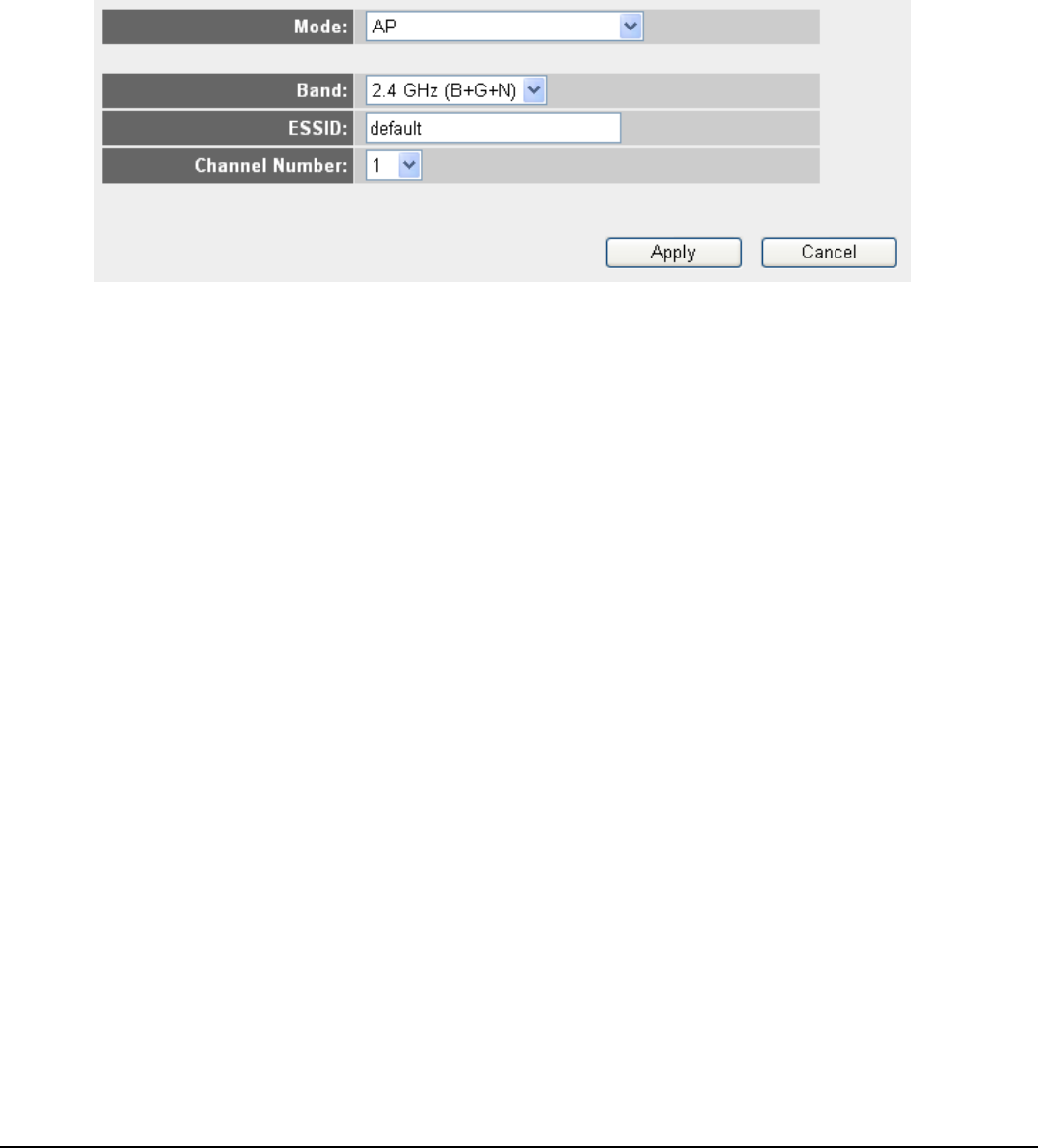
User’s Manual 39
Please click ‘Continue’ to back to previous setup menu; to continue on other setup
procedures, or click ‘Apply’ to reboot the router so the settings will take effect (Please wait
for about 30 seconds while router is rebooting).
Basic Wireless Settings
Please click ‘Wireless’ menu on the left of web management interface, then click ‘Basic
Settings’, and the following message will be displayed on your web browser:
This wireless router can be work in 6 modes:
1. AP: Standard wireless AP (access point).
2. Station-Infrastructure: Configure the router to Ethernet device such us TV, Game
player, HDD&DVD to enable the Ethernet device be a wireless station.
3. AP Bridge-Point to Point: Connect this router with another wireless router, to expand
the scope of network.
4. AP Bridge-Point to Multi-Point: Connect this router with up to four other wireless
routers, to expand the scope of network.
5. AP Bridge-WDS: Connect this router with up to four WDS-capable wireless routers, to
expand the scope of network.
6. Universal Repeater: The router can act as Station and AP at the same time. It can use
Station function to connect to a Root AP and use AP function to service all wireless
stations within its coverage.
1
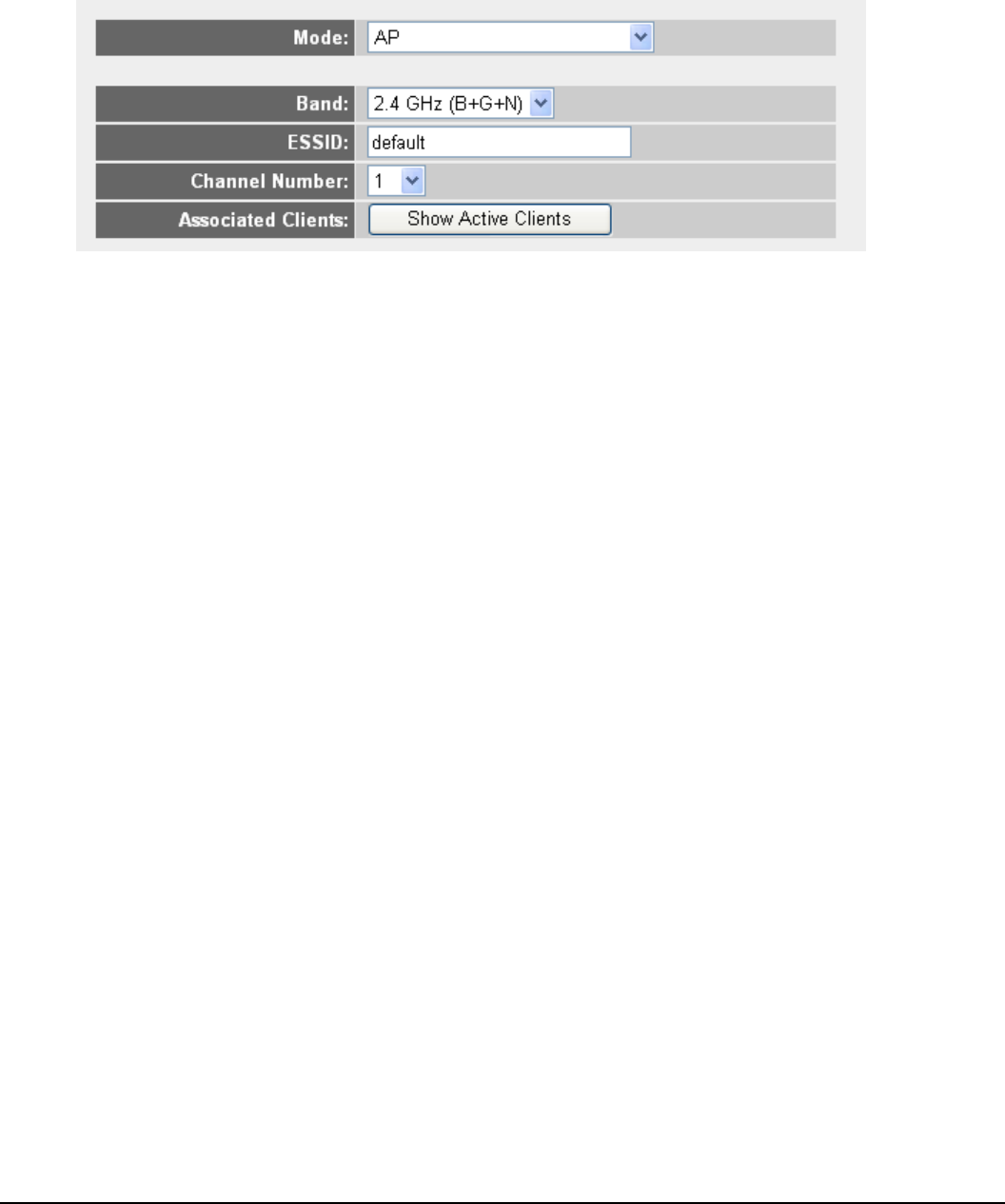
User’s Manual 40
Please select a proper operation mode you want to use from ‘Mode’ dropdown menu (1),
and continue on other operation mode specific settings:
Setup procedure for ‘AP’:
Please select the radio band you want to use from ‘Band’ dropdown menu (2), and the
following message will be displayed:
Band:
Please select the radio band from one of following options:
1. 2.4 GHz (B): 2.4GHz band, only allows 802.11b wireless network client to
connect this router (maximum transfer rate 11Mbps).
2. 2.4 GHz (N): 2.4GHz band, only allows 802.11n wireless network client to
connect this router (maximum transfer rate 150Mbps).
3. 2.4 GHz (B+G): 2.4GHz band, only allows 802.11b and 802.11g wireless
network client to connect this router (maximum transfer rate 11Mbps for 802.11b
clients, and maximum 54Mbps for 802.11g clients).
4. 2.4 GHz (G): 2.4GHz band, only allows 802.11g wireless network client to
connect this router (maximum transfer rate 54Mbps).
5. 2.4 GHz (B+G+N): 2.4GHz band, allows 802.11b, 802.11g, and 802.11n
wireless network client to connect this router (maximum transfer rate 11Mbps for
802.11b clients, maximum 54Mbps for 802.11g clients, and maximum 150Mbps for
802.11n clients).
NOTE: For 802.11b and 802.11g mode, the signals can be transmitted only by
antenna 1 (The antenna in the right side of the rear panel).
For 802.11n mode: The router is operating in a 1T2R Spatial Multiplexing MIMO
configuration. 1 antenna is for signal transmitting and 2 antennas are for signal
receiving.
2
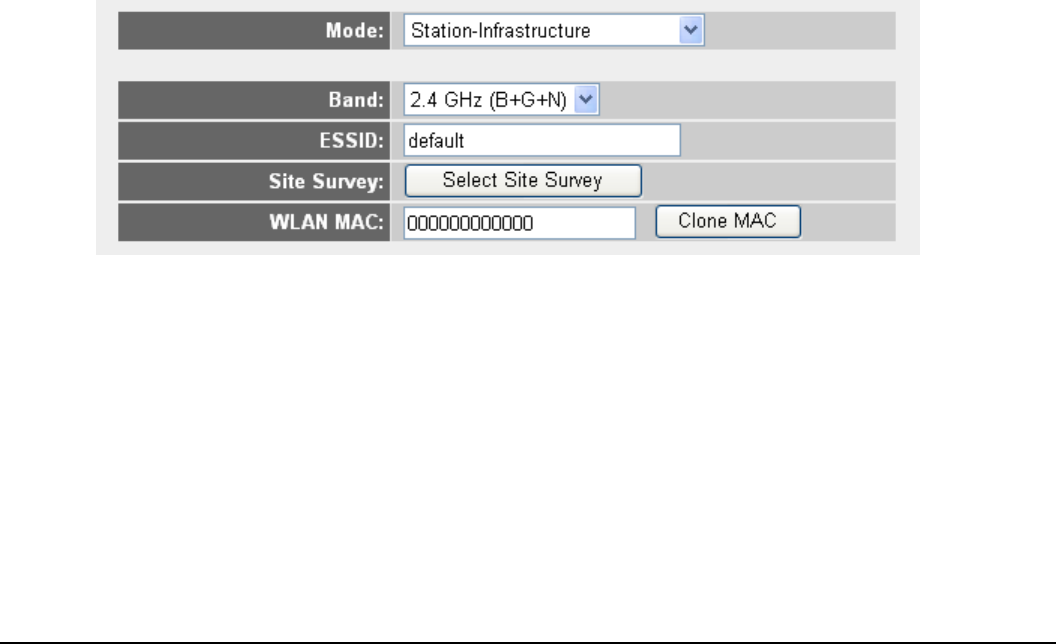
User’s Manual 41
ESSID:
This is the name of wireless router. You can type any alphanumerical characters here,
maximum 32 characters. ESSID is used to identify your own wireless router from others
when there are other wireless routers in the same area. Default SSID is ‘default’, it’s
recommended to change default ESSID value to the one which is meaningful to you, like
myhome, office_room1, etc.
Channel Number:
Please select a channel from the dropdown list of ‘Channel Number’, available channel
numbers are 1 to 13 for European countries, 1 to 11 for USA. You can choose any channel
number you want to use, and almost all wireless clients can locate the channel you’re using
automatically without any problem. However, it’s still useful to remember the channel
number you use, some wireless client supports manual channel number select, and this
would help in certain scenario when there is some radio communication problem.
Associated Clients:
Click ‘Show Active Clients’ button, then an “Active Wireless Client Table” will pop up. You
can see the status of all active wireless stations that are connecting to the access point.
Setup procedure for ‘Station-Infrastructure’:
In this mode, you can connect the router to Ethernet device such us TV, Game player,
HDD&DVD to enable the Ethernet device be a wireless station and join to a wireless
network through an access point or AP router.
Band:
Select the band you want to use.
ESSID:
This is the name of wireless network. You can type the SSID of the network you would like
to connect here.
Site Survey:
When you use this wireless router as a wireless station for Ethernet network device to have
wireless capability, you have to associate it with a working access point. Click ‘Select Site
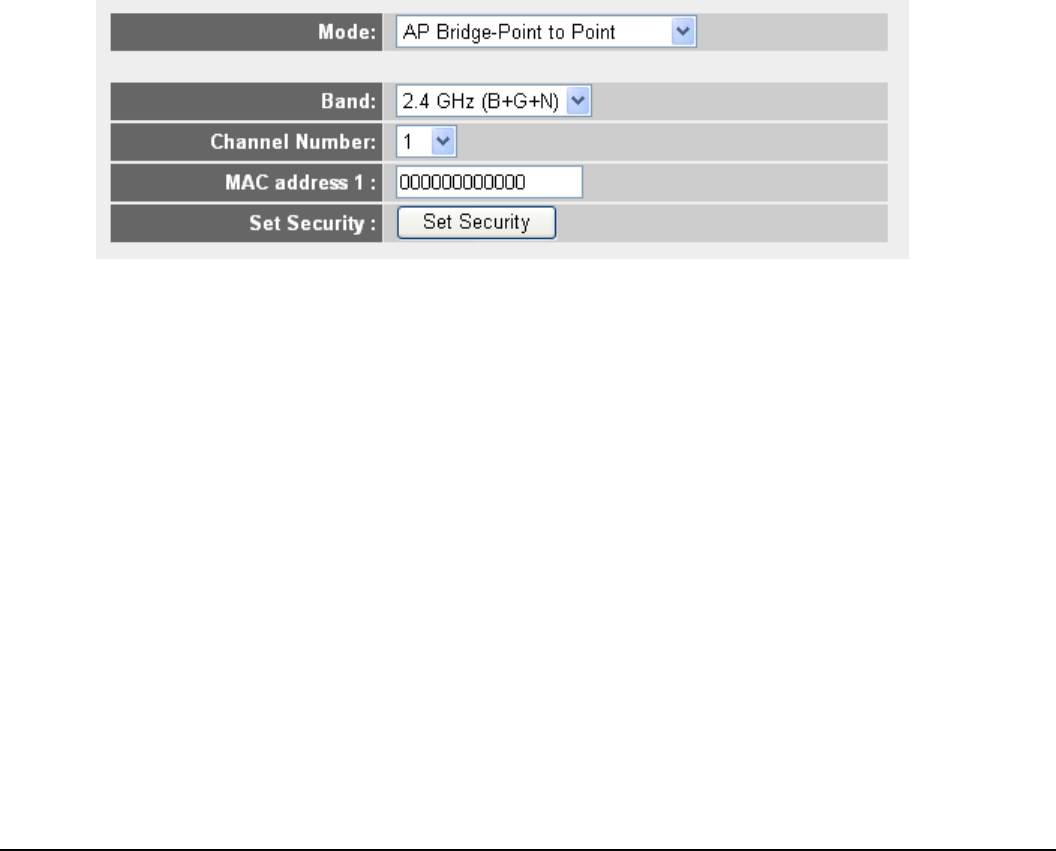
User’s Manual 42
Survey’ button, then a “Wireless Site Survey Table” will pop up. It will list all available
access points near by. You can select one access point in the table and it will join wireless
LAN through this access point.
WLAN MAC:
For some applications, you may need to designate a specific MAC address for the router.
Please enter the MAC address here. If you are connecting the router to a computer, you
can simply press ‘Clone Mac address’ button to fill the MAC address field with the MAC
address of your computer.
Setup procedure for ‘AP Bridge-Point to Point’:
In this mode, you can connect your wireless router with another, to combine two access
points and expand the scope of wireless network, and all clients (wired only – AP will not
accept wireless clients in this mode) of two wireless routers will think they’re on the same
physical network. This function is very convenient when you need to connect two networks
between two buildings. Here are instructions about how to connect two wireless routers
together:
Band:
Select the band you want to use; two wireless routers must use the same setting.
Channel Number:
Select the channel you want to use; two wireless routers must use the same setting.
MAC address:
Input the MAC address of another wireless router.
Set Security:
Click to set security settings for this connection.
Setup procedure for ‘AP Bridge-Point to Multi-Point’:
In this mode, you can connect your wireless router with at least four wireless routers to
expand the scope of wireless network, and all clients (wired only – AP will not accept
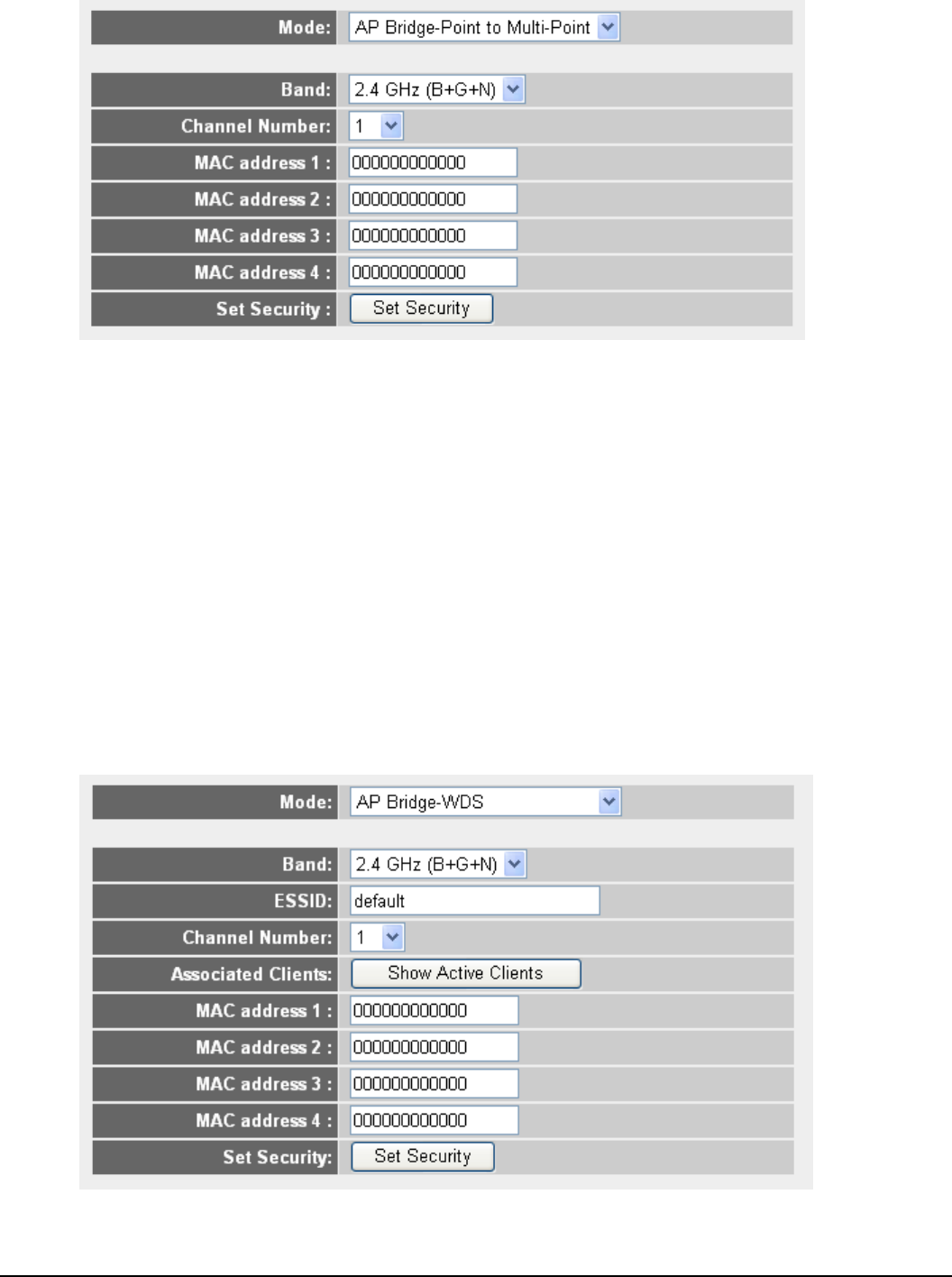
User’s Manual 43
wireless clients in this mode) of the wireless routers will think they’re on the same physical
network.
Band:
Select the band you want to use, all the wireless routers must use the same setting.
Channel Number:
Select the channel you want to use, all the wireless routers must use the same setting.
MAC address 1 to 4:
Input the MAC address of other wireless routers.
Set Security:
Click to set security settings for this connection.
Setup procedure for ‘AP Bridge – WDS’
In this mode, you can expand the scope of network by combining up to four
other access points together, and every access point can still accept wireless
clients.
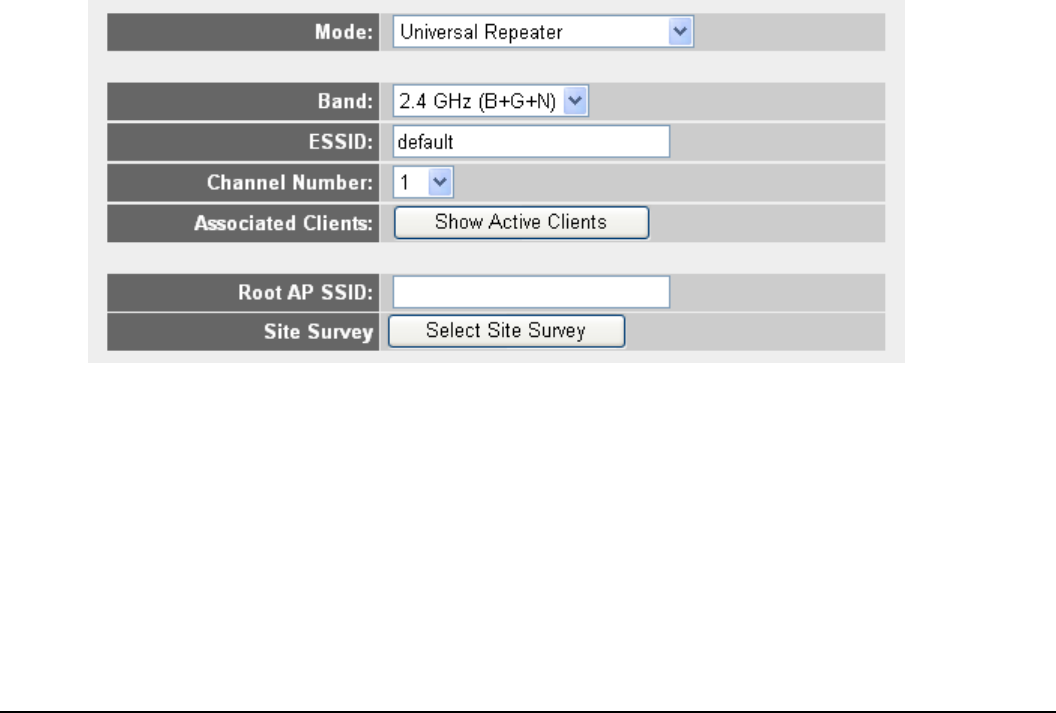
User’s Manual 44
Band:
Select the band you want to use, all the wireless routers must use the same setting.
ESSID:
Input the ESSID of your wireless router, the setting should be the same with other wireless
routers for the convenience of roaming.
Channel Number:
Select the channel you want to use, all the wireless routers must use the same setting.
Associated Clients:
Click ‘Show Active Clients’ button, then an “Active Wireless Client Table” will pop up. You
can see the status of all active wireless stations that are connecting to the access point.
MAC address 1 to 4:
Input the MAC address of other wireless routers.
Set Security:
Click to set security settings for this connection.
Setup procedure for ‘Universal Repeater’
In this mode, the router can act as a wireless repeater; it can be Station and AP at the
same time. It can use Station function to connect to a Root AP and use AP function to
service all wireless stations within its coverage.
Band:
Select the band you want to use, all the wireless routers must use the same setting.
ESSID:
This is the name of wireless router. You can type any alphanumerical characters here,
maximum 32 characters. ESSID is used to identify your own wireless router from others
when there are other wireless routers in the same area. Default SSID is ‘default’, it’s
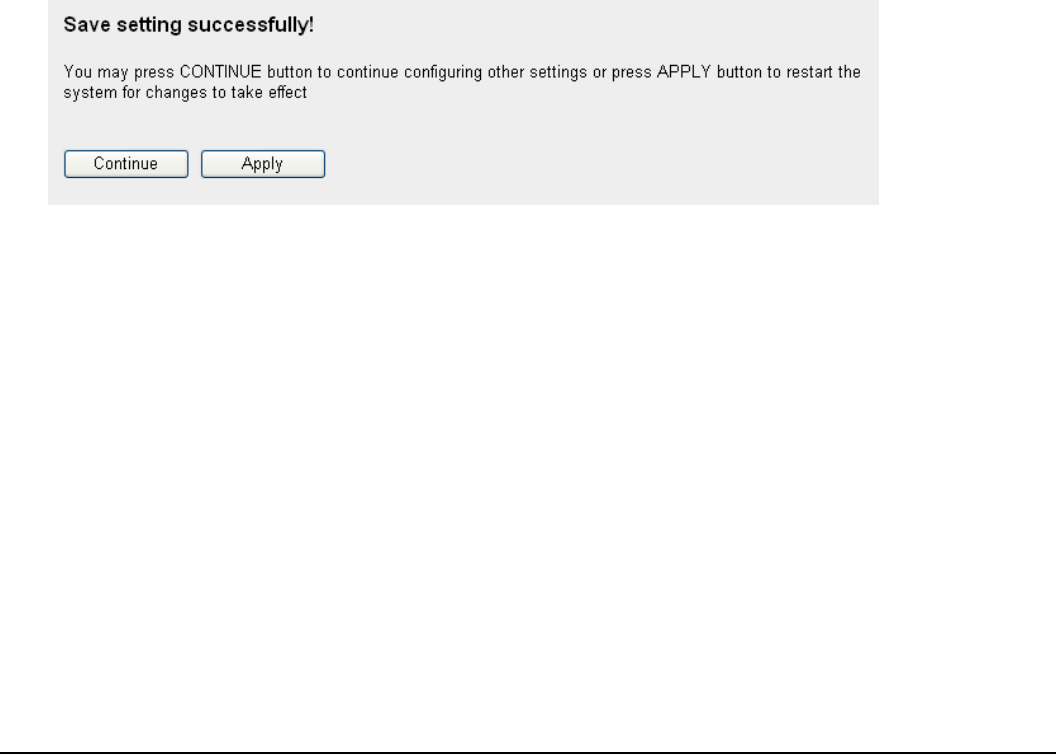
User’s Manual 45
recommended to change default ESSID value to the one which is meaningful to you, like
myhome, office_room1, etc.
Channel Number:
Select the channel you want to use, all the wireless clients must use the same setting.
Associated Clients:
Click ‘Show Active Clients’ button, then an “Active Wireless Client Table” will pop up. You
can see the status of all active wireless stations that are connecting to the access point.
Root AP SSID:
In ‘Universal Repeater’ mode, this device can act as a station to connect to a Root AP. You
should assign the SSID of the Root AP here or click ‘Select Site Survey’ button to choose a
Root AP.
Site Survey:
Click ‘Select Site Survey’ button, then a “Wireless Site Survey Table” will pop up. It will list
all available access points near by. You can select one access point in the table and the
router will join wireless LAN through this access point.
After you finish the wireless setting, please click ‘Apply’ button, after you click ‘Apply’, the
following message will be displayed on your web browser:
Please click ‘Continue’ to back to previous setup menu; to continue on router setup, or click
‘Apply’ to reboot the router so the settings will take effect (Please wait for about 30 seconds
while router is rebooting).
Advanced Wireless Settings
This router provides some advanced control of wireless parameters, if you want to
configure these settings, please click ‘Wireless’ menu on the left of web management
interface, then click ‘Advanced Settings’, and the following message will be displayed on
your web browser:
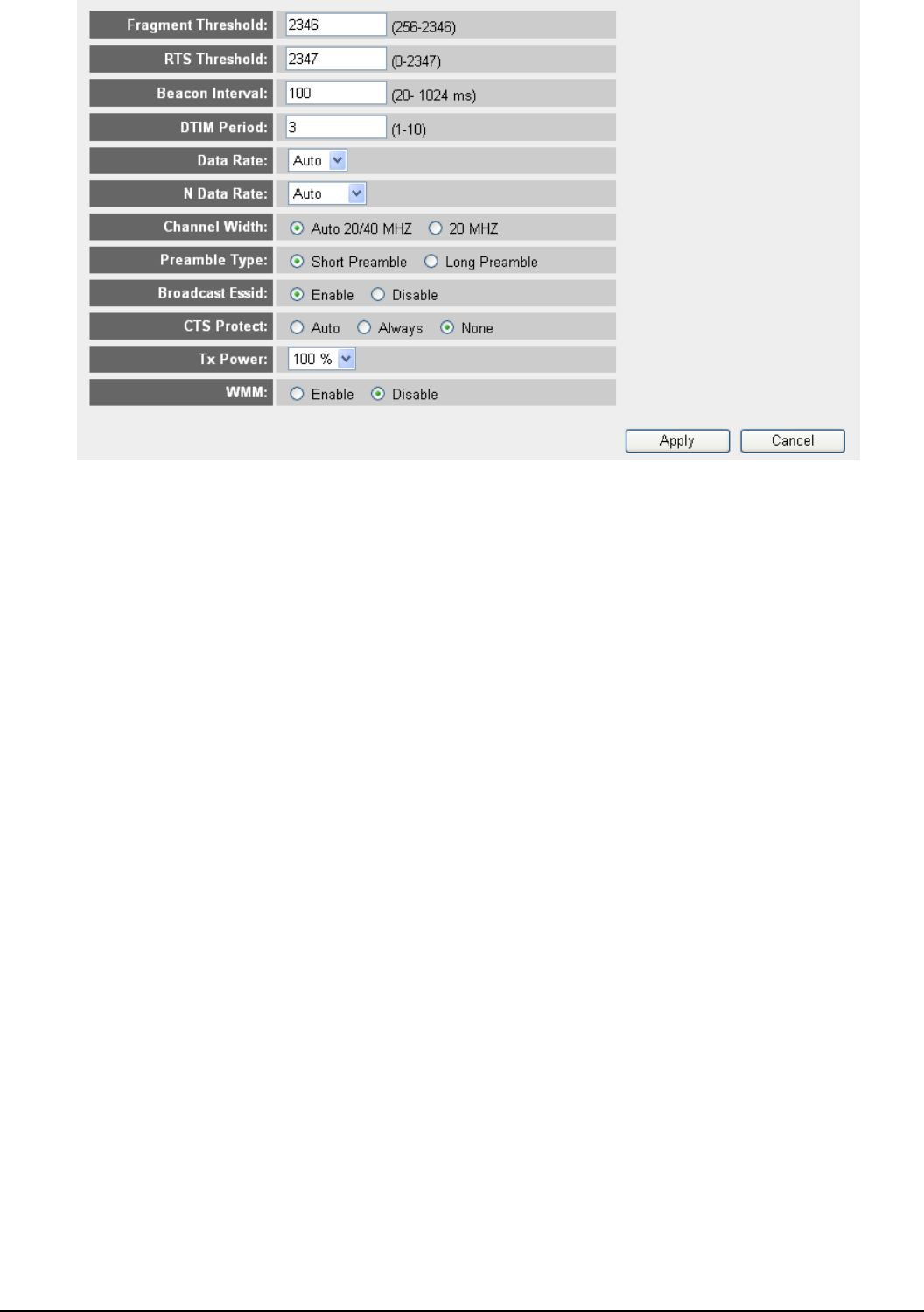
User’s Manual 46
Fragment Threshold:
Set the Fragment threshold of wireless radio. Do not modify default value if you don’t
know what it is, default value is 2346.
RTS Threshold:
Set the RTS threshold of wireless radio. Do not modify default value if you don’t know
what it is, default value is 2347.
Beacon Interval:
Set the beacon interval of wireless radio. Do not modify default value if you don’t know
what it is, default value is 100.
DTIM Period:
Set the DTIM period of wireless radio. Do not modify default value if you don’t know
what it is, default value is 3.
Data Rate:
Set the wireless data transfer rate to a certain value. Since most of wireless devices will
negotiate with each other and pick a proper data transfer rate automatically, it’s not
necessary to change this value unless you know what will happen after modification.
N Data Rate:
Same as above, but only for 802.11n clients.
Channel Width:
Set channel width of wireless radio. Do not modify default value if you don’t know what
it is, default setting is ‘Auto 20/40 MHz’.
Preamble Type:
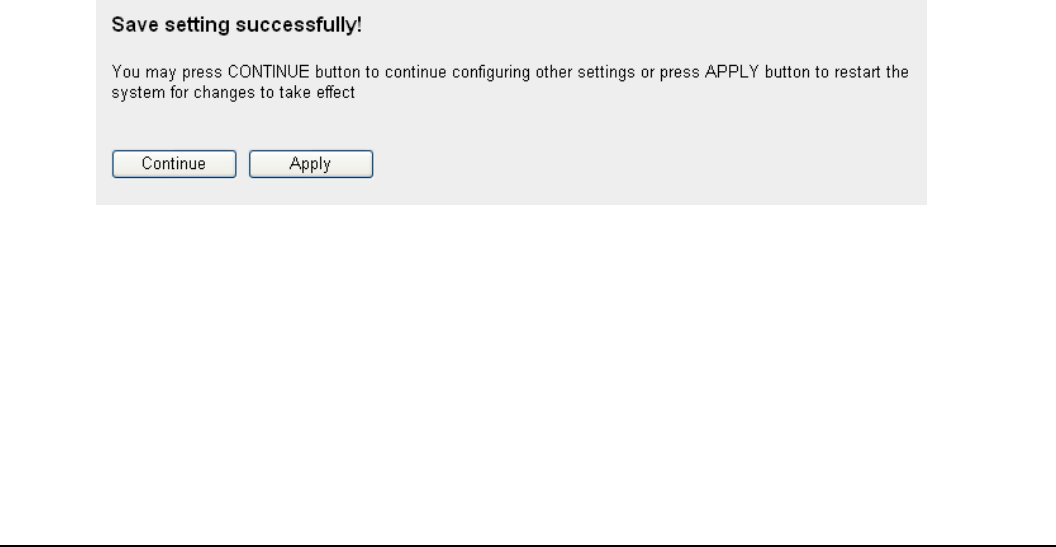
User’s Manual 47
Set the type of preamble, do not modify default value if you don’t know what it is,
default setting is ‘Short Preamble’.
Broadcast ESSID:
Decide if the wireless router will broadcast its own ESSID or not. You can hide the ESSID
of your wireless router (set the option to ‘Disable’), so only people those who know the
ESSID of your wireless router can get connected.
CTS Protect:
Enabling this setting will reduce the chance of radio signal collisions between 802.11b and
802.11g/n wireless access points. It’s recommended to set this option to ‘Auto’ or ‘Always’.
However, if you set to ‘None’, your wireless router should be able to work fine, too.
Tx Power :
You can set the output power of wireless radio. Unless you’re using this wireless router in a
really big space, you may not have to set output power to 100%. This will enhance
security (malicious / unknown users in distance will not be able to reach your
wireless router).
WMM:
The short of Wi-Fi MultiMedia, it will enhance the data transfer performance of multimedia
contents when they’re being transferred over wireless network. If you don’t know what it
is / not sure if you need it, it’s safe to set this option to ‘Enable’, however, default
value is ‘Disable’.
After you finish these wireless settings, please click ‘Apply’ button, button, and the following
message will be displayed on your web browser:
Please click ‘Continue’ to back to previous setup menu; to continue on router setup, or click
‘Apply’ to reboot the router so the settings will take effect (Please wait for about 30 seconds
while router is rebooting).
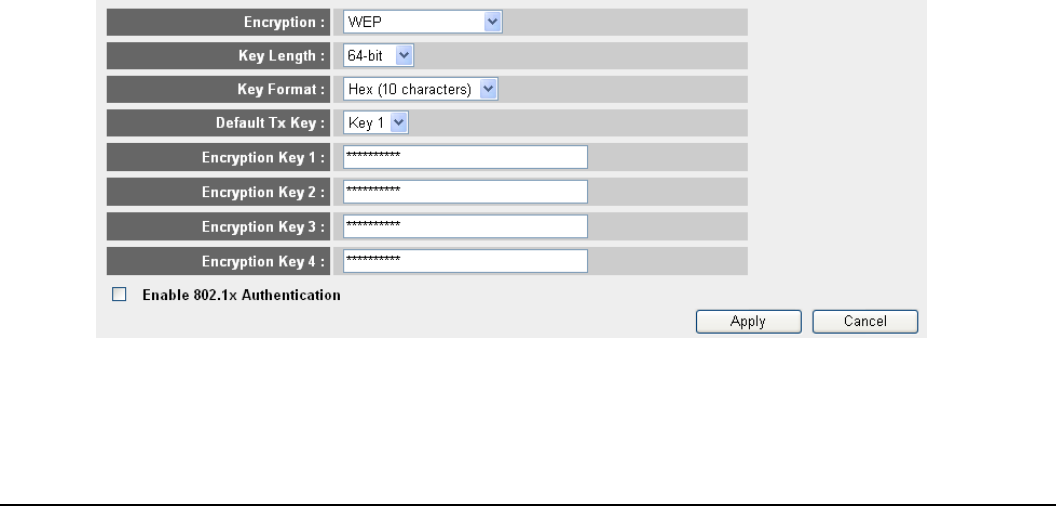
User’s Manual 48
Wireless Security:
It’s very important to set wireless security settings properly! If you don’t, hackers and
malicious users can reach your network and valuable data without your consent and this
will cause serious security problem.
To set wireless security settings, Please click ‘Wireless’ menu on the left of web
management interface, then click ‘Security Settings’, then follow the following instructions
to set wireless security settings:
Please select an encryption method from ‘Encryption’ dropdown menu, there are four
options:
Disable wireless security
When you select this mode, data encryption is disabled, and every wireless device in
proximity will be able to connect your wireless router if no other security measure is
enabled (like MAC address access control - see section 2-7-4, or disable ESSID broadcast).
Only use this option when you really want to allow everyone to use your wireless
router, and you don’t care if there’s someone reads the data you transfer over
network without your consent.
WEP - Wired Equivalent Privacy
When you select this mode, the wireless router will use WEP encryption, and the following
setup menu will be shown on your web browser:
Key Length:
There are two types of WEP key length: 64-bit and 128-bit. Using ‘128-bit’ is safer than ’64-
bit’, but will reduce some data transfer performance.
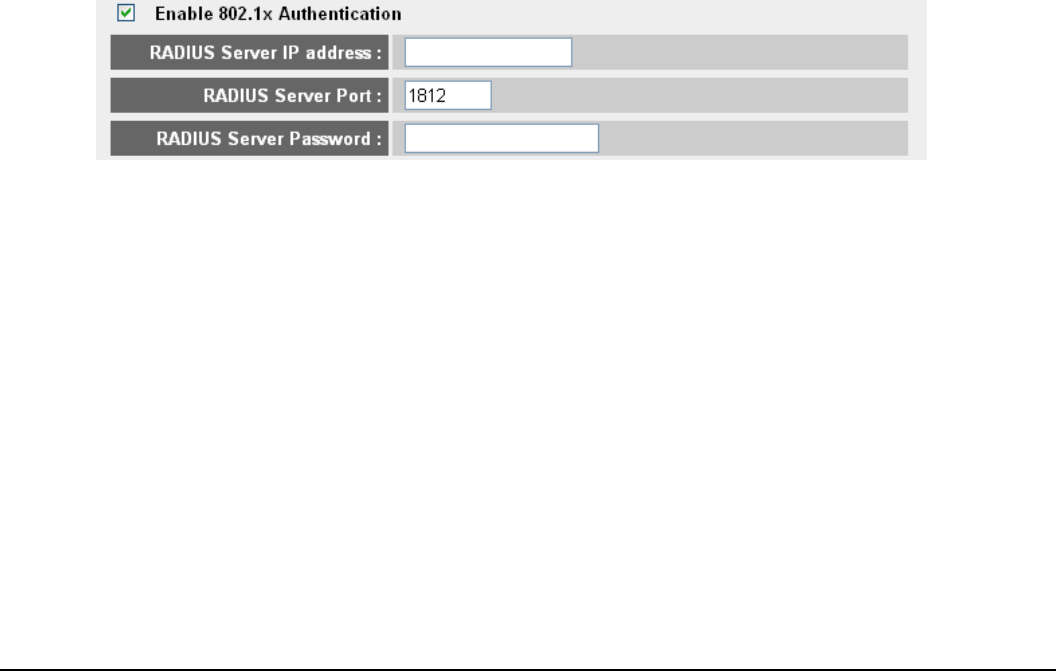
User’s Manual 49
Key Format:
There are two types of key format: ASCII and Hex. When you select a key format, the
number of characters of key will be displayed. For example, if you select ’64-bit’ as key
length, and ‘Hex’ as key format, you’ll see the message at the right of ‘Key Format’ is ‘Hex
(10 characters), which means the length of WEP key is 10 characters.
Default Tx Key:
You can set up to four sets of WEP key, and you can decide which key is being used by
default here. If you don’t know which one you should use, select ‘Key 1’.
Encryption Key 1 to 4:
Input WEP key characters here, the number of characters must be the same as the number
displayed at ‘Key Format’ field. You can use any alphanumerical characters (0-9, a-z, and
A-Z) if you select ‘ASCII’ key format, and if you select ‘Hex’ as key format, you can use
characters 0-9, a-f, and A-F. You must enter at least one encryption key here, and if you
entered multiple WEP keys, they should not be same with each other.
Enable 802.1x Authentication:
IEEE 802.1x is an authentication protocol. Every user must use a valid account to login to
this wireless router before accessing the wireless LAN. The authentication is processed by
a RADIUS server. This mode only authenticates user by IEEE 802.1x, but it does not
encryption the data during communication. If there is a RADIUS server in you environment,
please enable this function. Check this box and another sub-menu will appear:
RADIUS Server IP address:
Please input the IP address of radius server here
RADIUS Server Port:
Please input the port number of radius server here.
RADIUS Server Password:
Please input the port number of radius password here.
After you finish WEP setting, please click ‘Apply’ button and the following message will be
displayed on your web browser:
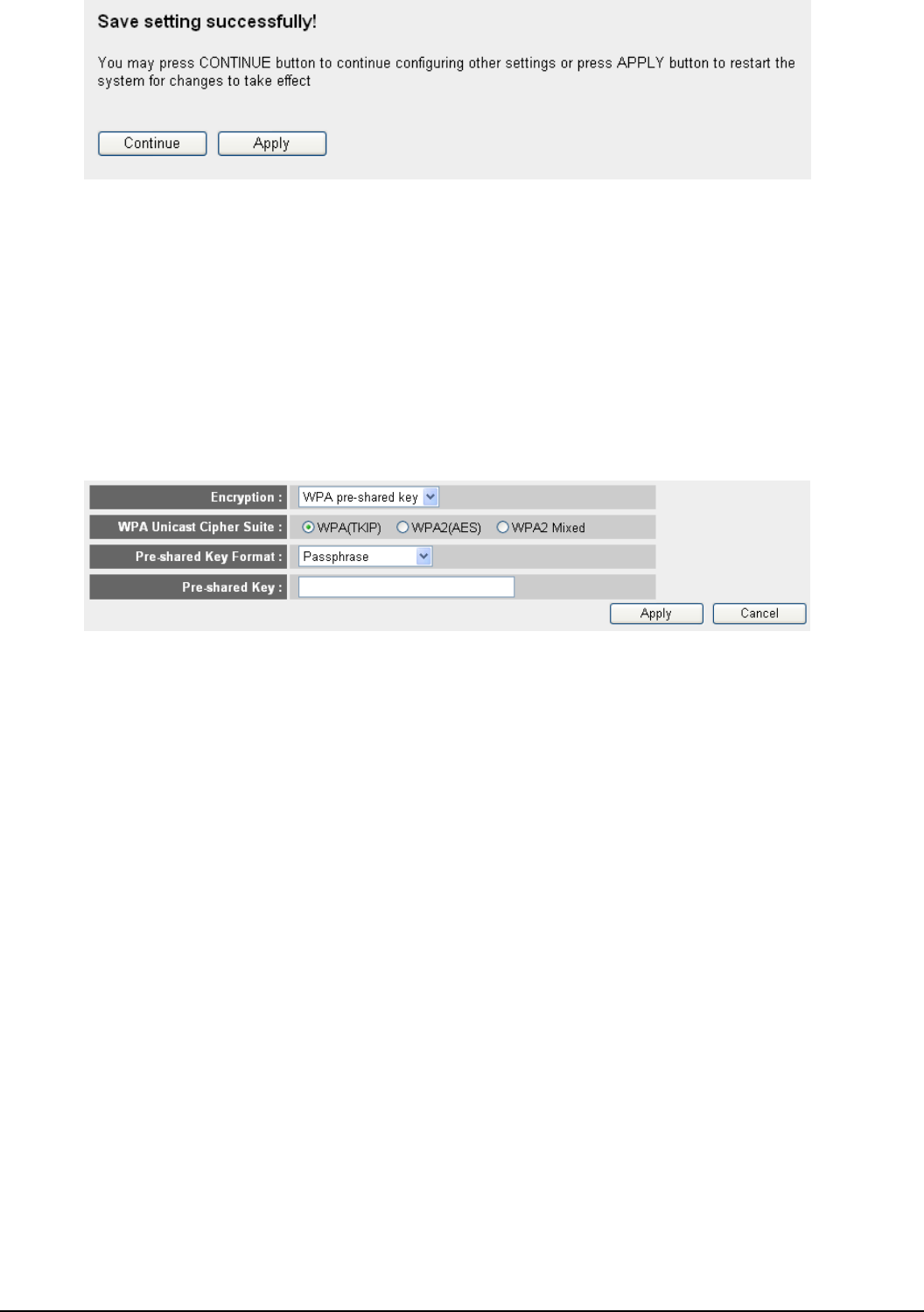
User’s Manual 50
Please click ‘Continue’ to back to previous setup menu; to continue on other setup
procedures, or click ‘Apply’ to reboot the router so the settings will take effect (Please wait
for about 30 seconds while router is rebooting).
Wi-Fi Protected Access (WPA):
When you select this mode, the wireless router will use WPA encryption, and the following
setup menu will be shown on your web browser:
WPA Unicast Cipher Suite:
Please select a type of WPA cipher suite. Available options are: WPA (TKIP), WPA2 (AES),
and WPA2 Mixed. You can select one of them, but you have to make sure your wireless
client support the cipher you selected.
Pre-shared Key Format:
Select the type of pre-shared key, you can select Passphrase (8 or more alphanumerical
characters, up to 63), or Hex (64 characters of 0-9, and a-f).
Pre-shared Key:
Please input the WPA passphrase here. It’s not recommended to use a word that can
be found in a dictionary due to security reason.
After you finish WPA Pre-shared key setting, please click ‘Apply’ button and the following
message will be displayed on your web browser:
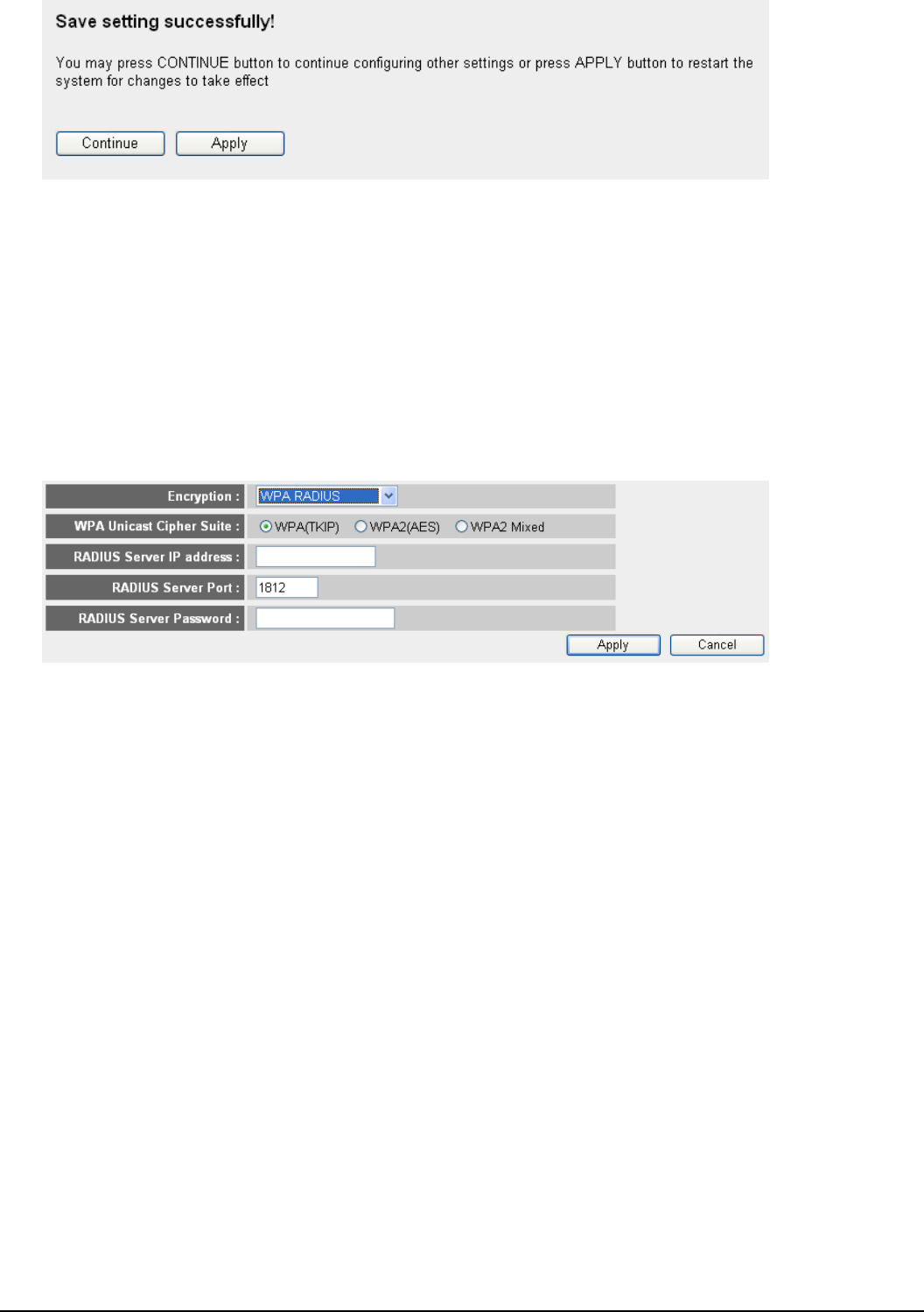
User’s Manual 51
Please click ‘Continue’ to back to previous setup menu; to continue on other setup
procedures, or click ‘Apply’ to reboot the router so the settings will take effect (Please wait
for about 30 seconds while router is rebooting).
WPA RADIUS:
If you have a RADIUS server, this router can work with it and provide safer wireless
authentication.
WPA Unicast Cipher Suite:
Please select a type of WPA cipher suite. Available options are: WPA (TKIP), WPA2 (AES),
and WPA2 Mixed. You can select one of them, but you have to make sure your wireless
client support the cipher you selected.
RADIUS Server IP address:
Please input the IP address of your Radius authentication server here.
RADIUS Server Port:
Please input the port number of your Radius authentication server here. Default setting is
1812.
RADIUS Server Password:
Please input the password of your Radius authentication server here.
After you finish with all settings, please click ‘Apply’ button and the following message will
be displayed on your web browser:
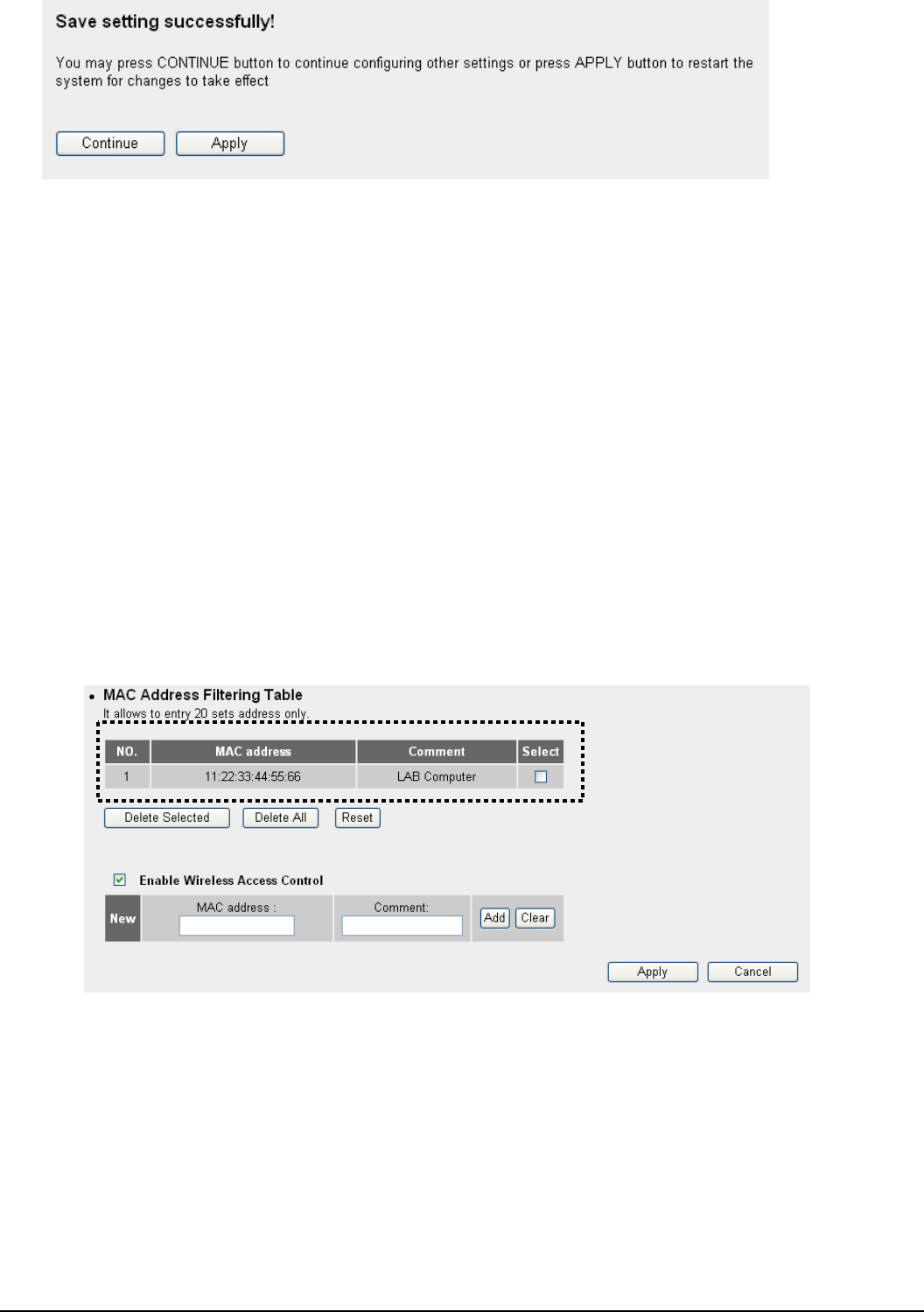
User’s Manual 52
Please click ‘Continue’ to back to previous setup menu; to continue on other setup
procedures, or click ‘Apply’ to reboot the router so the settings will take effect (Please wait
for about 30 seconds while router is rebooting).
Wireless Access Control
This function will help you to prevent unauthorized users from connecting to your wireless
router; only those wireless devices who have the MAC address you assigned here can gain
access to your wireless router. You can use this function with other security measures
described in previous section, to create a safer wireless environment.
Up to 20 MAC addresses can be assigned by using this function. Please click ‘Wireless’
menu on the left of web management interface, then click ‘Access Control’, and the
following message will be displayed on your web browser:
All allowed MAC addresses will be displayed in ‘MAC Address Filtering Table’ (1).
Delete Selected:
If you want to delete a specific MAC address entry, check the ‘select’ box of the MAC
address you want to delete, then click ‘Delete Selected’ button. (You can select more than
one MAC addresses).
Delete All:
If you want to delete all MAC addresses listed here, please click ‘Delete All’ button.
1
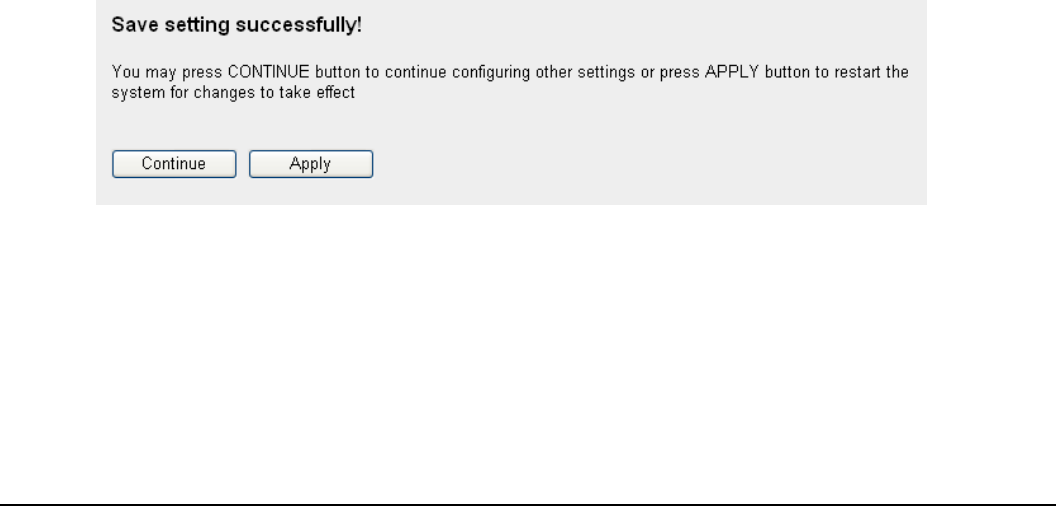
User’s Manual 53
Reset:
You can also click ‘Reset’ button to unselect all MAC addresses.
Enable Wireless Access Control:
To enforce MAC address filtering, you have to check ‘Enable Wireless Access Control’.
When this item is unchecked, wireless router will not enforce MAC address filtering of
wireless clients.
MAC Address:
Input the MAC address of your wireless devices here, dash ( - ) or colon ( : ) are not
required. (i.e. If the MAC address label of your wireless device indicates ‘aa-bb-cc-dd-ee-ff’
or ‘aa:bb:cc:dd:ee:ff’, just input ‘aabbccddeeff’.
Comment:
You can input any text here as the comment of this MAC address, like ‘ROOM 2A
Computer’ or anything. You can input up to 16 alphanumerical characters here. This is
optional and you can leave it blank, however, it’s recommended to use this field to write a
comment for every MAC addresses as a memory aid.
Add:
Click ‘Add’ button to add the MAC address and associated comment to the MAC address
filtering table.
Clear:
Click ‘Clear’ to remove the value you inputted in MAC address and comment field.
After you finish with all settings, please click ‘Apply’ button and the following message will
be displayed on your web browser:
Please click ‘Continue’ to back to previous setup menu; to continue on other setup
procedures, or click ‘Apply’ to reboot the router so the settings will take effect (Please wait
for about 30 seconds while router is rebooting).
If you want to reset all settings in this page back to previously-saved value, please click
‘Cancel’ button.
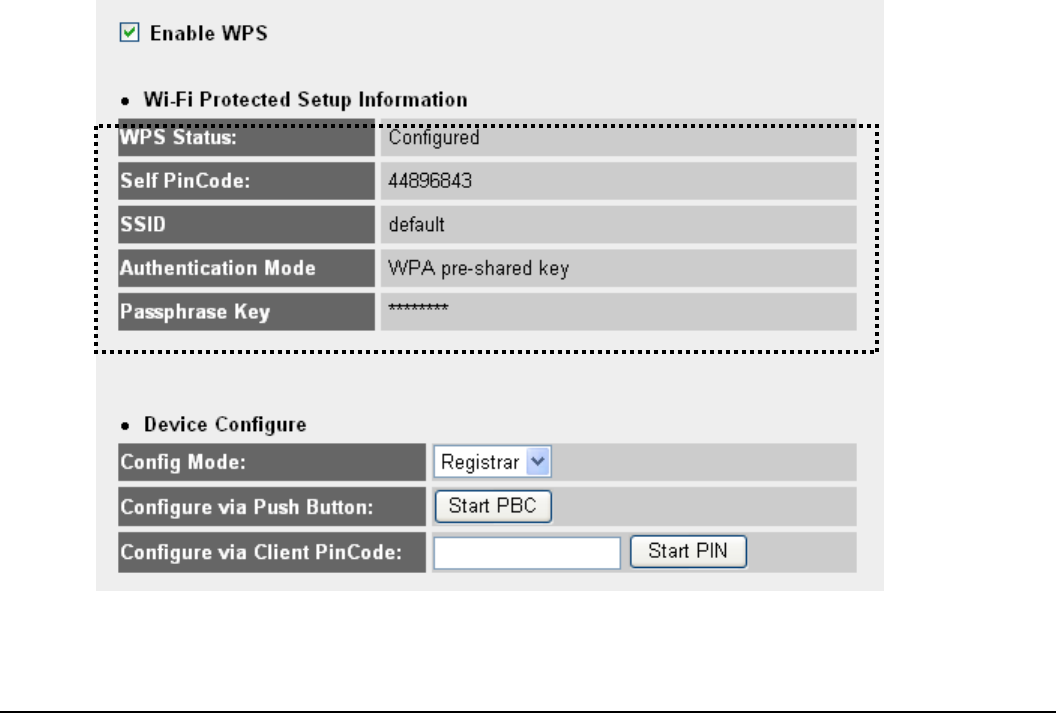
User’s Manual 54
Wi-Fi Protected Setup (WPS)
Wi-Fi Protected Setup (WPS) is the simplest way to build connection between wireless
network clients and this wireless router. You don’t have to select encryption mode and
input a long encryption passphrase every time when you need to setup a wireless client,
you only have to press a button on wireless client and this wireless router, and the WPS
will do the rest for you.
This wireless router supports two types of WPS: Push-Button Configuration (PBC), and PIN
code. If you want to use PBC, you have to push a specific button on the wireless client to
start WPS mode, and switch this wireless router to WPS mode too. You can push
Reset/WPS button of this wireless router, or click ‘Start PBC’ button in the web
configuration interface to do this; if you want to use PIN code, you have to know the PIN
code of wireless client and switch it to WPS mode, then provide the PIN code of the
wireless client you wish to connect to this wireless router. The detailed instructions are
listed follow:
Please click ‘Wireless’ menu on the left of web management interface, then click ‘WPS’,
and the following message will be displayed on your web browser:

User’s Manual 55
Enable WPS:
Check this box to enable WPS function, uncheck it to disable WPS.
Wi-Fi Protected Setup Information:
WPS-related system information will be displayed Setup Information here:
1. WPS Status: If the wireless security (encryption) function of this wireless router is
properly set, you’ll see ‘Configured’ message here. If wireless security function has not
been set, you’ll see ‘unConfigured’.
2. Self PIN code: This is the WPS PIN code of this wireless router. This code is useful
when you need to build wireless connection by WPS with other WPS-enabled
wireless devices.
3. SSID: The SSID of this wireless router will be displayed here.
4. Authentication Mode: The wireless security authentication mode of this wireless router
will be displayed here. If you don’t enable security function of the wireless router before
WPS is activated, the router will auto set the security to WPA (AES) and generate a set
of passphrase key for WPS connection.
5. Passphrase Key: The wireless security key of the router will be displayed here.
Config Mode:
There are ‘Registrar’ and ‘Enrollee’ modes for the WPS connection. When ‘Registrar’ is
enabled, the wireless clients will follow the router’s wireless settings for WPS connection.
When ‘Enrolle’ mode is enabled, the router will follow the wireless settings of wireless client
for WPS connection.
Configure via Push Button:
Click ‘Start PBC’ to start Push-Button style WPS setup procedure. This wireless router will
wait for WPS requests from wireless clients for 2 minutes. The ‘WLAN’ LED on the wireless
router will be steady on for 2 minutes when this wireless router is waiting for incoming WPS
request.
Configure via client PinCode:
Please input the PIN code of the wireless client you wish to connect, and click ‘Start PIN’
button. The ‘WLAN’ LED on the wireless router will be steady on when this wireless router
is waiting for incoming WPS request.
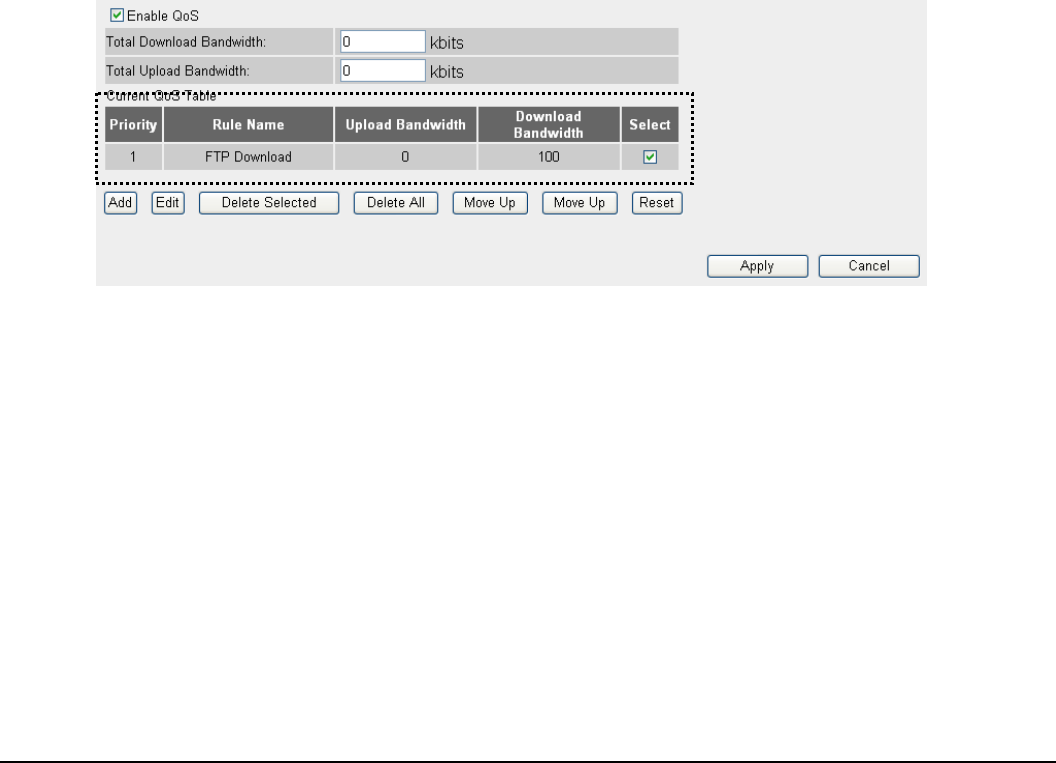
User’s Manual 56
4.6 Quality of Service (QoS)
Quality of service provides an efficient way for computers on the network to share the
internet bandwidth with a promised quality of internet service. Without QoS, all computers
and devices on the network will compete with each other to get internet bandwidth, and
some applications which require guaranteed bandwidth (like video streaming and network
telephone) will be affected, therefore an unpleasing result will occur, like the interruption of
video / audio transfer.
With this function, you can limit the maximum bandwidth or give a guaranteed bandwidth
for a specific computer, to avoid said unpleasing result from happening.
Basic QoS Settings
Please follow the following instructions to set QoS parameters:
Please click ‘Qos’ menu on the left of web management interface and the following
message will be displayed on your web browser:
Enable QoS:
Check this box to enable QoS function, unselect this box if you don’t want to enforce QoS
bandwidth limitations.
Total Download Bandwidth:
You can set the limit of total download bandwidth in kbits. To disable download bandwidth
limitation, input ‘0’ here.
Total Upload Bandwidth:
You can set the limit of total upload bandwidth in kbits. To disable upload bandwidth
limitation, input ‘0’ here.
Current QoS Table:
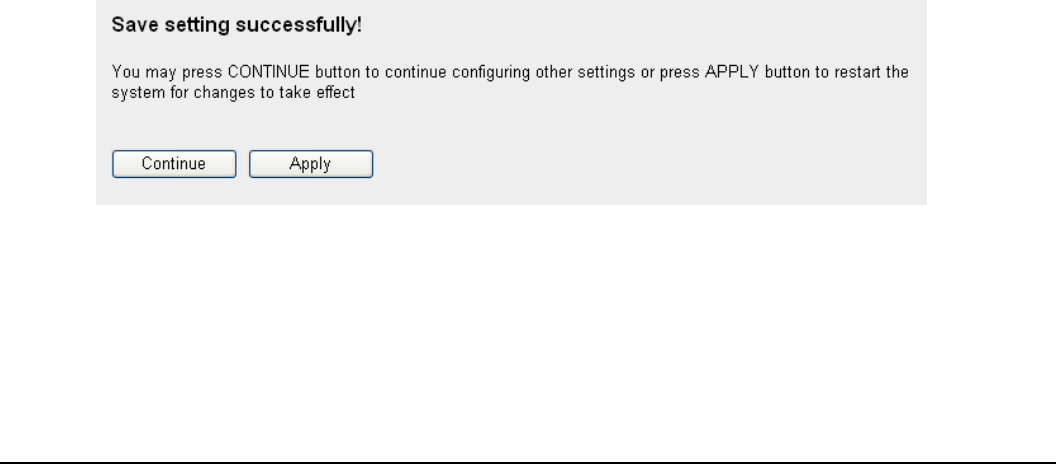
User’s Manual 57
All existing QoS rules will be displayed here.
Add:
Click ‘add’ button to add a new QoS rule, see ‘Add a new QoS rule’ below.
Edit:
If you want to modify the content of a specific rule, please check the ‘select’ box of the rule
you want to edit, then click ‘Edit’ button. Only one rule should be selected a time! If you
didn’t select a rule before clicking ‘Edit’ button, you’ll be prompted to add a new rule.
Delete Selected:
You can delete selected rules by clicking this button. You can select one or more rules to
delete by check the ‘select’ the box of the rule(s) you want to delete a time. If the QoS table
is empty, this button will be grayed out and can not be clicked.
Delete All:
By clicking this button, you can delete all rules currently in the QoS table. If the QoS table
is empty, this button will be grayed out and can not be clicked.
Move Up:
You can pull up the priority of the QoS rule you selected by clicking this button.
Move Down:
You can lower the priority of the QoS rule you selected by clicking this button.
Reset:
If you want to erase all values you just entered. Click ‘Reset’.
After you finish with all settings, please click ‘Apply’ button and the following message will
be displayed on your web browser:
Please click ‘Continue’ to back to previous setup menu; to continue on other setup
procedures, or click ‘Apply’ to reboot the router so the settings will take effect (Please wait
for about 30 seconds while router is rebooting).
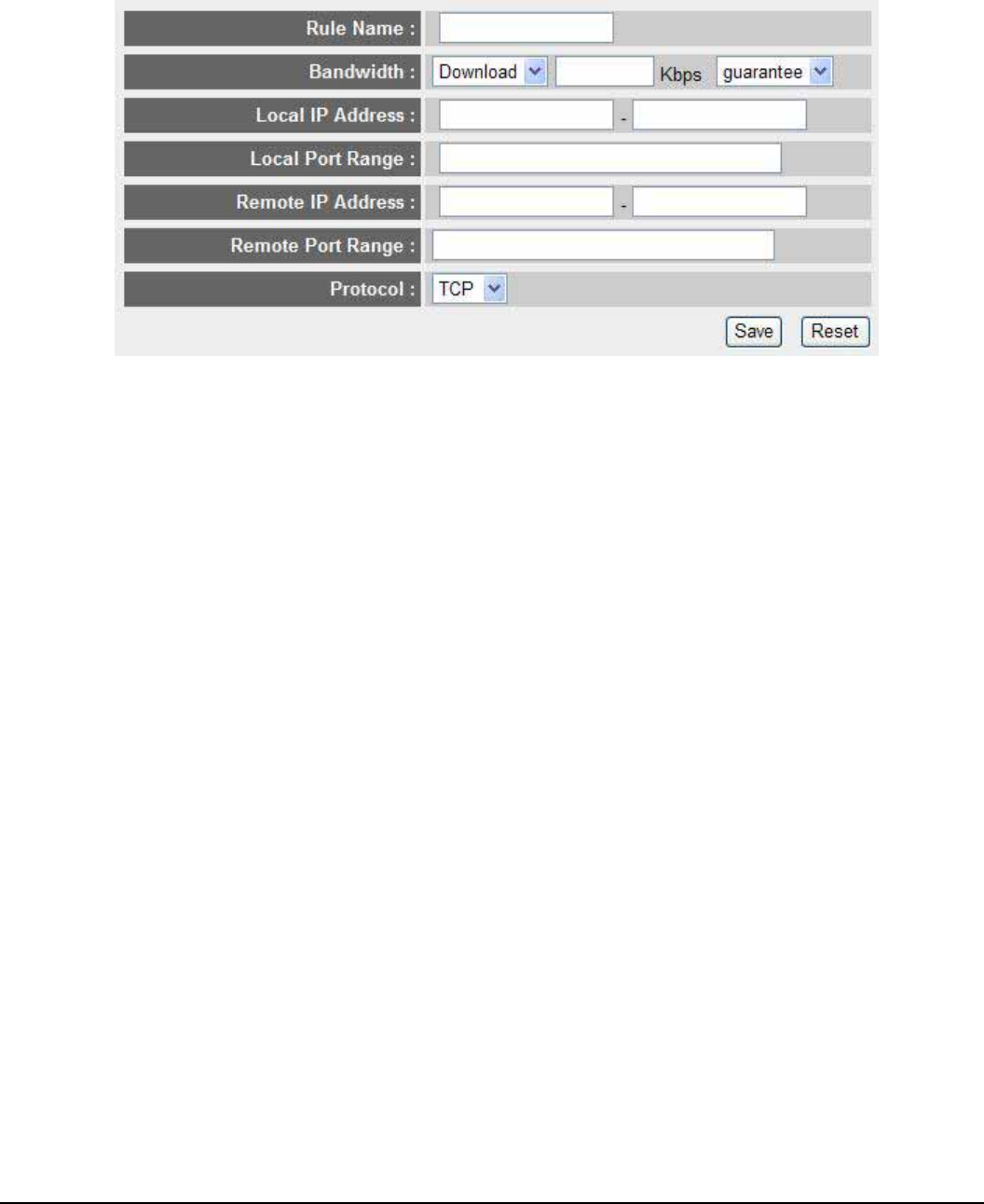
User’s Manual 58
If you want to reset all settings in this page back to previously-saved value, please click
‘Cancel’ button.
Add a new QoS rule
After you click ‘Add’ button in QoS menu, the following message will appear:
Rule Name:
Please give a name to this QoS rule (up to 15 alphanumerical characters)
Bandwidth:
Set the bandwidth limitation of this QoS rule. You have to select the data direction of this
rule (Upload of Download), and the speed of bandwidth limitation in Kbps, then select the
type of QoS: ‘guarantee’ (guaranteed usable bandwidth for this rule) or ‘max’ (set the
maximum bandwidth for the application allowed by this rule).
Local IP Address:
Specify the local (source) IP address that will be affected by this rule. Please input the
starting IP address in the left field, and input the end IP address in the right field to define a
range of IP addresses, or just input the IP address in the left field to define a single IP
address.
Local Port Range:
Please input the range of local (source) port number that will be affected by this rule. If you
want to apply this rule on port 80 to 90, please input ’80-90’; if you want to apply this rule
on a single port, just input the port number, like ‘80’.
Remote IP Address:
Specify the remote (destination) IP address that will be affected by this rule. Please input
the starting IP address in the left field, and input the end IP address in the right field to

User’s Manual 59
define a range of IP addresses, or just input the IP address in the left field to define a single
IP address.
Remote Port Range:
Please input the range of remote (destination) port number that will be affected by this rule.
If you want to apply this rule on port 80 to 90, please input ’80-90’; if you want to apply this
rule on a single port, just input the port number, like ‘80’. If the remote (destination) IP
address and /or port number is universal, just leave it blank.
Protocol:
Please select the protocol type of this rule, available options are TCP and UDP. If you don’t
know what protocol your application uses, please try ‘TCP’ first, and switch to ‘UDP’ if this
rule doesn’t seems to work.
After you finish with all settings, please click ‘save’ button, you’ll be brought back to
previous menu, and the rule you just set will appear in current QoS table; if you did
anything wrong, you’ll get an error message when you click ‘Save’ button, please correct
your input by the instructions given by the error message.
If you want to erase all values you just entered. Click ‘Reset’
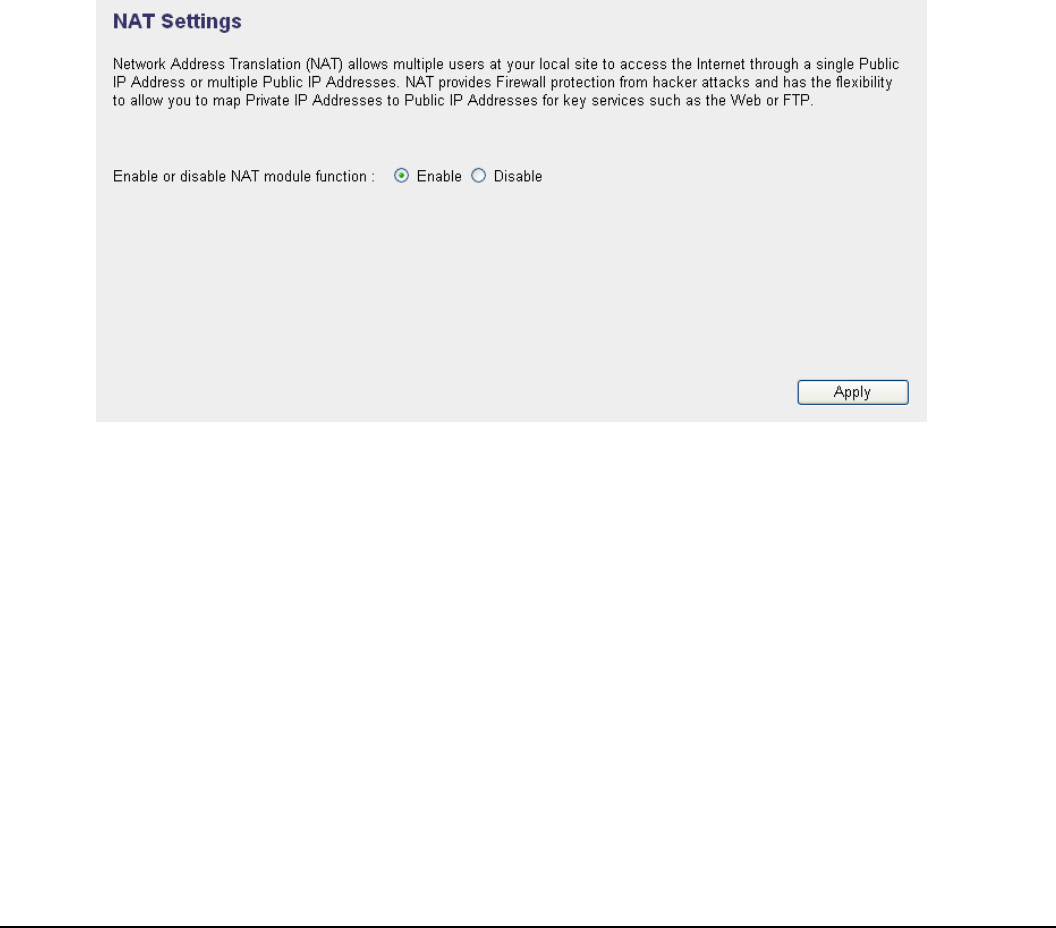
User’s Manual 60
4.7 Network Address Translation (NAT)
Network address translations solve the problem if sharing a single IP address to multiple
computers. Without NAT, all computers must be assigned with a valid Internet IP address
to get connected to Internet, but Internet service providers only provide very few IP
addresses to every user. Therefore it’s necessary to use NAT technology to share a single
Internet IP address to multiple computers on local network, so everyone can get connected
to Internet.
Please follow the following instructions to set NAT parameters:
Basic NAT Settings (Enable or disable NAT function)
Please click ‘NAT’ menu on the left of web management interface, and the following
message will be displayed on your web browser:
To enable NAT function, please select ‘Enable’ for ‘Enable NAT module function’; to
disable, please select ‘Disable’.
After you made the selection, please click ‘Apply’ button and the following message will be
displayed on your web browser:
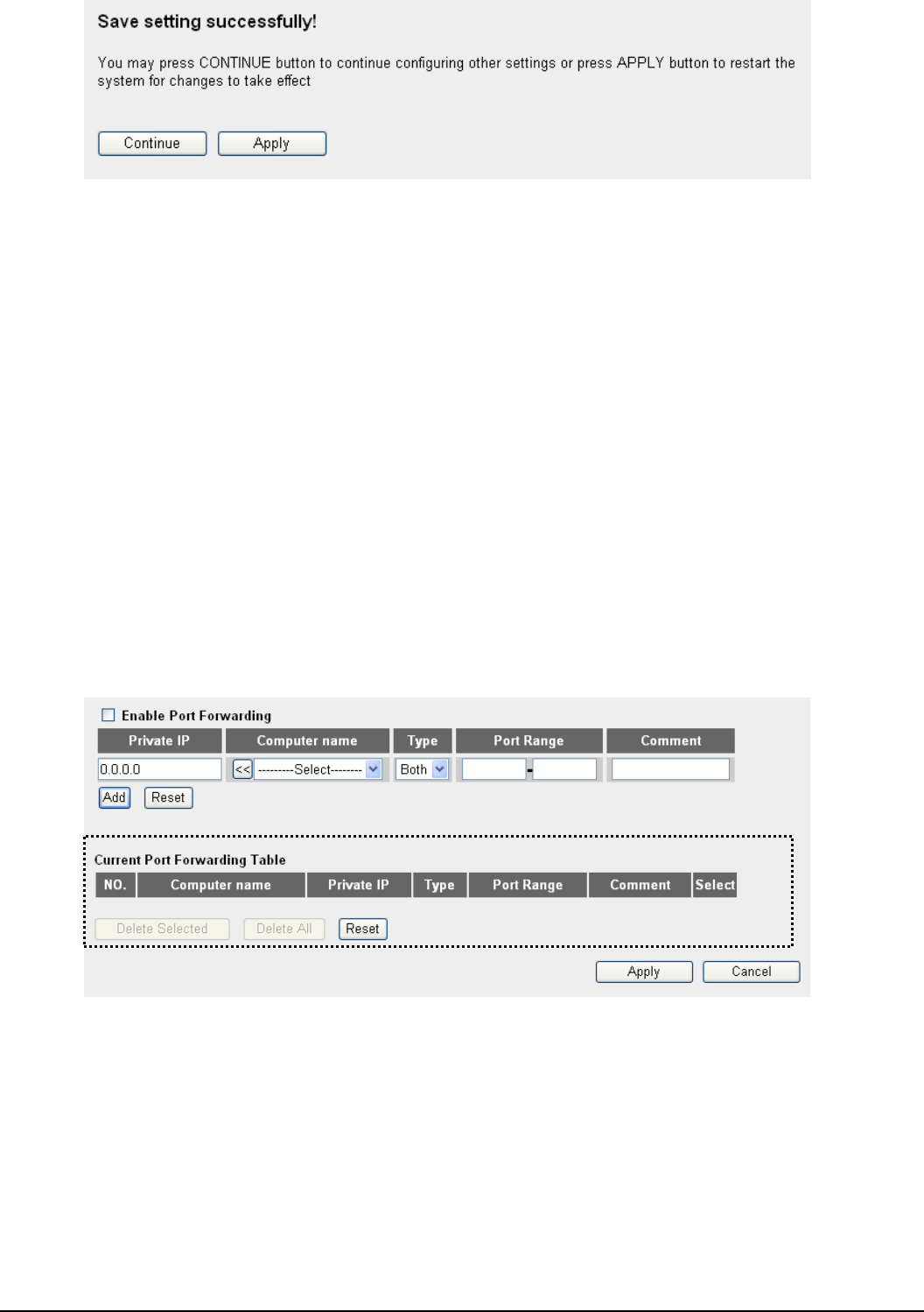
User’s Manual 61
Please click ‘Continue’ to back to previous setup menu; to continue on other setup
procedures, or click ‘Apply’ to reboot the router so the settings will take effect (Please wait
for about 30 seconds while router is rebooting).
Port Forwarding
This function allows you to redirect a single port or consecutive ports of Internet IP address
to the same port of the IP address on local network. The port number(s) of Internet IP
address and private IP address (the IP address on local network) must be the same. If the
port number of Internet IP address and private IP address is different, please use ‘Virtual
Server’ function, described in next section.
Please click ‘NAT’ menu on the left of web management interface, then click ‘Port
Forwarding’, and the following message will be displayed on your web browser:
Enable Port Forwarding:
Check this box to enable port mapping, and uncheck this box to disable port mapping.
Private IP:
Input the IP address of the computer on local network which provides internet service.
Computer Name:
Pull down the menu and all the computers connected to the router will be listed here. You
can easily to select the computer name without checking the IP address of the computer.
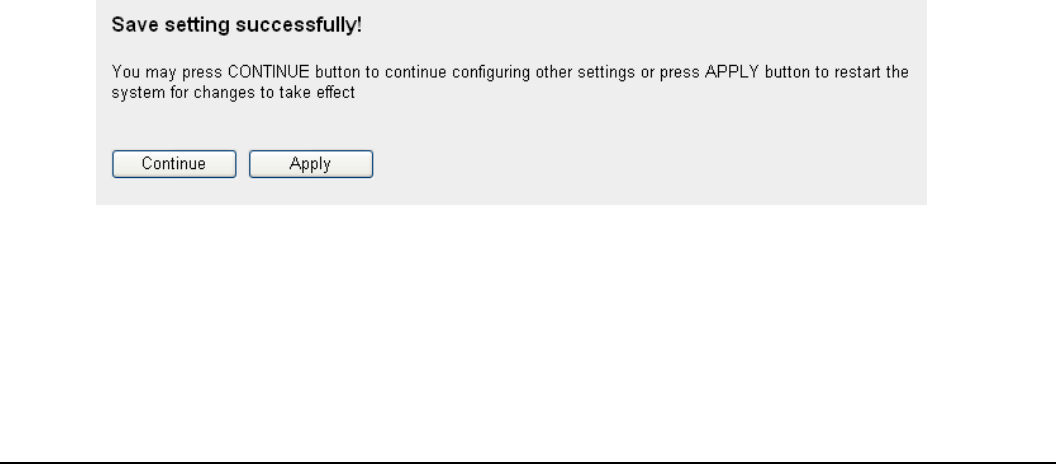
User’s Manual 62
Type:
Select the type of connection, TCP or UDP. If you’re not sure, please select ‘Both’.
Port Range:
Input the starting port number in the left field, and input the ending port number in the right
field. If you only want to redirect a single port number, just fill the port number in the left
field.
Comment:
Please input any text to describe this mapping, up to 16 alphanumerical characters.
Add:
Add the mapping to port forwarding table.
Reset:
Remove all inputted values.
Port Forwarding Table:
All existing port forwarding mappings will be displayed here.
Delete Selected:
Please select a port forwarding mapping by clicking the ‘Select’ box of the mapping, then
click ‘Delete Selected’ button to remove the mapping. If there’s no existing mapping, this
button will be grayed out.
Delete All:
Delete all mappings existed in virtual server table.
Reset:
Unselect all mappings.
After you finish with all settings, please click ‘Apply’ button and the following message will
be displayed on your web browser:
Please click ‘Continue’ to back to previous setup menu; to continue on other setup
procedures, or click ‘Apply’ to reboot the router so the settings will take effect (Please wait
for about 30 seconds while router is rebooting).
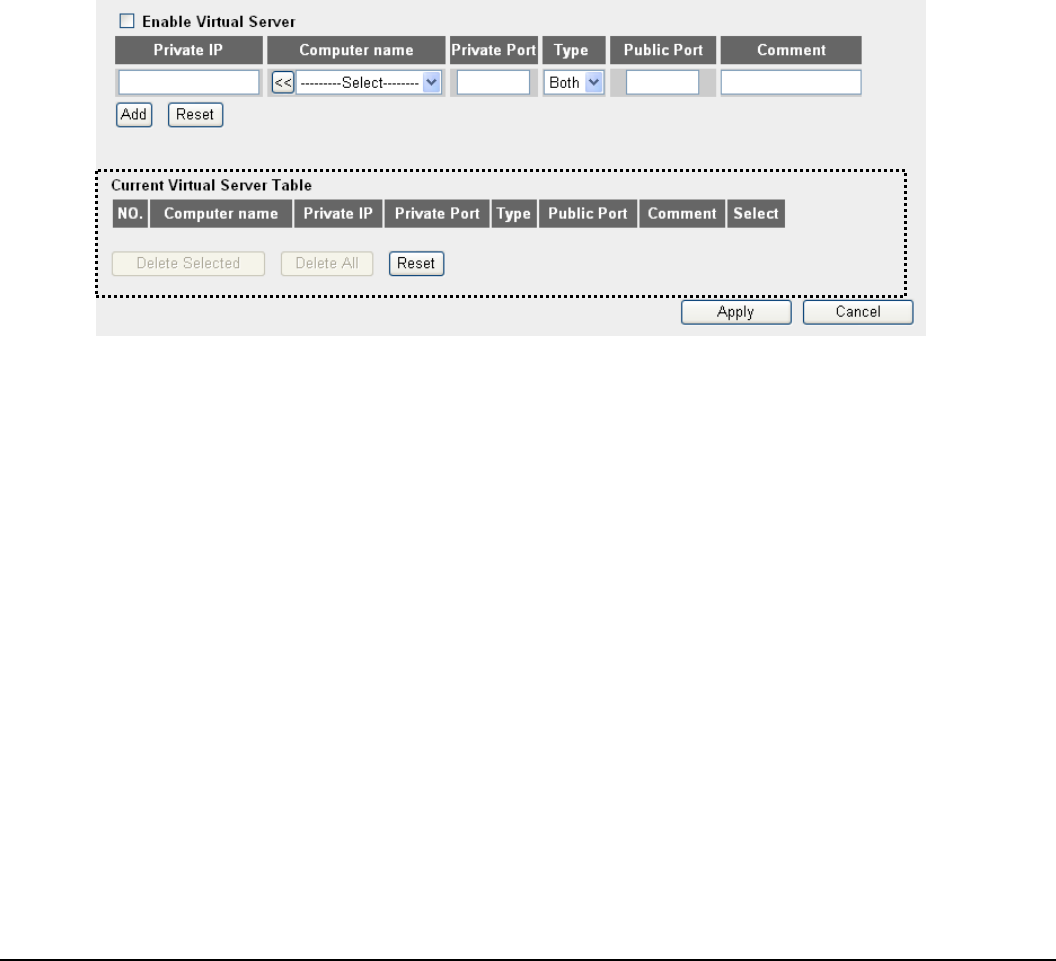
User’s Manual 63
If you want to reset all settings in this page back to previously-saved value, please click
‘Cancel’ button.
Virtual Server
This function allows you to redirect a port on Internet IP address (on WAN port) to a
specified port of an IP address on local network, so you can setup an Internet service on
the computer on local network, without exposing it on Internet directly. You can also build
many sets of port redirection, to provide many different Internet services on different local
computers via a single Internet IP address.
Please click ‘NAT’ menu on the left of web management interface, then click ‘Virtual Server’,
and the following message will be displayed on your web browser:
Enable Virtual Server:
Check this box to enable virtual server, and uncheck this box to disable virtual server.
Private IP:
Input the IP address of the computer which provides Internet service.
Computer Name:
Pull down the menu and all the computers connected to the router will be listed here. You
can easily to select the computer name without checking the IP address of the computer.
Private Port:
Input the port number of the IP address which provides Internet service.
Type:
Select the type of connection, TCP or UDP. If you’re not sure, please select ‘Both’.
Public Port:
Please select the port number of Internet IP address which will be redirected to the port
number of local IP address defined above.
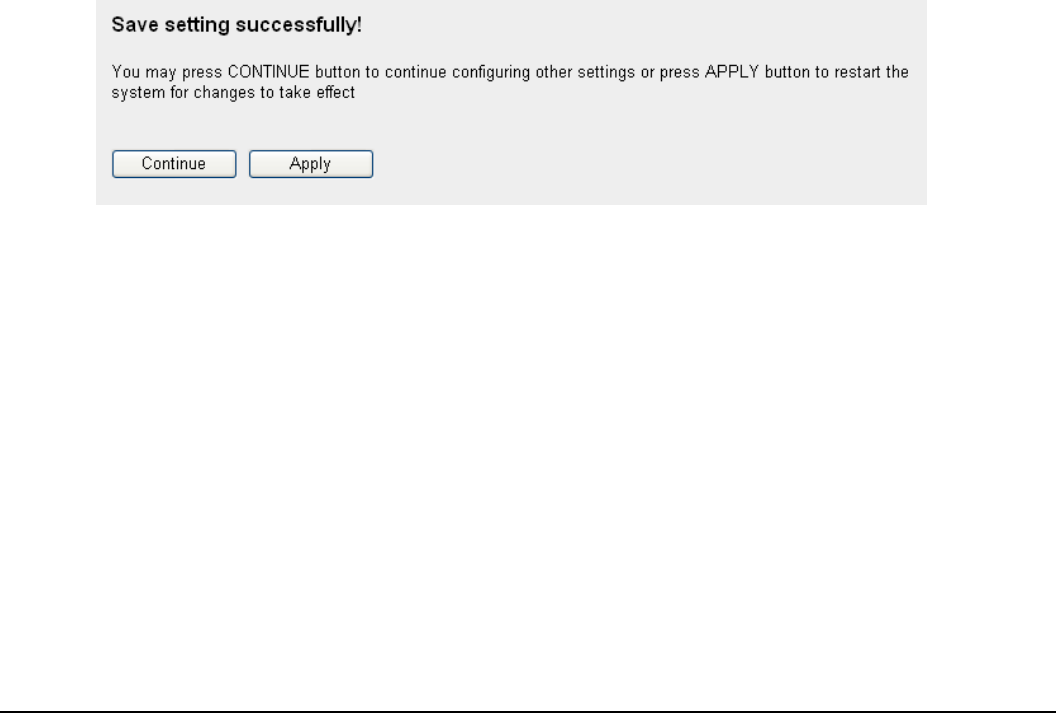
User’s Manual 64
Comment:
Please input any text to describe this mapping, up to 16 alphanumerical characters.
Add:
Add the mapping to virtual server table.
Reset:
Remove all inputted values.
Virtual Server Table:
All existing virtual server mappings will be displayed here.
Delete Selected:
Please select a virtual server mapping by clicking the ‘Select’ box of the mapping, then
click ‘Delete Selected’ button to remove the mapping. If there’s no existing mapping, this
button will be grayed out.
Delete All:
Delete all mappings existed in virtual server table.
Reset:
Unselect all mappings.
After you finish with all settings, please click ‘Apply’ button and the following message will
be displayed on your web browser:
Please click ‘Continue’ to back to previous setup menu; to continue on other setup
procedures, or click ‘Apply’ to reboot the router so the settings will take effect (Please wait
for about 30 seconds while router is rebooting).
If you want to reset all settings in this page back to previously-saved value, please click
‘Cancel’ button.
Port Mapping for Special Applications:
Some applications require more than one connection a time; these applications won’t work
with simple NAT rules. In order to make these applications work, you can use this function
to let these applications work.
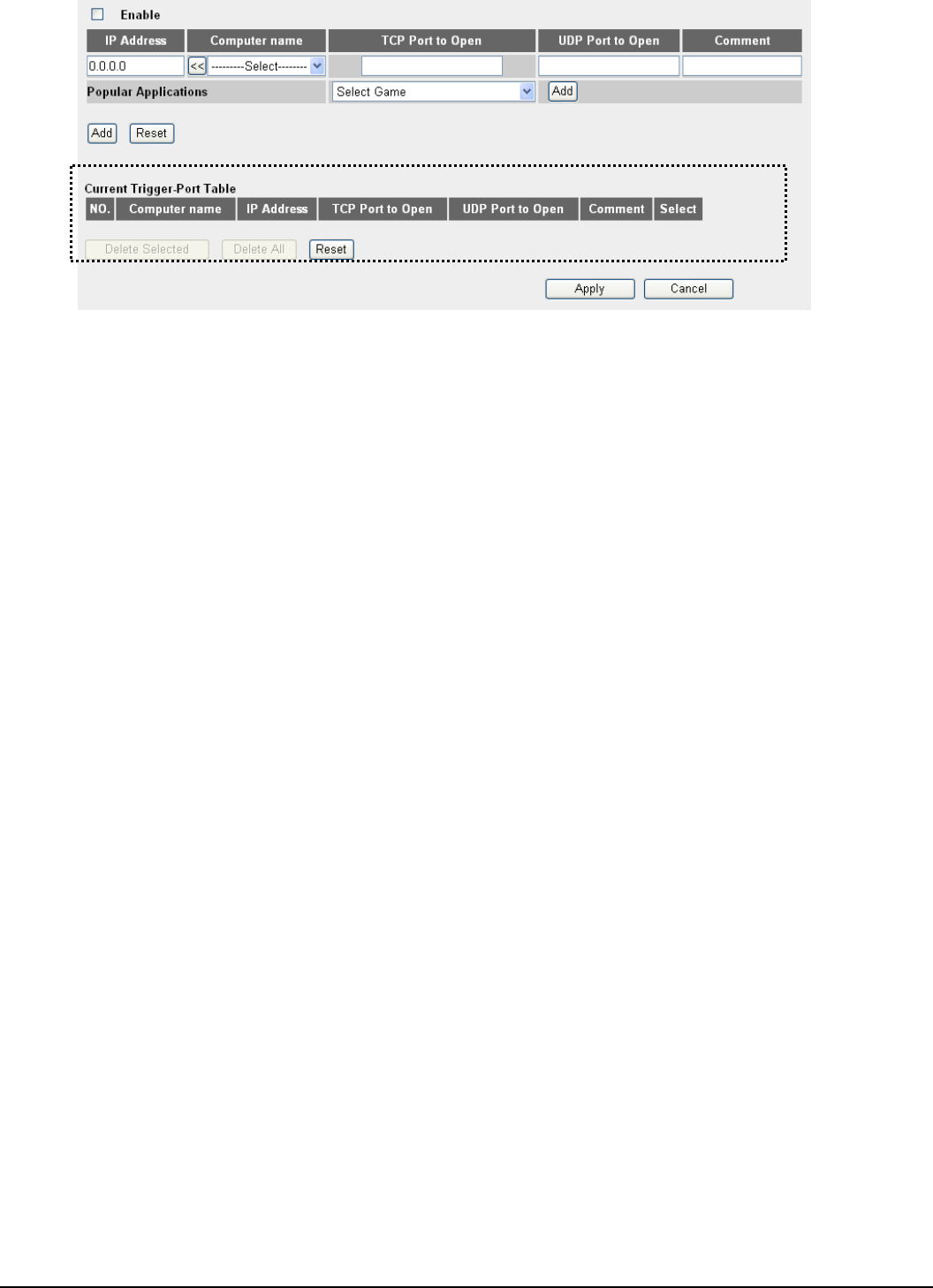
User’s Manual 65
Enable:
Check this box to enable special applications and uncheck this box to disable virtual server.
IP Address:
Input the IP address of the computer which you want to open the ports.
Computer Name:
Pull down the menu and all the computers connected to the router will be listed here. You
can easily to select the computer name without checking the IP address of the computer.
TCP Port to Open:
This is the out going (Outbound) range of TCP port numbers for this particular application.
UDP Port to Open:
This is the out going (Outbound) range of UDP port numbers for this particular application.
Comment:
The description of this setting.
Popula Applications:
This section lists the more popular applications that require multiple connections. Select an
application from the Popular Applications selection and click ‘Add’ to save the setting to
‘Current Trigger-Port Table.’
Add:
Add the setting to the ‘Current Trigger-Port Table.’
Reset:
Click ‘Reset’ will clear all above setting and you can set up again.
Current Trigger-Port:
All the settings for the special applications will be listed here. If you want to remove some
Special Application settings from the " Current Trigger-Port Table", select the Special
Application settings you want to remove in the table and then click "Delete Selected". If you
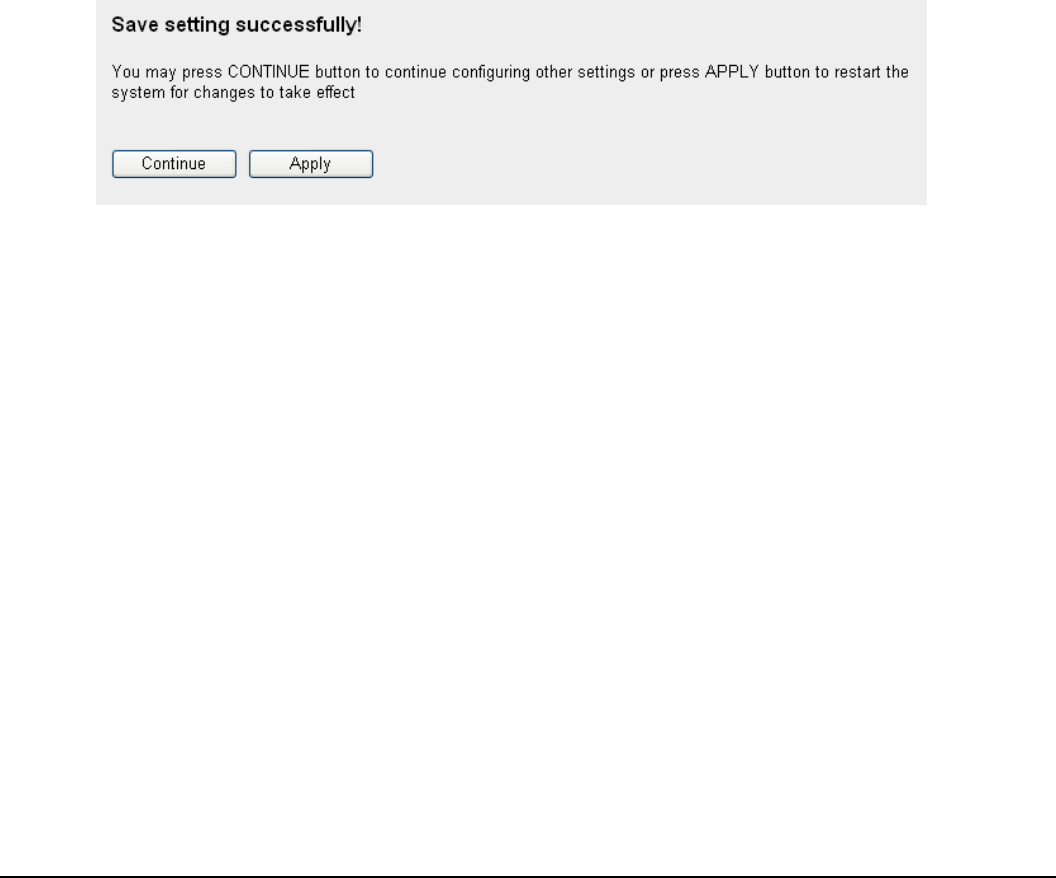
User’s Manual 66
want remove all Special Appliacation settings from the table, just click "Delete All" button.
Click "Reset" will clear your current selections.
Delete Selected:
Please select a special application by clicking the ‘Select’ box of the mapping, then click
‘Delete Selected’ button to remove the setting. If there’s no setting here, this button will be
grayed out.
Delete All:
Delete all settings existed in trigger port table.
Reset:
Unselect all settings.
Note: Only one LAN client can use a particular special application at a time.
After you finish with all settings, please click ‘Apply’ button and the following message will
be displayed on your web browser:
Please click ‘Continue’ to back to previous setup menu; to continue on other setup
procedures, or click ‘Apply’ to reboot the router so the settings will take effect (Please wait
for about 30 seconds while the router is rebooting).
If you want to reset all settings in this page back to previously-saved value, please click
‘Cancel’ button.
UPnP Setting
This function enables network auto-configuration for peer-to-peer communications, with this
function, network devices will be able to communicate with other devices directly, and learn
about information about other devices. Many network device and applications rely on UPnP
function nowadays.
Please click ‘NAT’ menu on the left of web management interface, then click ‘UPnP’, and
the following message will be displayed on your web browser:
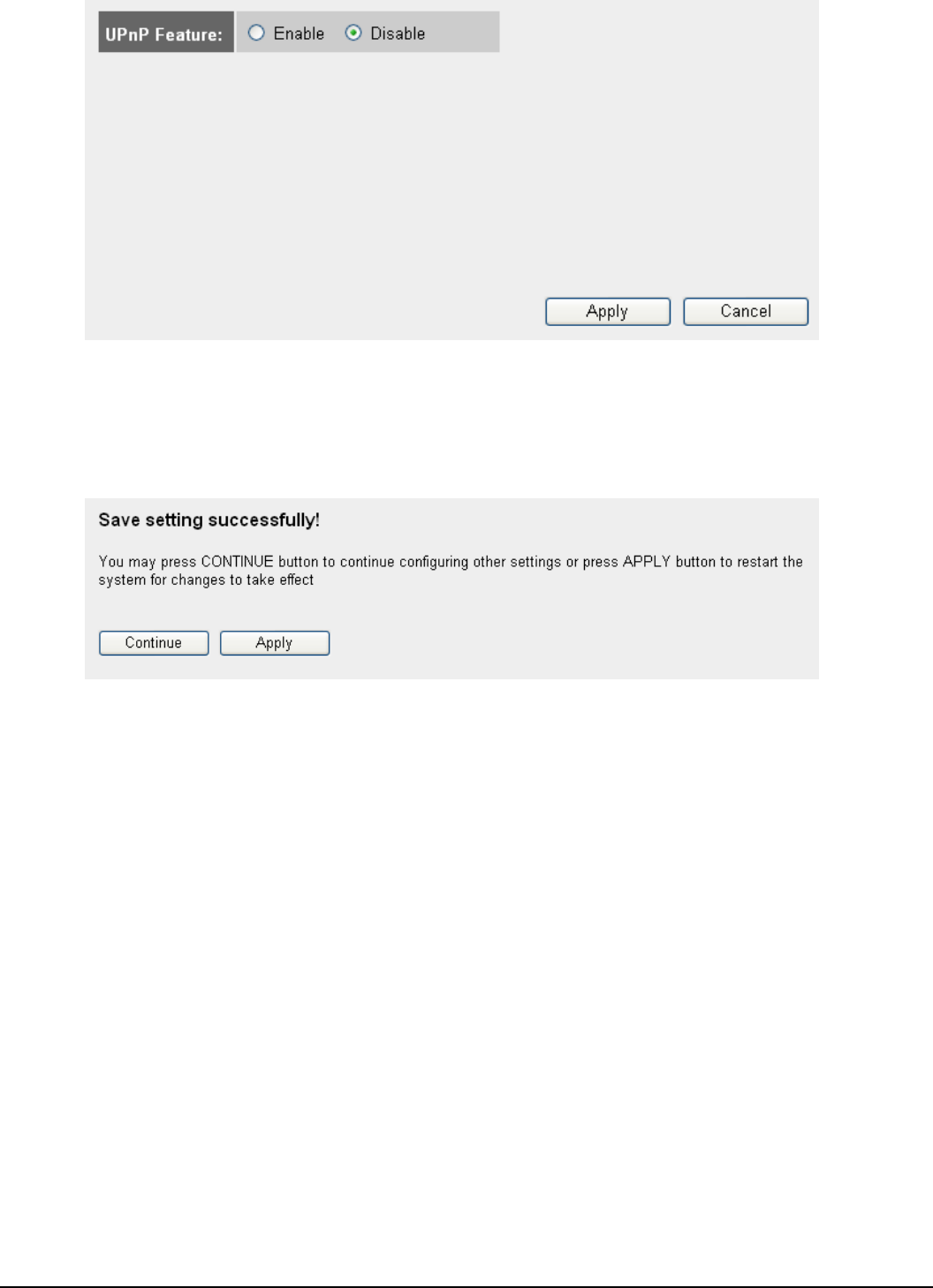
User’s Manual 67
There is only one option in this page, please select ‘Enable’ or ‘Disable’ to enable or
disable UPnP function, then click ‘Apply’ button, and the following message will be
displayed on your web browser:
Please click ‘Continue’ to back to previous setup menu; to continue on other setup
procedures, or click ‘Apply’ to reboot the router so the settings will take effect (Please wait
for about 30 seconds while router is rebooting).
If you want to reset all settings in this page back to previously-saved value, please click
‘Cancel’ button.
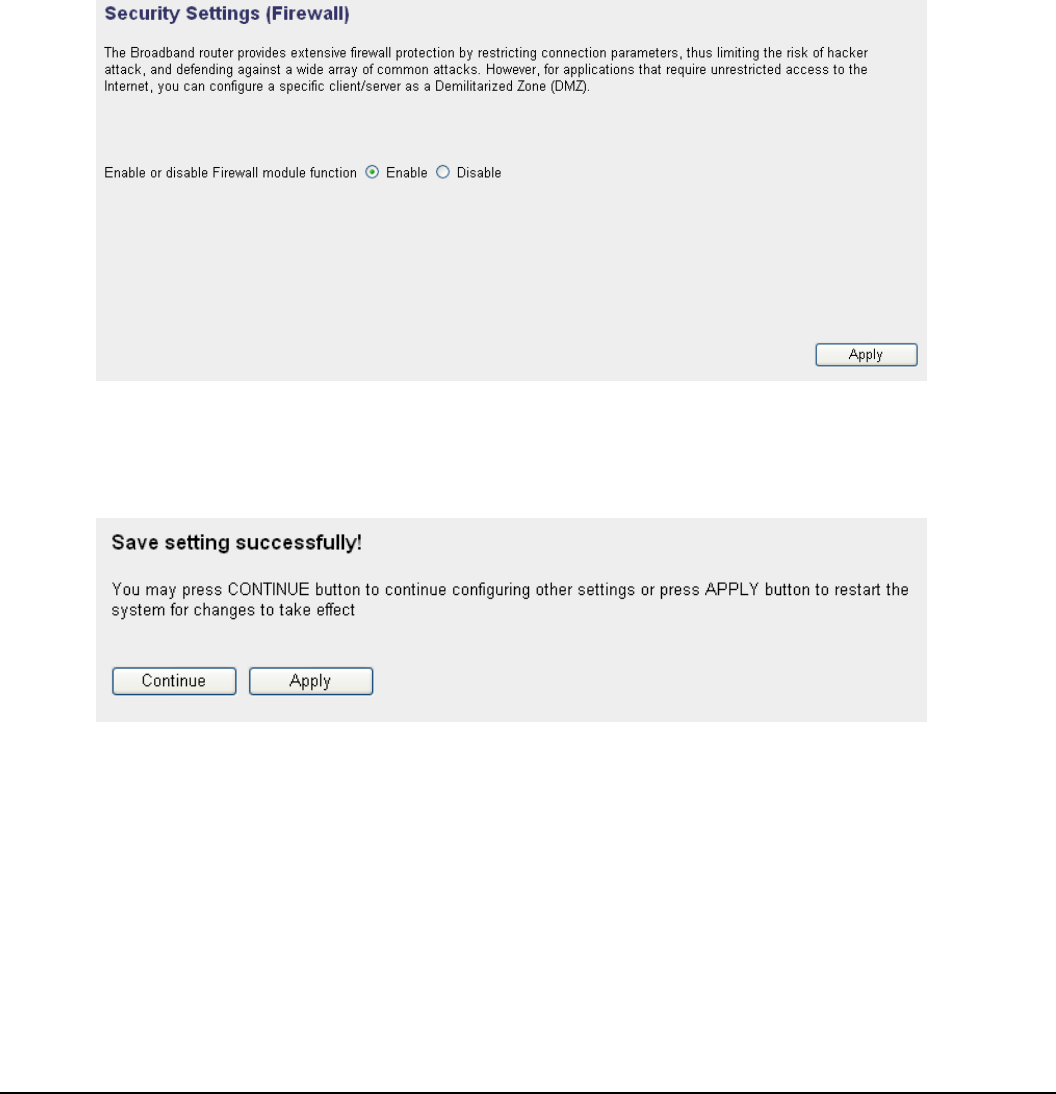
User’s Manual 68
4.8 Firewall
Excepting NAT, this router also provides firewall function to block malicious intruders from
accessing your computers on local network. These functions include inbound attack
prevention, and block outbound traffics, like block URLs which have pre-defined keywords.
Please follow the following instructions to enable or disable firewall function:
Please click ‘Firewall’ menu on the left of web management interface, and the following
message will be displayed on your web browser:
Please select ‘Enable’ or ‘Disable’ to enable or disable firewall function of this router, the
click ‘Apply’ button, and the following message will be displayed on your web browser:
Please click ‘Continue’ to back to previous setup menu; to continue on other setup
procedures, or click ‘Apply’ to reboot the router so the settings will take effect (Please wait
for about 30 seconds while router is rebooting).
Access Control
This function allows or denies computers with specific MAC address from connecting to the
network; it can also allow or deny computers with specific IP address, protocol, or port.
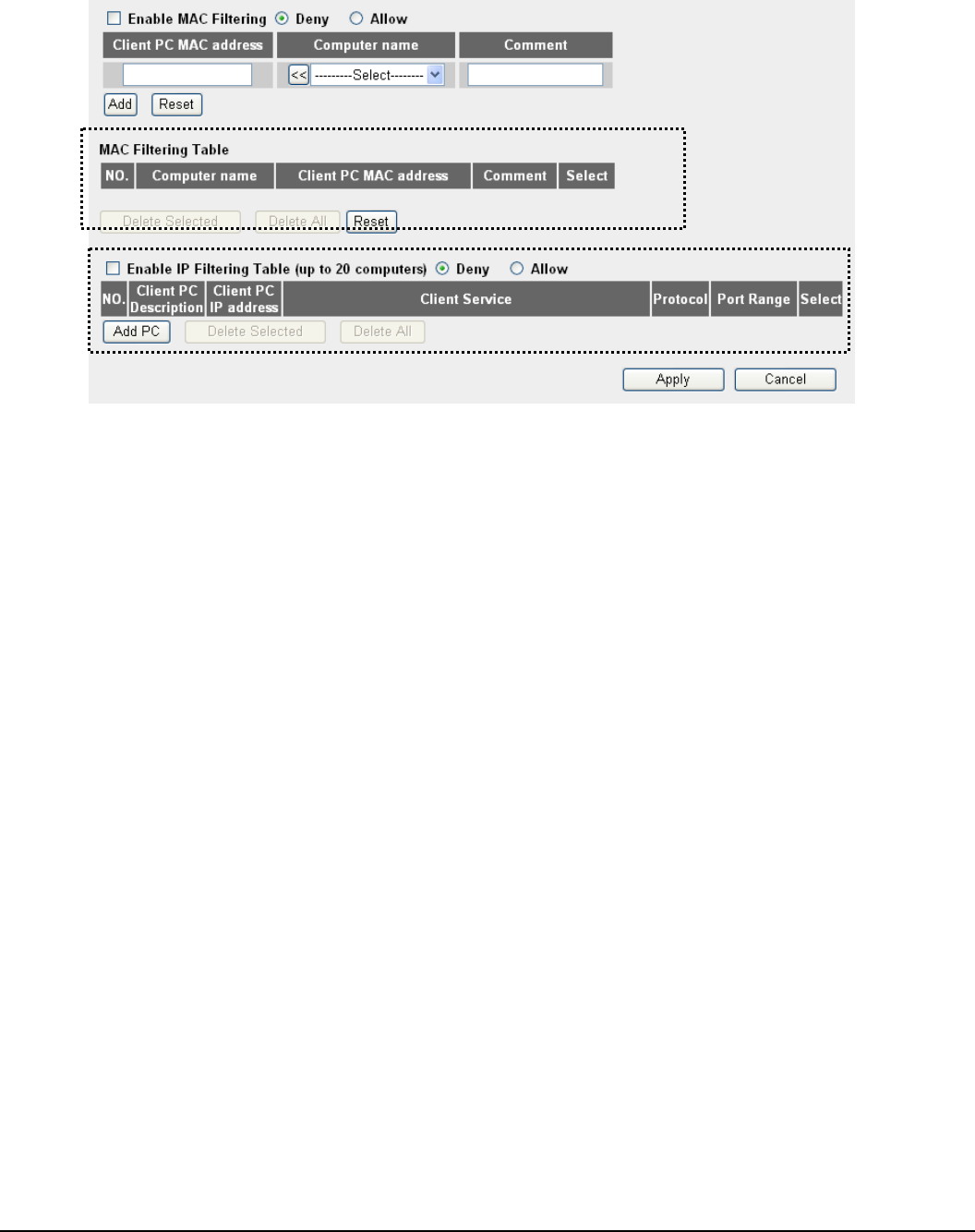
User’s Manual 69
Please click ‘Firewall’ menu on the left of web management interface, then click ‘Access
Control’, and the following message will be displayed on your web browser:
Enable MAC Filtering:
Check this box to enable MAC address based filtering, and please select ‘Deny’ or ‘Allow’
to decide the behavior of MAC filtering table. If you select deny, all MAC addresses listed in
filtering table will be denied from connecting to the network; if you select allow, only MAC
addresses listed in filtering table will be able to connect to the network, and rejecting all
other network devices.
Client PC MAC address:
Please input the MAC address of computer or network device here, dash ( - ) or colon ( : )
are not required. (i.e. If the MAC address label of your wireless device indicates ‘aa-bb-cc-
dd-ee-ff’ or ‘aa:bb:cc:dd:ee:ff’, just input ‘aabbccddeeff’
Computer Name:
Pull down the menu and all the computers connected to the router will be listed here. You
can easily to select the computer name without checking the IP address of the computer.
Comment:
You can input any text here as the comment of this MAC address, like ‘ROOM 2A
Computer’ or anything. You can input up to 16 alphanumerical characters here. This is
optional and you can leave it blank, however, it’s recommended to use this field to write a
comment for every MAC addresses as a memory aid.
Add:

User’s Manual 70
Click ‘Add’ button to add the MAC address and associated comment to the MAC address
filtering table.
Reset:
Remove all inputted values.
MAC Filtering Table:
All existing MAC addresses in filtering table will be listed here.
Delete Selected:
If you want to delete a specific MAC address entry, check the ‘select’ box of the MAC
address you want to delete, then click ‘Delete Selected’ button. (You can select more than
one MAC addresses).
Delete All:
If you want to delete all MAC addresses listed here, please click ‘Delete All’ button.
Reset:
You can also click ‘Reset’ button to unselect all MAC addresses.
Enable IP Filtering Table:
Check this box to enable IP address based filtering, and please select ‘Deny’ or ‘Allow’ to
decide the behavior of IP filtering table. If you select deny, all IP addresses listed in filtering
table will be denied from connecting to the network; if you select allow, only IP addresses
listed in filtering table will be able to connect to the network, and rejecting all other network
devices.
IP Filtering Table:
All existing IP addresses in filtering table will be listed here.
Add PC:
Click this button to add a new IP address to IP filtering table, up to 20 IP addresses can be
added. Please refer to section ‘Add PC’ below.
Delete Selected:
If you want to delete a specific IP address entry, check the ‘select’ box of the IP address
you want to delete, then click ‘Delete Selected’ button. (You can select more than one IP
addresses).
Delete All:
If you want to delete all IP addresses listed here, please click ‘Delete All’ button.
After you finish with all settings, please click ‘Apply’ button and the following message will
be displayed on your web browser:

User’s Manual 71
Please click ‘Continue’ to back to previous setup menu; to continue on other setup
procedures, or click ‘Apply’ to reboot the router so the settings will take effect (Please wait
for about 30 seconds while router is rebooting).
If you want to reset all settings in this page back to previously-saved value, please click
‘Cancel’ button.
Add PC
After button is clicked, the following message will be displayed on your web browser:
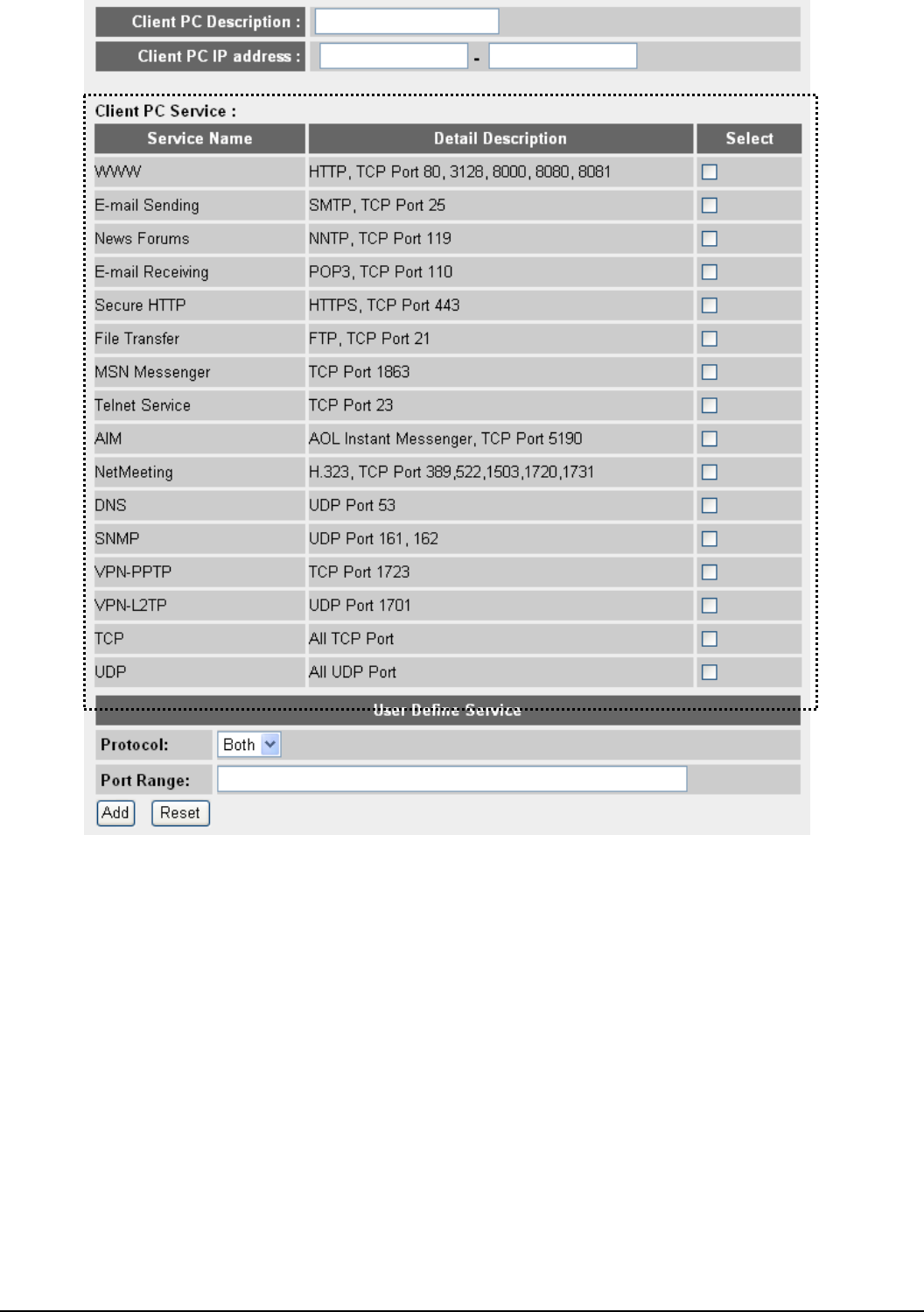
User’s Manual 72
Client PC Description:
Please input any text to describe this IP address, up to 16 alphanumerical characters.
Client PC IP address:
Please input the starting IP address in the left field, and input the end IP address in the
right field to define a range of IP addresses, or just input the IP address in the left field to
define a single IP address.
Client PC Service:
Please check all services you want to allow or deny this IP address to use, you can check
multiple services.
Protocol:
If the service you need is not listed above, you can create a new service on your own.
Please select TCP or UDP, if you’re not sure, please select ‘Both’.
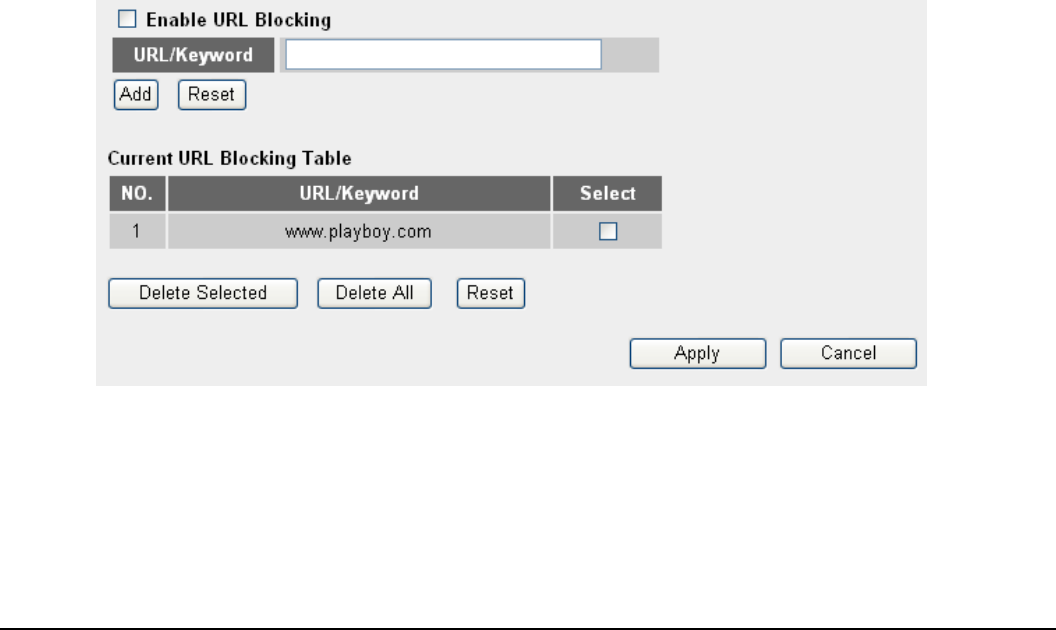
User’s Manual 73
Port Range:
Please input the port range of new service here. If you want to specify port 80 to 90, please
input ’80-90’; if you want to apply this rule on a single port, just input the port number, like
‘80’.
Add:
When you finish with all settings, please click ‘Add’ to save settings, you’ll be brought back
to previous menu, and the rule you just set will appear in current IP filtering table.
If you want to remove all settings in this page, click ‘Reset’ button.
URL Blocking
If you want to prevent computers in local network from accessing certain website (like
pornography, violence, or anything you want to block), you can use this function to stop
computers in local network from accessing the site you defined here.
This function is useful for parents and company managers.
Please follow the following instructions to set URL blocking parameters:
Please click ‘Firewall’ menu on the left of web management interface, then click ‘URL
Blocking’, and the following message will be displayed on your web browser:
Enable URL Blocking:
Check this box to enforce URL Blocking, uncheck it to disable URL Blocking.
URL/Keyword:
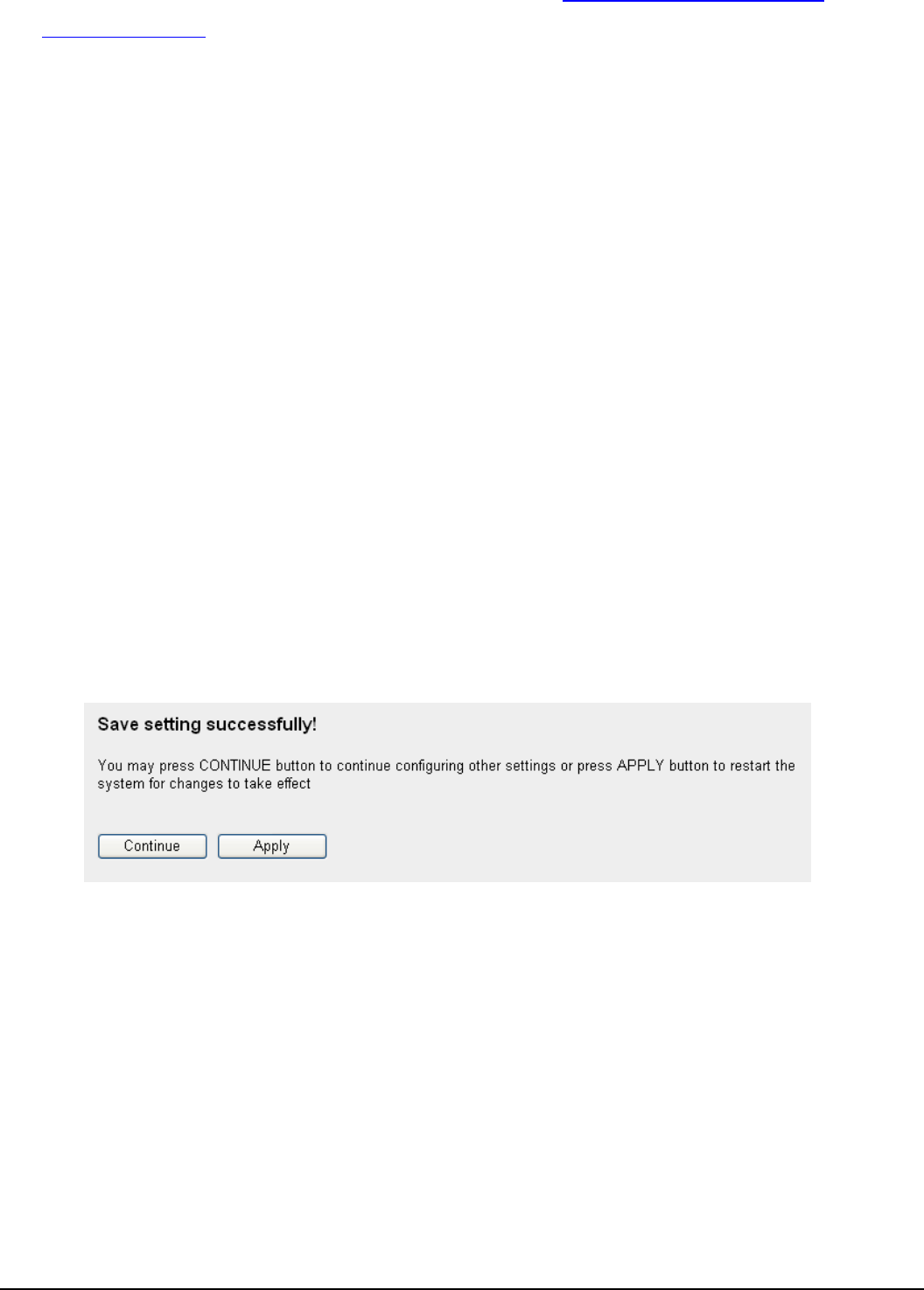
User’s Manual 74
Input the URL (host name or IP address of website, like http://www.blocked-site.com or
http://11.22.33.44), or the keyword which is contained in URL (like pornography, cartoon,
stock, or anything).
Add:
Click ‘Add’ button to add the URL / keyword to the URL / Keyword filtering table.
Reset:
Click ‘Reset’ to remove the value you inputted in URL/Keyword field.
Current URL Blocking Table:
All existing URL/Keywords in filtering table will be listed here.
Delete Selected:
If you want to delete a specific URL/Keyword entry, check the ‘select’ box of the MAC
address you want to delete, then click ‘Delete Selected’ button. (You can select more than
one MAC addresses).
Delete All:
If you want to delete all URL/Keyword listed here, please click ‘Delete All’ button.
Reset:
You can also click ‘Reset’ button to unselect all URL/Keywords.
After you finish with all settings, please click ‘Apply’ button, and the following message will
be displayed on your web browser:
Please click ‘Continue’ to back to previous setup menu; to continue on other setup
procedures, or click ‘Apply’ to reboot the router so the settings will take effect (Please wait
for about 30 seconds while router is rebooting).
If you want to reset all settings in this page back to previously-saved value, please click
‘Cancel’ button.
DoS Attack Prevention
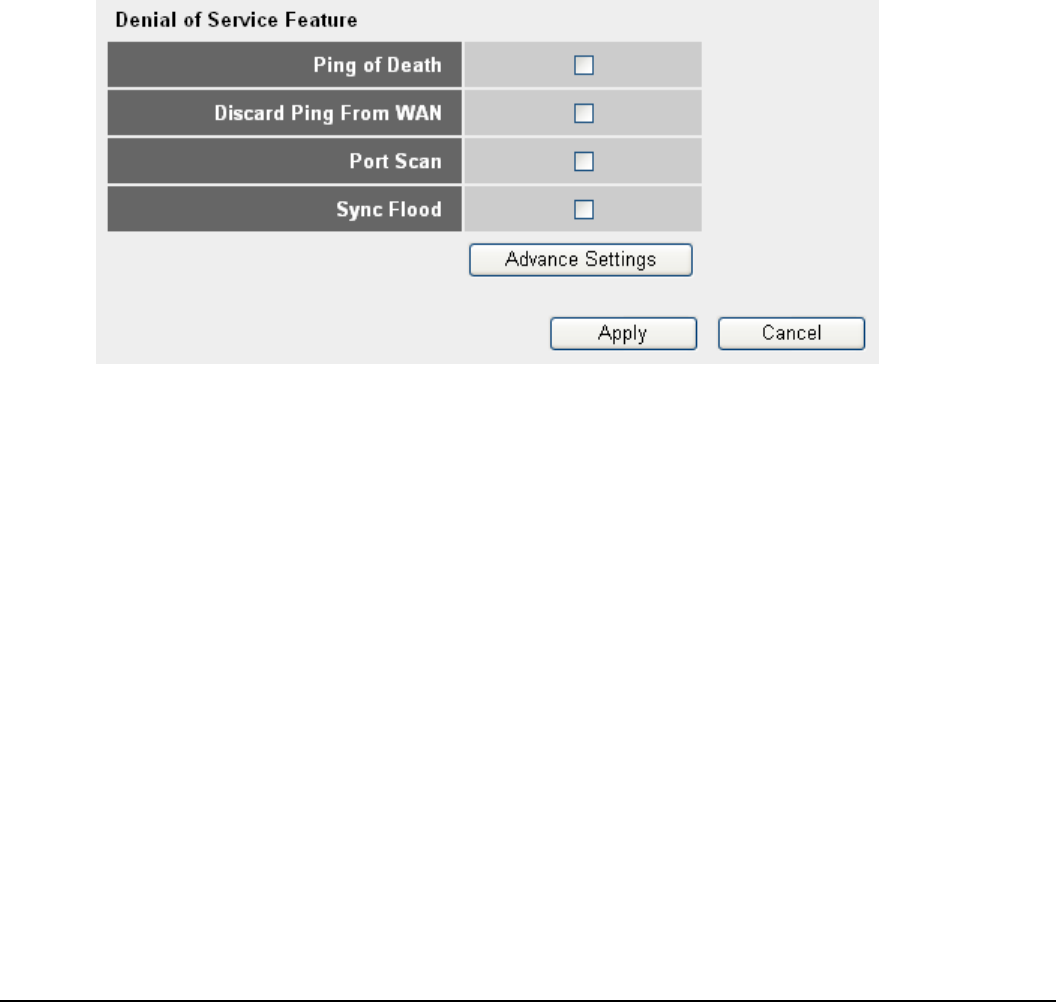
User’s Manual 75
Denial of Service (DoS) is a common attack measure, by transmitting a great amount of
data or request to your Internet IP address and server, the Internet connection will become
very slow, and server may stop responding because it is not capable to handle too much
traffics.
This router has a built-in DoS attack prevention mechanism; when you activate it, the router
will stop the DoS attack for you.
Please follow the following instructions to set DoS prevention parameters:
Please click ‘Firewall’ menu on the left of web management interface, then click ‘DoS’, and
the following message will be displayed on your web browser:
Ping of Death:
Ping of Death is a special packet, and it will cause certain computer to stop responding.
Check this box and the router will filter this kind of packet out.
Discard Ping From WAN:
Ping is a common and useful tool to know the connection status of a specified remote
network device, but some malicious intruder will try to fill your network bandwidth with a lot
of PING request data packet, to make your internet connection become very slow, even
unusable. Check this box and the router will ignore all inbound PING request, but when you
activate this function, you will not be able to ping your own router from internet, too.
Port Scan:
Some malicious intruder will try to use a ‘port scanner’ to know how many ports of your
Internet IP address are open, and they can collect a lot of valuable information by doing so.
Check this box and the router will block all traffics which are trying to scan your Internet IP
address.
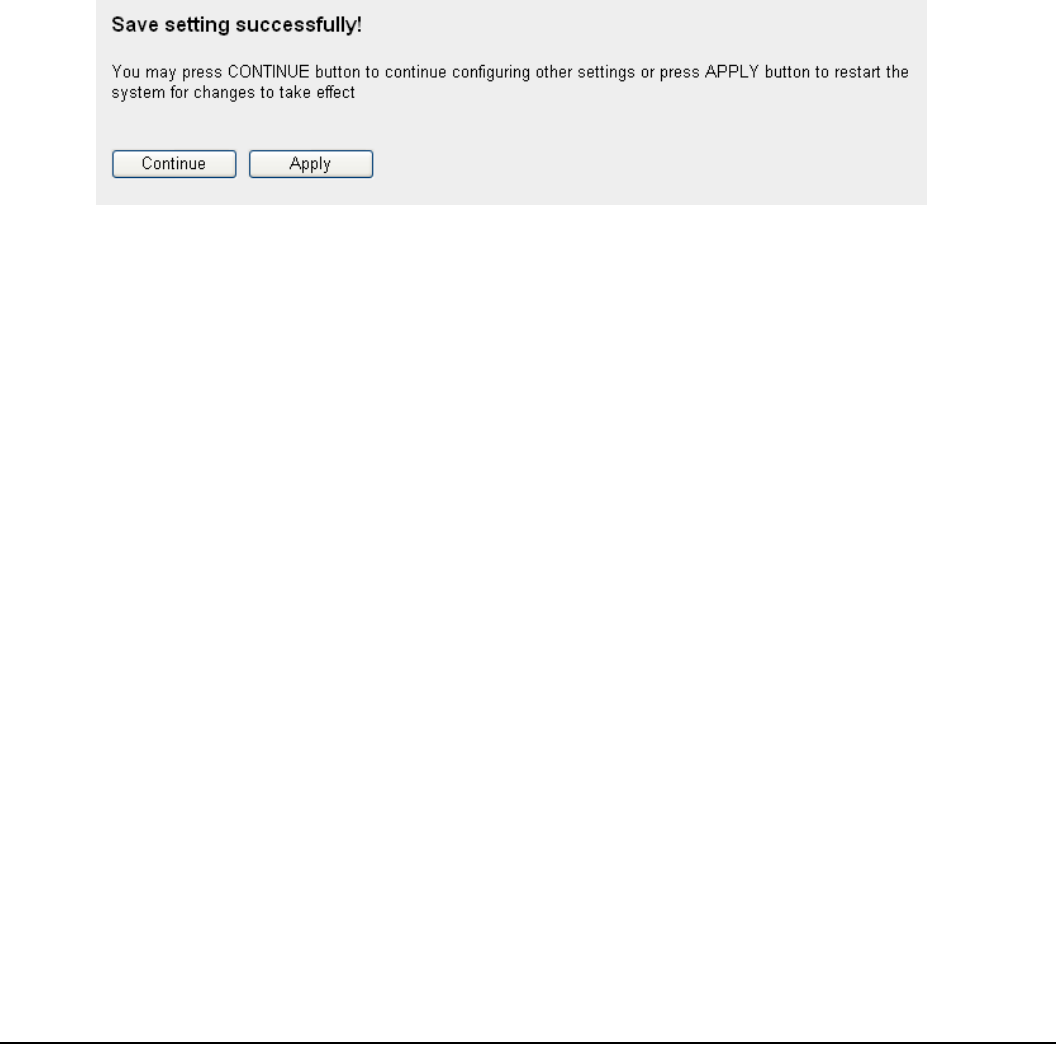
User’s Manual 76
Sync Flood:
This is another kind of attack, which uses a lot of fake connection request to consume the
memory of your server, and try to make your server become unusable. Check this box and
the router will filter this kind of traffic out.
Advanced Settings:
Click this button and you can set advanced settings of the DoS prevention method listed
above, please see section ‘DoS – Advanced Settings’ below.
After you finish with all settings, please click ‘Apply’ button and the following message will
be displayed on your web browser:
Please click ‘Continue’ to back to previous setup menu; to continue on other setup
procedures, or click ‘Apply’ to reboot the router so the settings will take effect (Please wait
for about 30 seconds while router is rebooting).
If you want to reset all settings in this page back to previously-saved value, please click
‘Cancel’ button.
DoS - Advanced Settings
When you click ‘Advanced’ button in DoS menu, the following message will be displayed on
your web browser:
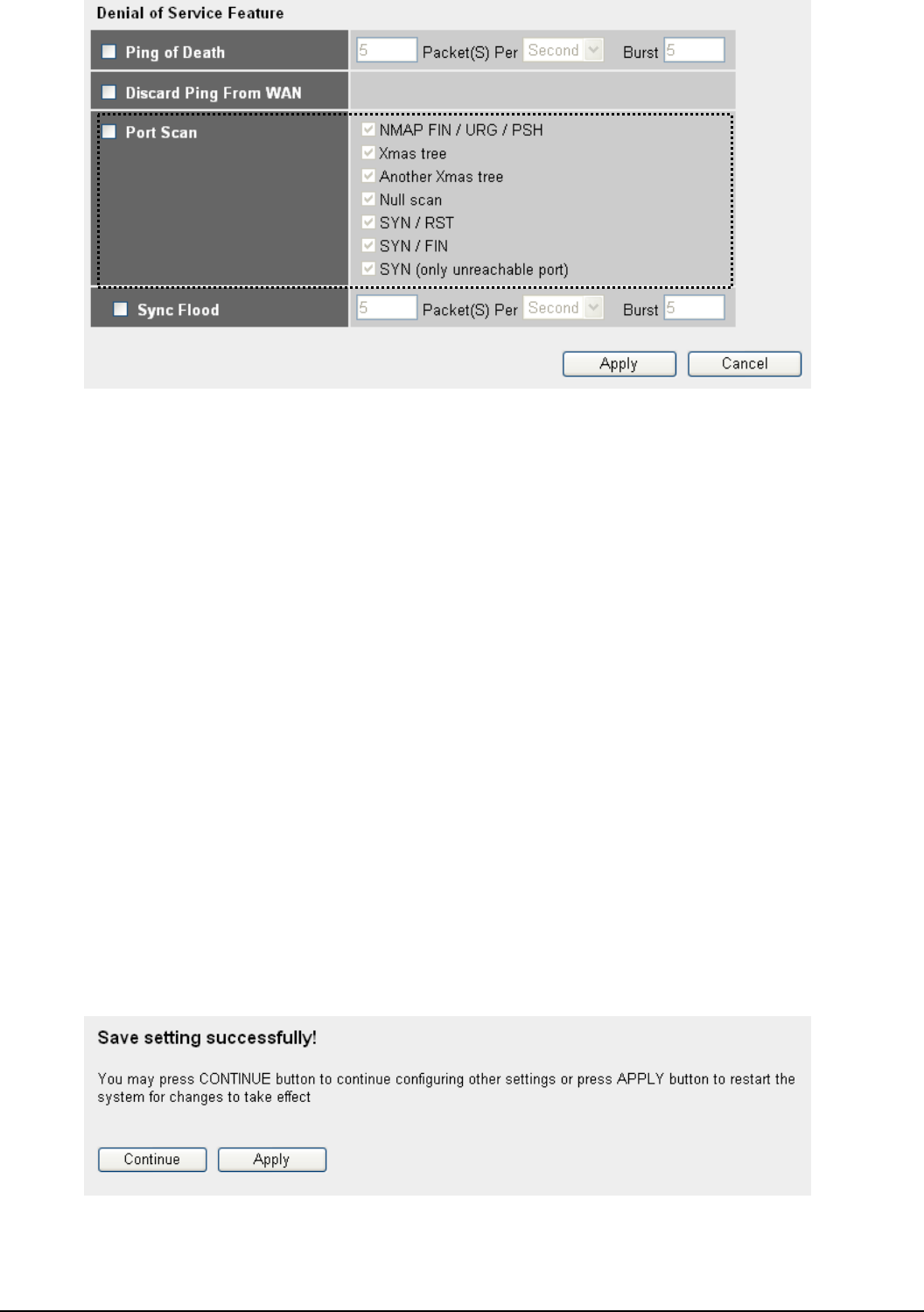
User’s Manual 77
Ping of Death:
Set the threshold of when this DoS prevention mechanism will be activated. Please check
the box of Ping of Death, and input the frequency of threshold (how many packets per
second, minute, or hour), you can also input the ‘Burst’ value, which means when this
number of ‘Ping of Death’ packet is received in very short time, this DoS prevention
mechanism will be activated.
Discard Ping From WAN:
Check the box to activate this DoS prevention mechanism.
Port Scan:
Many kind of port scan methods are listed here, please check one or more DoS attack
methods you want to prevent.
Sync Flood:
Like Ping of Death, you can set the threshold of when this DoS prevention mechanism will
be activated.
After you finish with all settings, please click ‘Apply’ button and the following message will
be displayed on your web browser:
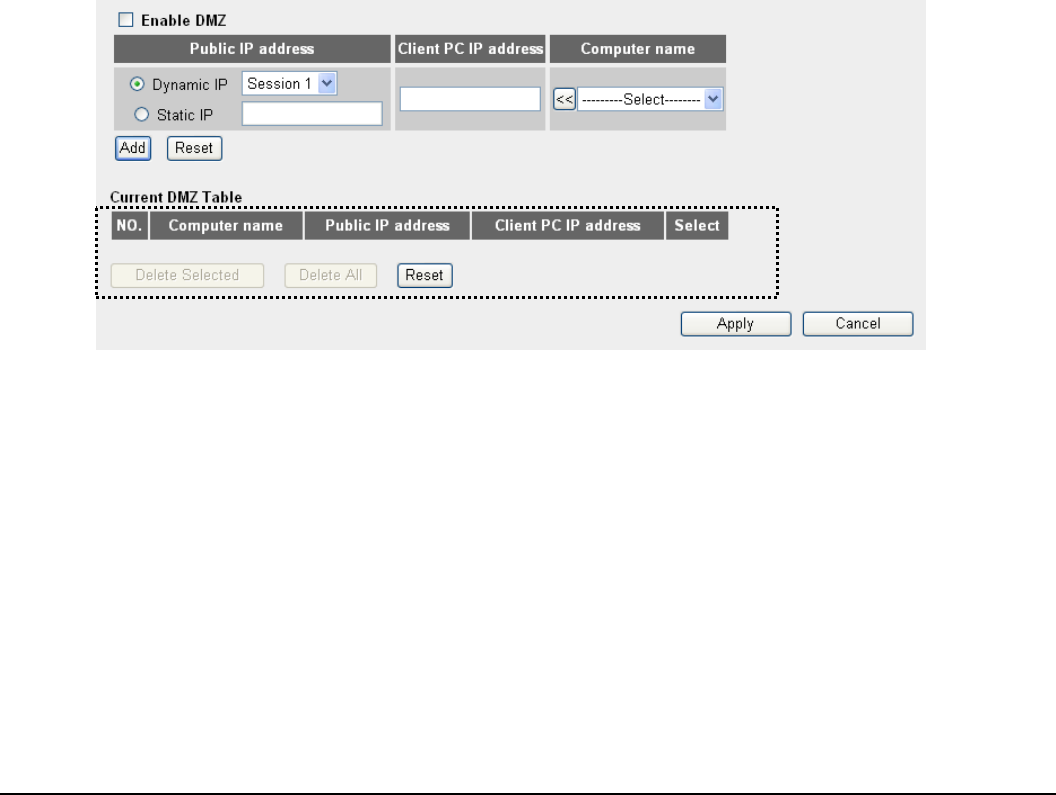
User’s Manual 78
Please click ‘Continue’ to back to previous setup menu; to continue on other setup
procedures, or click ‘Apply’ to reboot the router so the settings will take effect (Please wait
for about 30 seconds while router is rebooting).
If you want to reset all settings in this page back to previously-saved value, please click
‘Cancel’ button.
Demilitarized Zone (DMZ)
Demilitarized Zone (DMZ) refers to a special area in your local network. This area resides
in local network, and all computers in this area uses private IP address, too. But these
private IP addresses are mapped to a certain Internet IP address, so other people on
Internet can fully access those computers in DMZ.
Please follow the following instructions to set DMZ parameters:
Please click ‘Firewall’ menu on the left of web management interface, then click ‘DMZ’, and
the following message will be displayed on your web browser:
Enable DMZ:
Check this box to enable DMZ function, uncheck this box to disable DMZ function.
Public IP address:
You can select ‘Dynamic IP’ or ‘Static IP’ here. If you select ‘Dynamic IP’, you have to
select an Internet connection session from dropdown menu; if you select ‘Static IP’, please
input the IP address that you want to map to a specific private IP address.
Client PC IP address:
Please input the private IP address that the Internet IP address will be mapped to.
Computer Name:
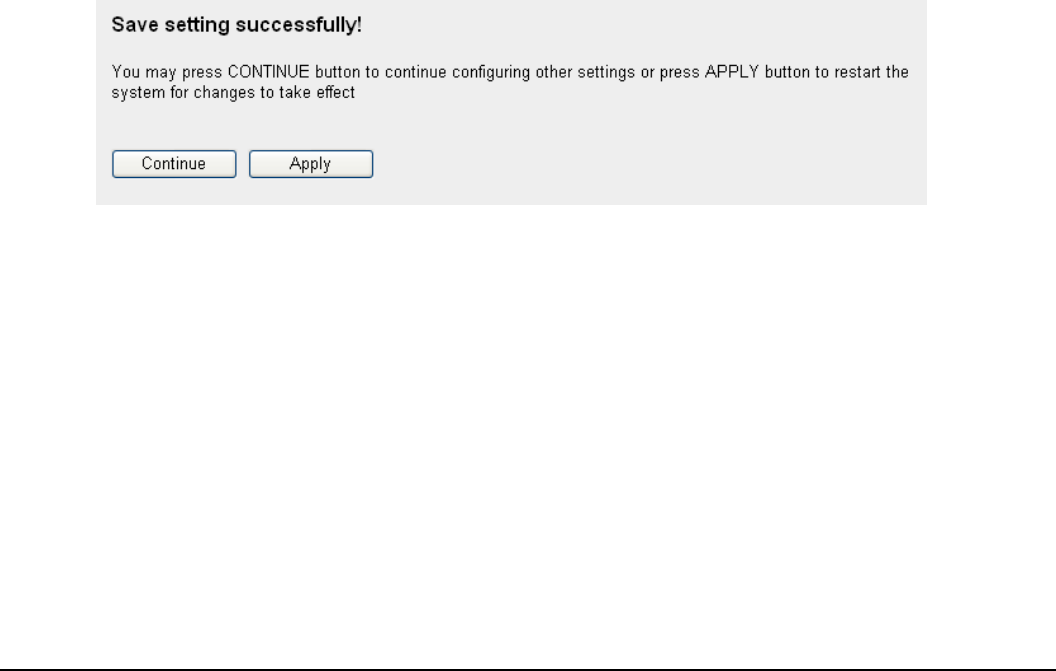
User’s Manual 79
Pull down the menu and all the computers connected to the router will be listed here. You
can easily to select the computer name without checking the IP address of the computer.
Add:
Click ‘Add’ button to add the public IP address and associated private IP address to the
DMZ table.
Reset:
Click ‘Clear’ to remove the value you inputted in Public IP address and Client PC IP
address field.
Current DMZ table:
All existing public IP address and private IP address mapping will be displayed here.
Delete Selected:
If you want to delete a specific DMZ entry, check the ‘select’ box of the DMZ entry you want
to delete, then click ‘Delete Selected’ button. (You can select more than one DMZ entries).
Delete All:
If you want to delete all DMZ entries listed here, please click ‘Delete All’ button.
Reset:
You can also click ‘Reset’ button to unselect all DMZ entries.
After you finish with all settings, please click ‘Apply’ button and the following message will
be displayed on your web browser:
Please click ‘Continue’ to back to previous setup menu; to continue on other setup
procedures, or click ‘Apply’ to reboot the router so the settings will take effect (Please wait
for about 30 seconds while router is rebooting).
If you want to reset all settings in this page back to previously-saved value, please click
‘Cancel’ button.
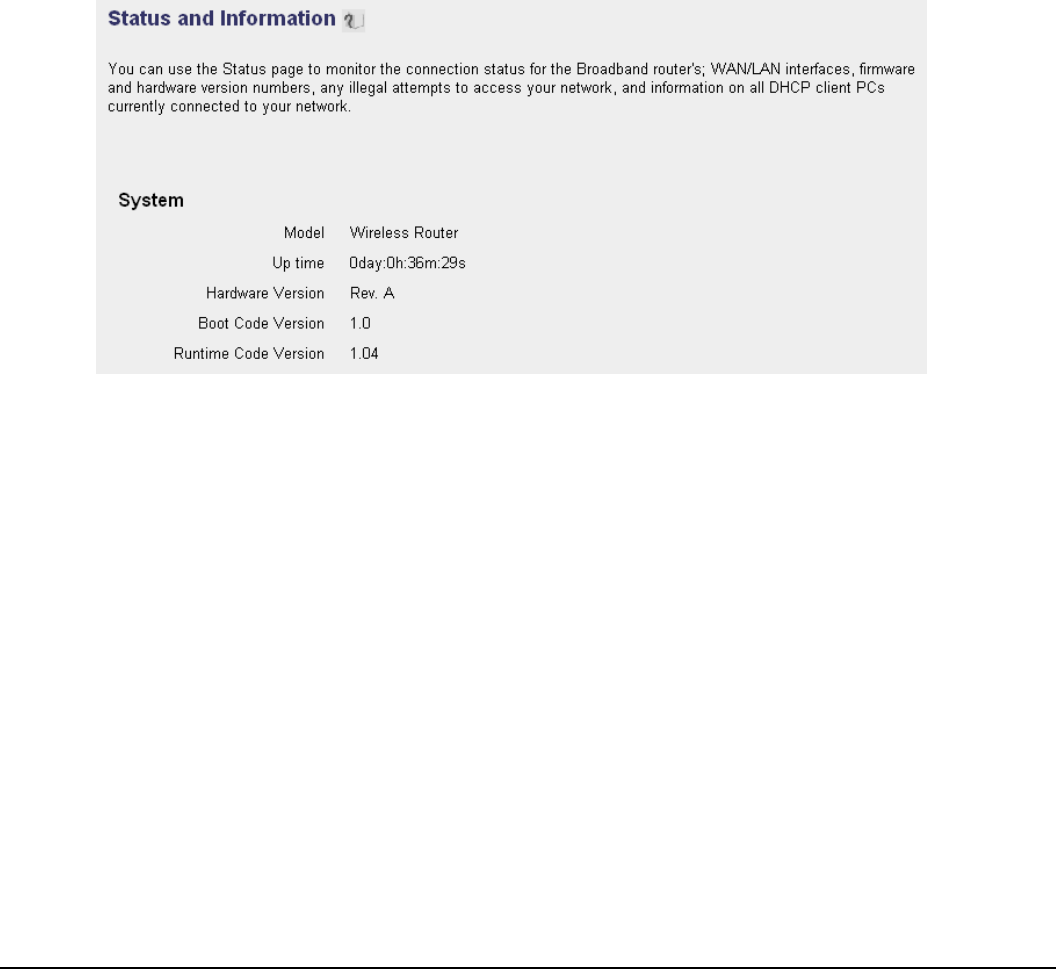
User’s Manual 80
4.9 System Status
The functions described here will provide you with system related information. To enter
system status menu, please either click ‘Status’ link located at the upper-right corner of
web management interface, or click ‘Status’ button in main menu.
System information and firmware version
You can use this function to know the system information and firmware version of this
router.
Please click ‘Status’ link located at the upper-right corner of web management interface,
and the following message will be displayed on your web browser
NOTE: Information displayed here may vary.
Internet Connection Status
You can use this function to know the status of current Internet connection.
Please click ‘Internet Connection’ menu on the left of web management interface, and the
following message will be displayed on your web browser:
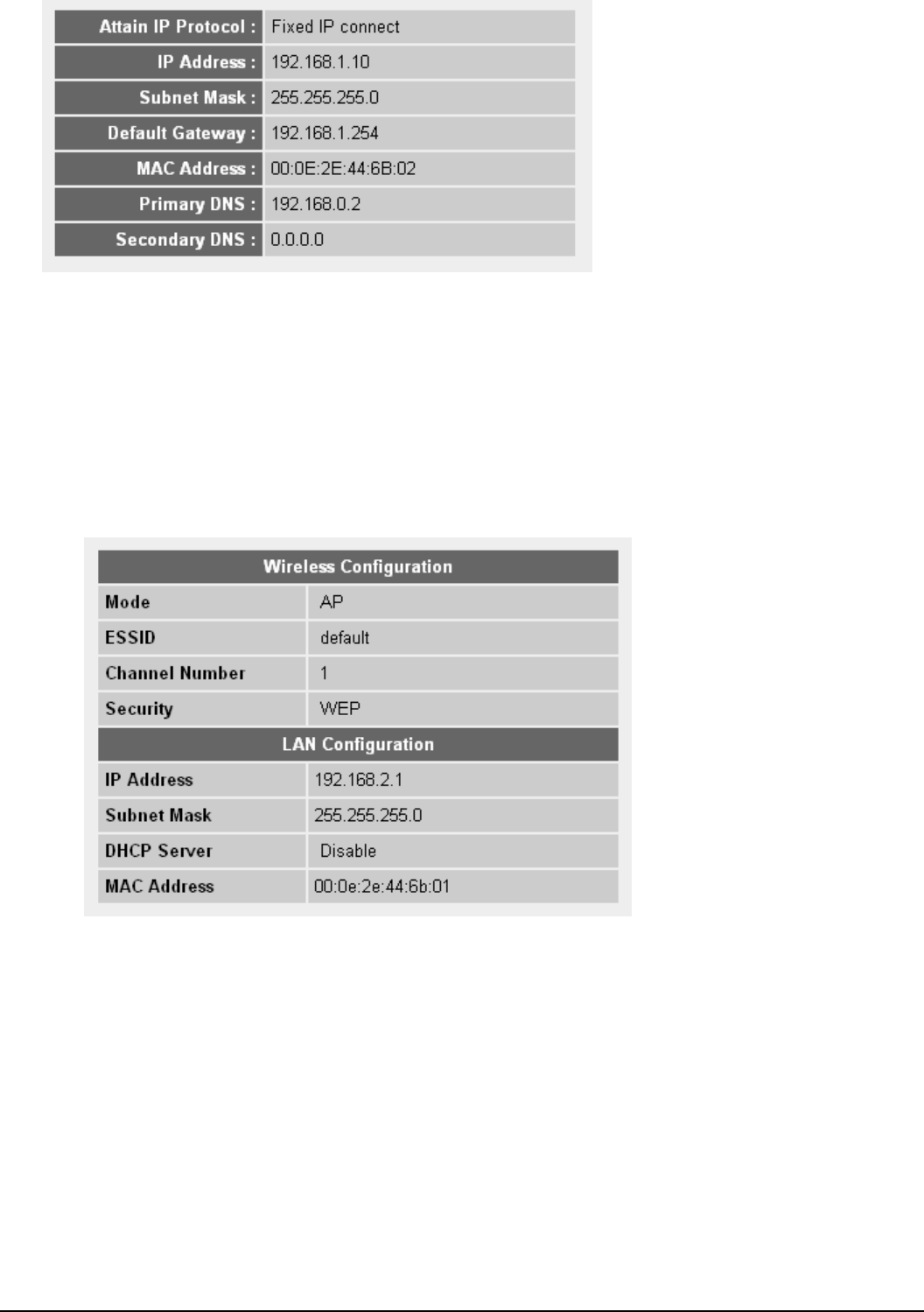
User’s Manual 81
This information will vary depending on the connection status.
Device Status
You can use this function to know the status of your router.
Please click ‘Device Status’ menu on the left of web management interface, and the
following message will be displayed on your web browser:
This information will vary depending on the device status.
System Log
All important system events are logged. You can use this function to check the event log of
your router.
Please click ‘System Log’ menu on the left of web management interface, and the following
message will be displayed on your web browser:
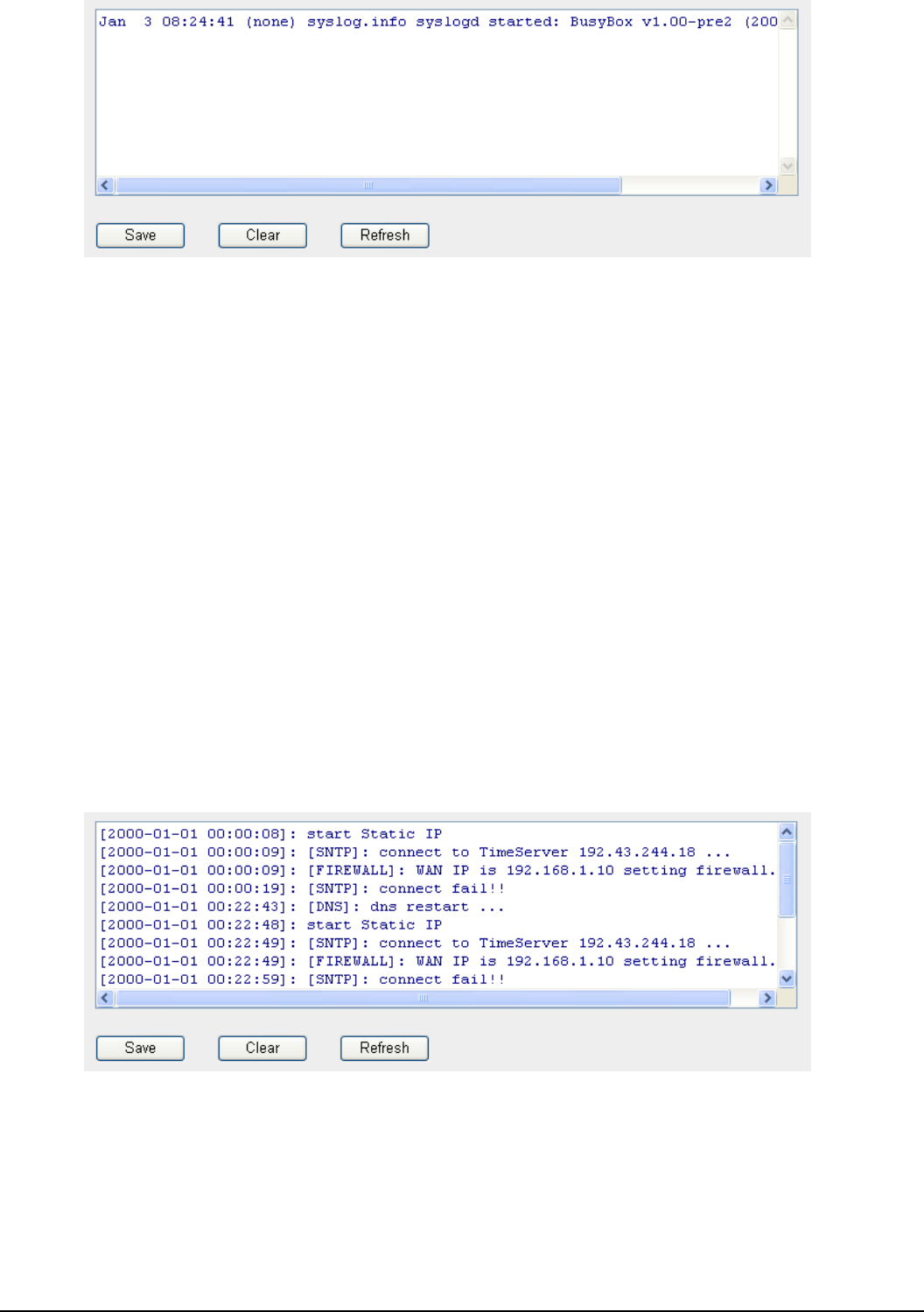
User’s Manual 82
The system events will be displayed in this page, and here are descriptions of every
buttons:
Save:
Save current event log to a text file.
Clear:
Delete all event logs displayed here.
Refresh:
Refresh the event log display.
Security Log
All information about network and system security is kept here, and you can use this
function to check the security event log of your router.
Please click ‘Security Log’ menu on the left of web management interface, and the
following message will be displayed on your web browser:
The system events will be displayed in this page, and here are descriptions of every
buttons:
Save:
Save current event log to a text file.
Clear:
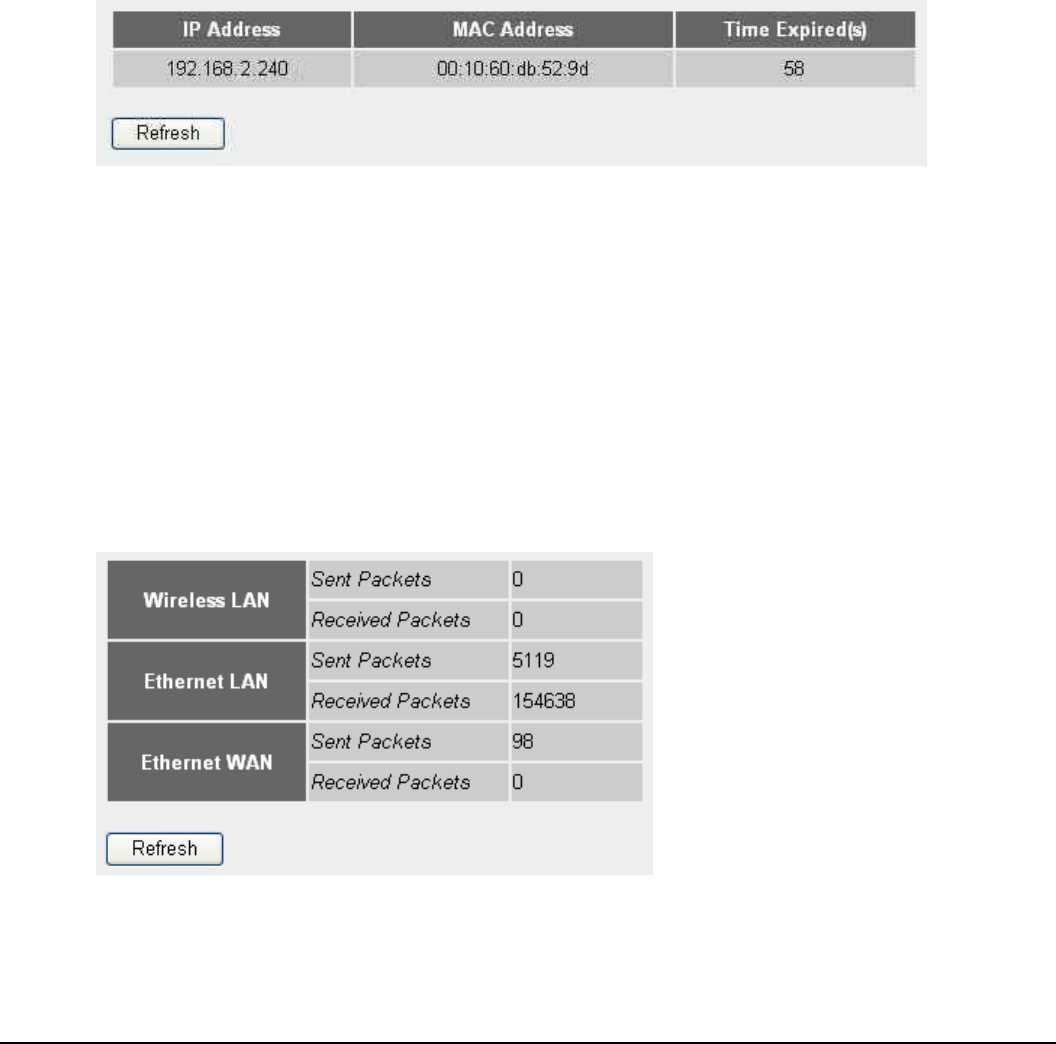
User’s Manual 83
Delete all event logs displayed here.
Refresh:
Refresh the event log display.
Active DHCP client list:
If you’re using the DHCP server function of this router, you can use this function to check
all active DHCP leases issued by this router.
Please click ‘Active DHCP client’ menu on the left of web management interface, and the
following message will be displayed on your web browser:
All information about active DHCP leases issued by this router will be displayed here. You
can click ‘Refresh’ button to display latest information.
Statistics:
You can use this function to check the statistics of wireless, LAN, and WAN interface of this
router.
Please click ‘Statistics’ menu on the left of web management interface, and the following
message will be displayed on your web browser:
You can click ‘Refresh’ button to display latest information
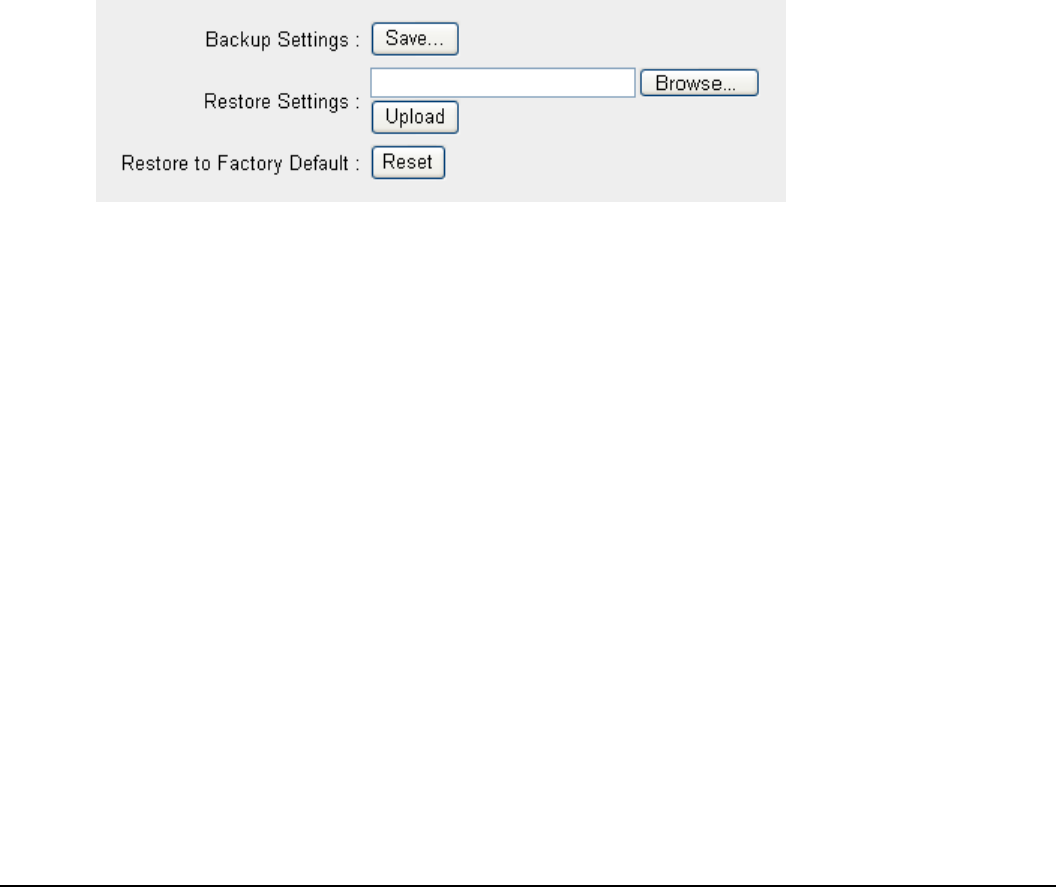
User’s Manual 84
4.10 Tools Settings
The Tools Settings section includes the basic configuration tools, such as Save, Restore
Configuration Settings, and Upgrade Firmware.
Configuration Backup and Restore
You can backup all configurations of this router to a file, so you can make several copied of
router configuration for security reason.
To backup or restore router configuration, please follow the following instructions:
Please click ‘Tool’ located at the upper-right corner of web management interface, then
click ‘Configuration Tools’ on the left of web management interface, then the following
message will be displayed on your web browser:
Backup Settings:
Press ‘Save...’ button, and you’ll be prompted to download the configuration as a file,
default filename is ‘config.bin’, you can save it as another filename for different versions,
and keep it in a safe place.
Restore Settings:
Press ‘Browse…’ to pick a previously-saved configuration file from your computer, and then
click ‘Upload’ to transfer the configuration file to router. After the configuration is uploaded,
the router’s configuration will be replaced by the file you just uploaded.
Restore to Factory Default:
Click this button to remove all settings you made, and restore the configuration of this
router back to factory default settings.
Firmware Upgrade
The system software used by this router is called as ‘firmware’, just like any applications on
your computer, when you replace the old application with a new one; your computer will be

User’s Manual 85
equipped with new function. You can also use this firmware upgrade function to add new
functions to your router, even fix the bugs of this router.
To upgrade firmware, please follow the following instructions:
Please click ‘Tool’ located at the upper-right corner of web management interface, then
click ‘Firmware Upgrade’ on the left of web management interface, then the following
message will be displayed on your web browser:
Please click ‘Next’, and the following message will be displayed:
Click ‘Browse’ button first, you’ll be prompted to provide the filename of firmware upgrade
file. Please download the latest firmware file from our website, and use it to upgrade your
router.
After a firmware upgrade file is selected, click ‘Apply’ button, and the router will start
firmware upgrade procedure automatically. The procedure may take several minutes,
please be patient.
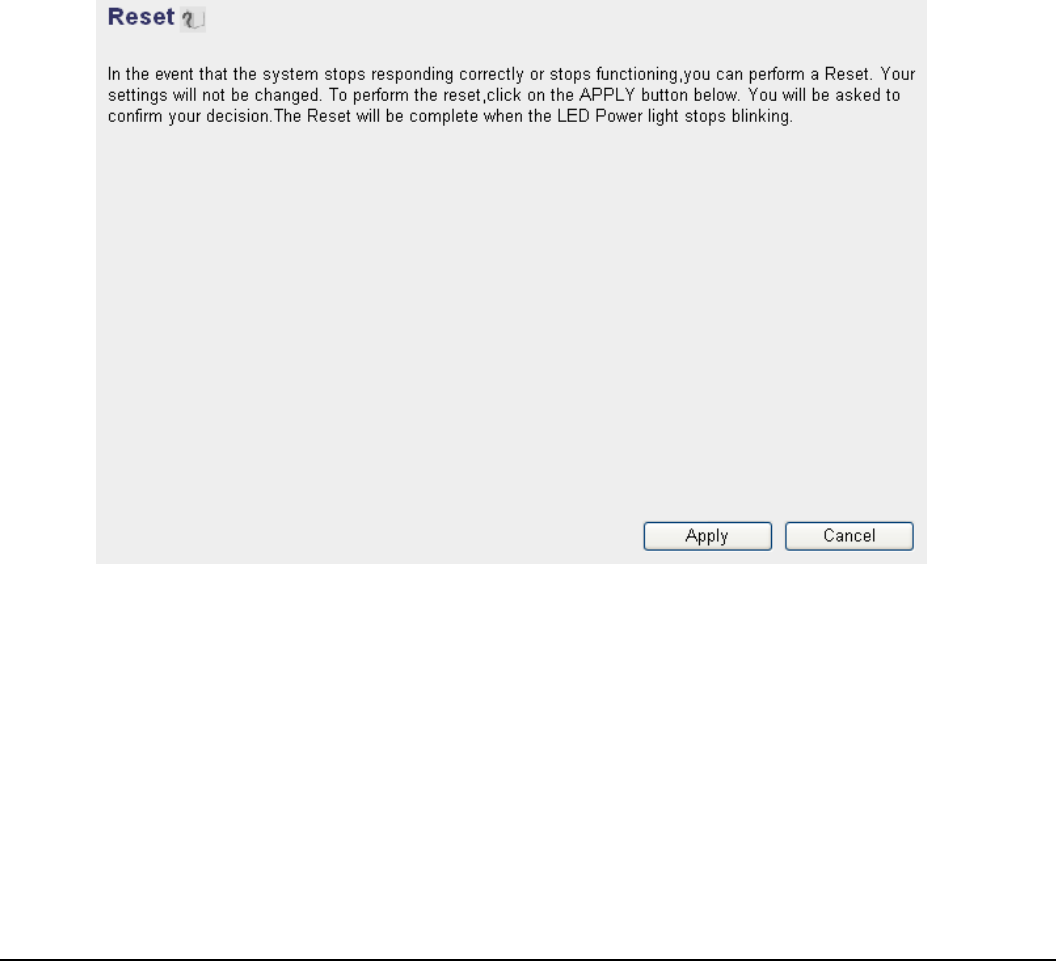
User’s Manual 86
NOTE: Never interrupt the upgrade procedure by closing the web browser or
physically disconnect your computer from router. If the firmware you uploaded is
corrupt, the firmware upgrade will fail, and you may have to return this router to the
dealer of purchase to ask for help. (Warranty voids if you interrupted the upgrade
procedure).
System Reset
If you think the network performance is bad, or you found the behavior of the router is
strange, you can perform a router reset, sometime it will solve the problem.
To do so, please click ‘Tool’ located at the upper-right corner of web management interface,
then click ‘Reset’ on the left of web management interface, then the following message will
be displayed on your web browser:
Please click ‘Apply’ to reset your router, and it will be available again after few minutes,
please be patient.

User’s Manual 87
5. Troubleshooting – Q & A
1. Router is not responding to me when I want to access it by web browser.
Answer:
1. Please check the connection of power cord and network cable of this router. All cords
and cables should be correctly and firmly inserted to the router.
2. If all LEDs on this router are off, please check the status of A/C power adapter, and
make sure it’s correctly powered.
3. You must use the same IP address section which router uses.
4. Are you using MAC or IP address filter? Try to connect the router by another computer
and see if it works; if not, please restore your router to factory default settings
(pressing ‘reset’ button for over 10 seconds).
5. Set your computer to obtain an IP address automatically (DHCP), and see if your
computer can get an IP address.
6. If you did a firmware upgrade and this happens, contact your dealer of purchase for
help.
7. If all above solutions don’t work, contact the dealer of purchase for help.
2. Can’t get connected to Internet?
Answer:
1. Go to ‘Status’ -> ‘Internet Connection’ menu, and check Internet connection status.
2. Please be patient, sometime Internet is just that slow.
3. If you connect a computer to Internet directly before, try to do that again, and check if
you can get connected to Internet with your computer directly attached to the device
provided by your Internet service provider.
4. Check PPPoE / L2TP / PPTP user ID and password again.
5. Call your Internet service provide and check if there’s something wrong with their
service.
6. If you just can’t connect to one or more website, but you can still use other internet
services, please check URL/Keyword filter.
7. Try to reset the router and try again later.
8. Reset the device provided by your Internet service provider too.
9. Try to use IP address instead of hostname. If you can use IP address to communicate

User’s Manual 88
with a remote server, but can’t use hostname, please check DNS setting.
3. I can’t locate my router by my wireless client.
Answer:
1. ‘Broadcast ESSID’ set to off?
2. All three antennas are properly secured.
3. Are you too far from your router? Try to get closer.
4. Please remember that you have to input ESSID on your wireless client manually, if
ESSID broadcast is disabled.
4. File download is very slow or breaks frequently?
Answer:
1. Are you using QoS function? Try to disable it and try again.
2. Internet is slow sometimes, being patient.
3. Try to reset the router and see if it’s better after that.
4. Try to know what computers do on your local network. If someone’s transferring big
files, other people will think Internet is really slow.
5. If this never happens before, call you Internet service provider to know if there is
something wrong with their network.
5. I can’t log onto web management interface: password is wrong
Answer:
1. Make sure you’re connecting to the correct IP address of the router!
2. Password is case-sensitive. Make sure the ‘Caps Lock’ light is not illuminated.
3. If you really forget the password, do a hard reset.
6. Router become hot.
Answer:

User’s Manual 89
1. This is not a malfunction, if you can keep your hand on the router’s case.
2. If you smell something wrong or see the smoke coming out from router or A/C power
adapter, please disconnect the router and A/C power adapter from utility power (make
sure it’s safe before you’re doing this!), and call your dealer of purchase for help.
7. The date and time of all event logs are wrong.
Answer:
Adjust the internal clock of router.

User’s Manual 90
Federal Communication Commission Interference Statement
This equipment has been tested and found to comply with the limits for a Class B digital
device, pursuant to Part 15 of the FCC Rules. These limits are designed to provide
reasonable protection against harmful interference in a residential installation. This
equipment generate, uses and can radiate radio frequency energy and, if not installed and
used in accordance with the instructions, may cause harmful interference to radio
communications. However, there is no guarantee that interference will not occur in a
particular installation. If this equipment does cause harmful interference to radio or television
reception, which can be determined by turning the equipment off and on, the user is
encouraged to try to correct the interference by one of the following measures:
- Reorient or relocate the receiving antenna.
- Increase the separation between the equipment and receiver.
- Connect the equipment into an outlet on a circuit different from that to which the
receiver is connected.
- Consult the dealer or an experienced radio/TV technician for help.
This device complies with Part 15 of the FCC Rules. Operation is subject to the following two
conditions: (1) This device may not cause harmful interference, and (2) this device must
accept any interference received, including interference that may cause undesired operation.
FCC Caution: Any changes or modifications not expressly approved by the party responsible
for compliance could void the user's authority to operate this equipment.
IMPORTANT NOTE:
FCC Radiation Exposure Statement:
This equipment complies with FCC radiation exposure limits set forth for an uncontrolled
environment. This equipment should be installed and operated with minimum distance 20cm
between the radiator & your body.
If this device is going to be operated in 5.15 ~ 5.25GHz frequency range, then it is restricted
in indoor environment only.
This transmitter must not be co-located or operating in conjunction with any other antenna or
transmitter.
The WRTR-168G( FCC ID: RYK-WRTR168G ) is limited in CH1~CH11 for 2.4 GHz by
specified firmware controlled in U.S.A.

User’s Manual 91
EC Declaration of Conformity
Name applicant:
8F., No.257, Sec. 2, Tiding Blvd., Neihu District, Taipei City 11493, Taiwan (R.O.C.)
Hereby declares under sole responsibility that product
Brand name: SparkLAN
Product number: WRTR-168G
Product description: SpeedPlus Wireless-G AP/Router
To which this declaration relates complies with the requirements of the following
standards:
EN 60950-1: 2001+A11:2004
EN 301 489-1 V1.6.1 (2005-09)
EN 301 489-17 V1.2.1 (2002-08)
EN 50385 (2002-08)
EN 300 328 V1.7.1 (2006-10)
This certifies that the designated product as described above complies with the
directives described above and carries the CE marking accordingly.
This declaration has been signed under responsibility of the manufacturer / importer.
Test laboratory: Advanced Data Technology Corporation
Lab Address: No. 47, 14th Ling, Chia Pau Tsuen, Linko Hsiang 244, Taipei Hsien, Taiwan.
ROC
Name manufacturer / importer:
Sparklan Communications, Inc
Aug 31 ,2008 Mike Chen
President
Product article code: WRTR-168G
Product description: SpeedPlus Wireless-G AP/Router
Product manufacturer / importer: Sparklan Communications, Inc.
Countries in which the product as described above may be used freely:
Austra, Belgium, Denmark, Finland, France, Germany, Greece, Iceland, Ireland, Italy,
Luxembourg, Netherlands, Norway, Portugal, Spain, Sweden, Switzerland, UK
Countries where usage of the product as described above is prohibited:
None.
Countries where usage of the product as described below is limited:
France: The use of other channels than the channels 10 through 13 is prohibited by law.